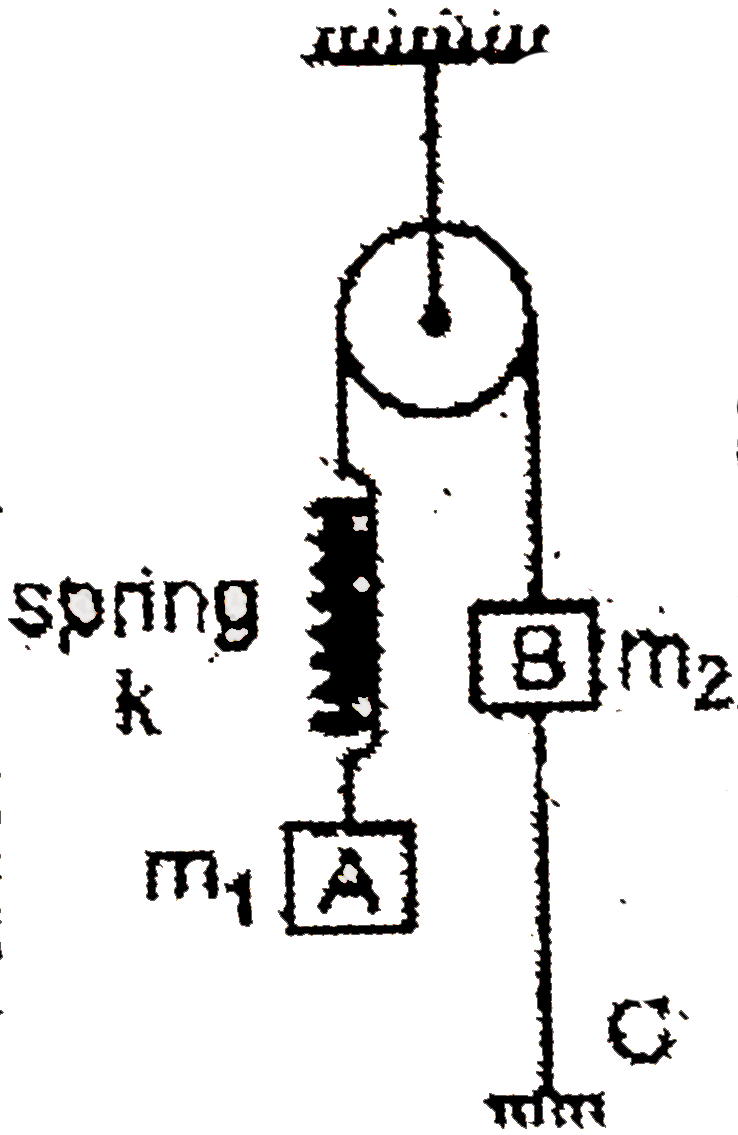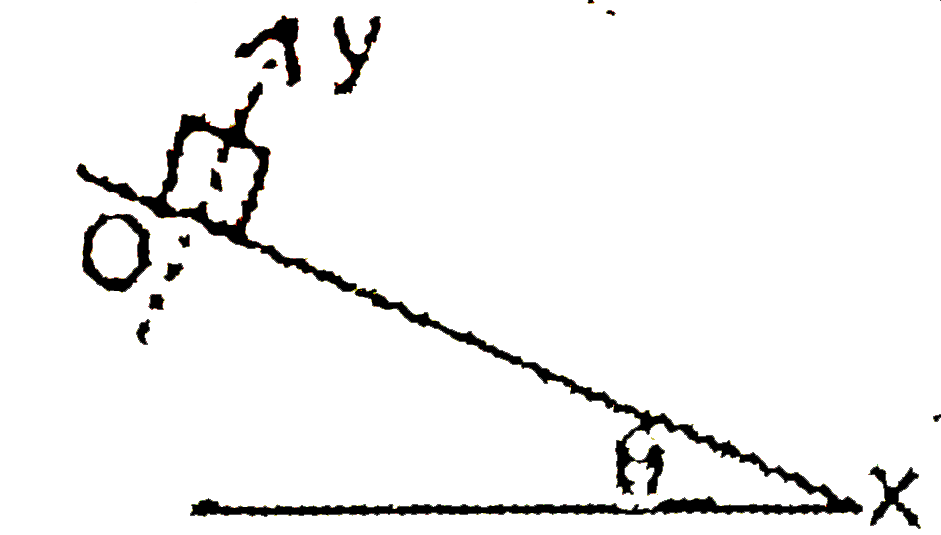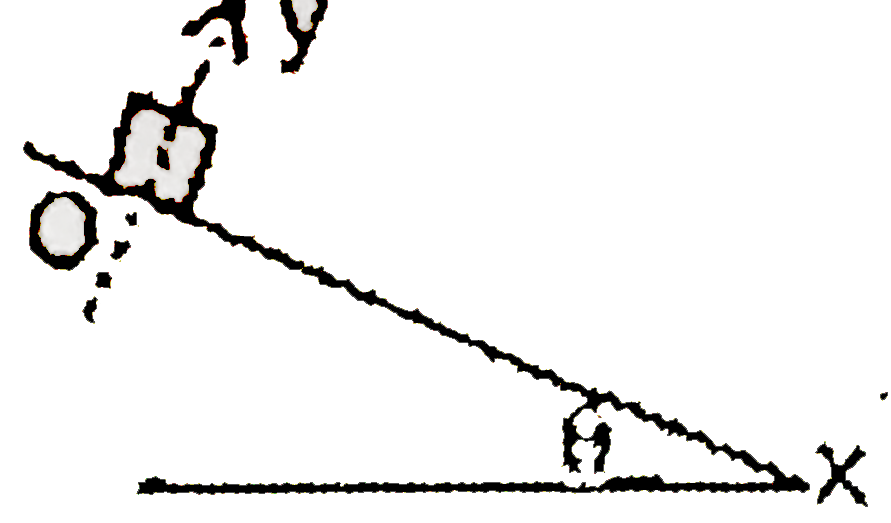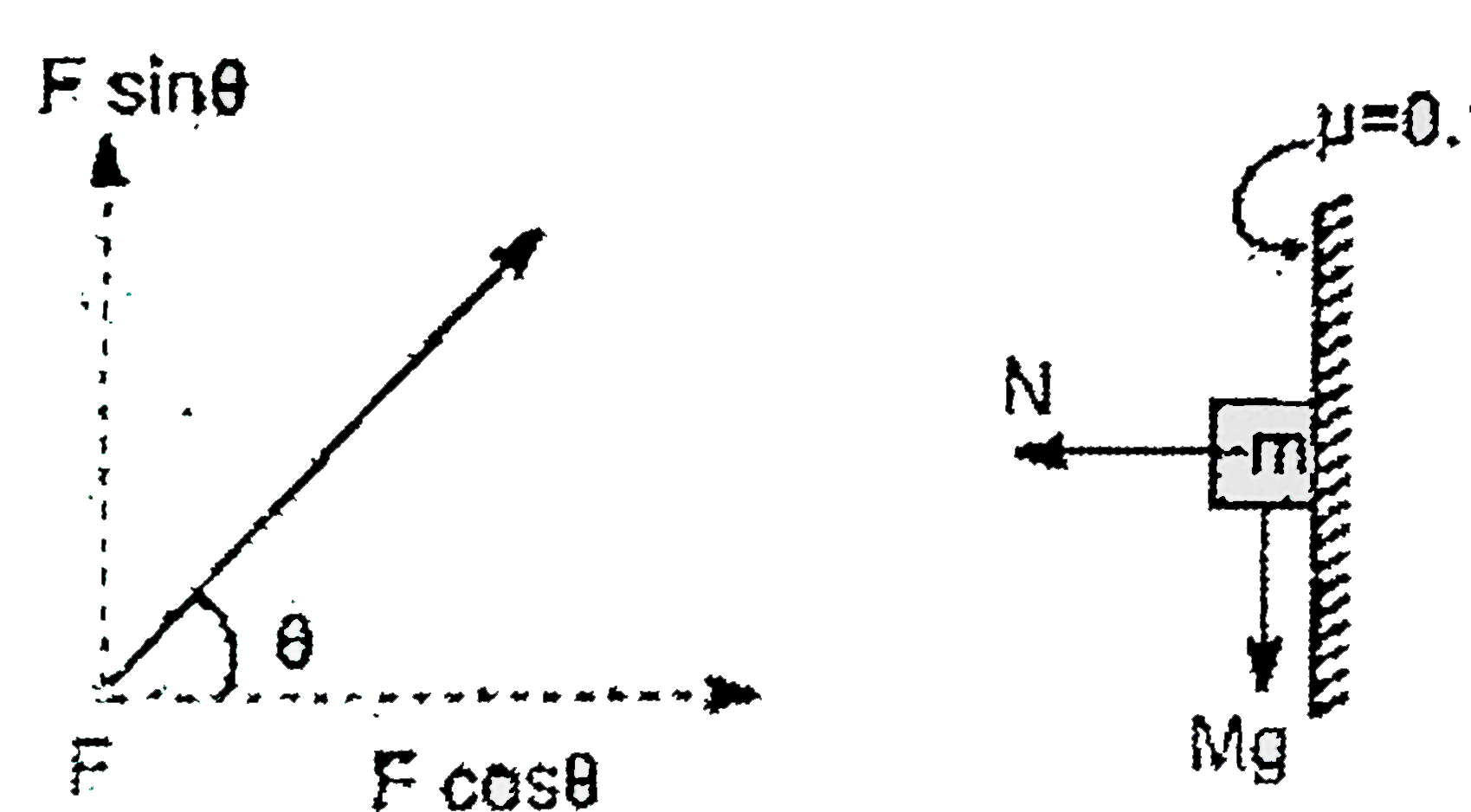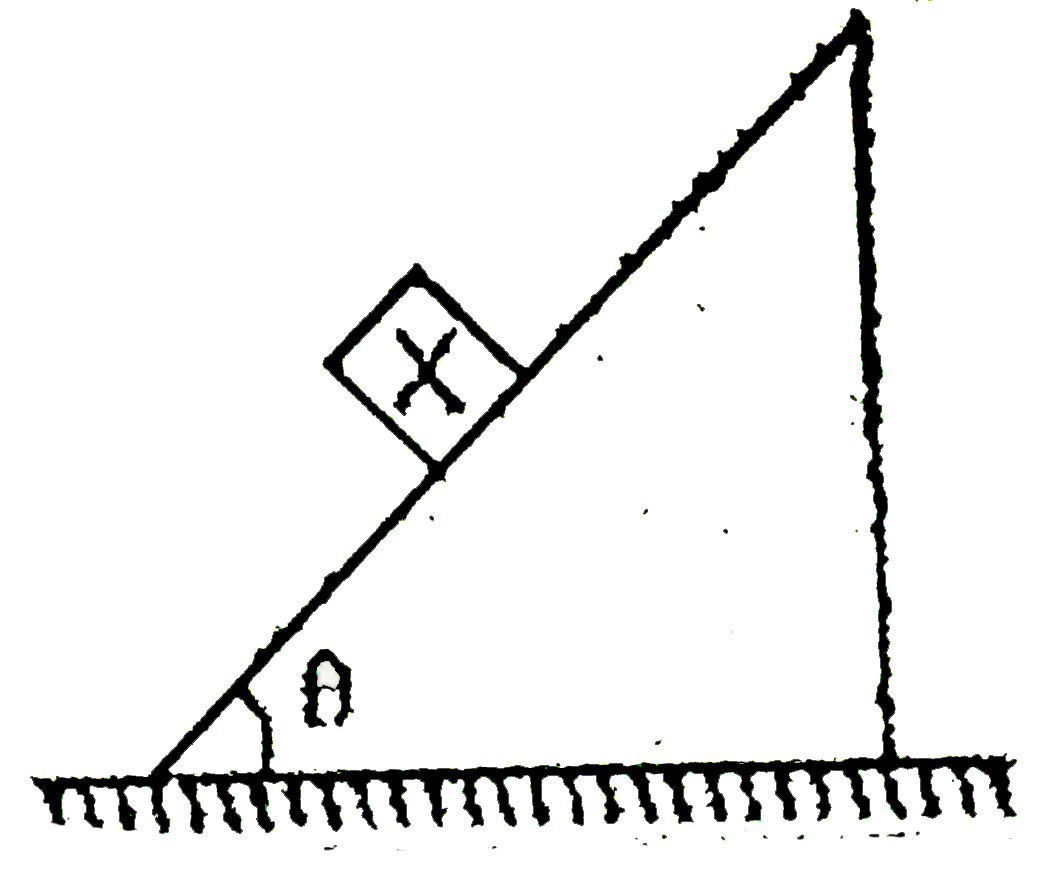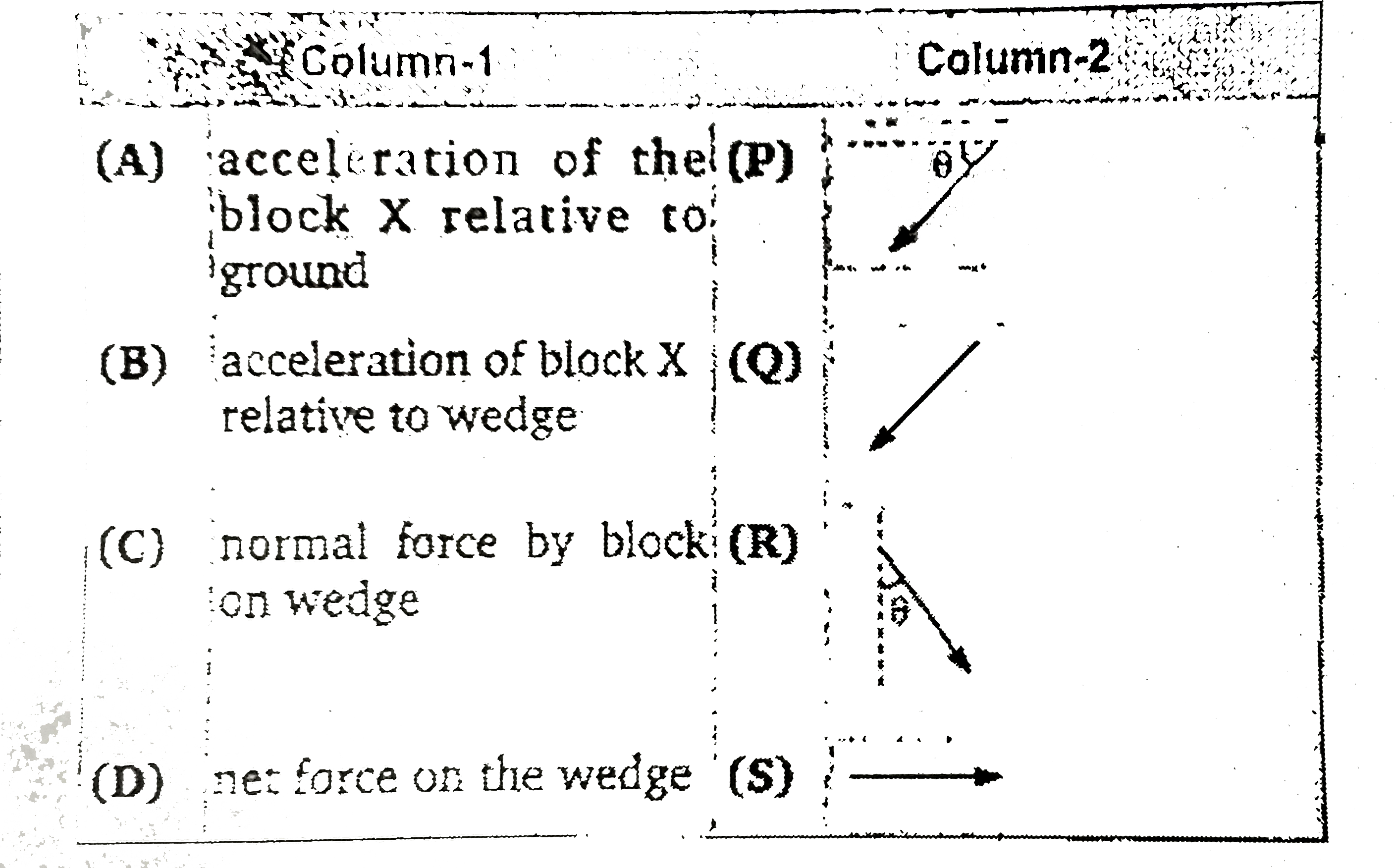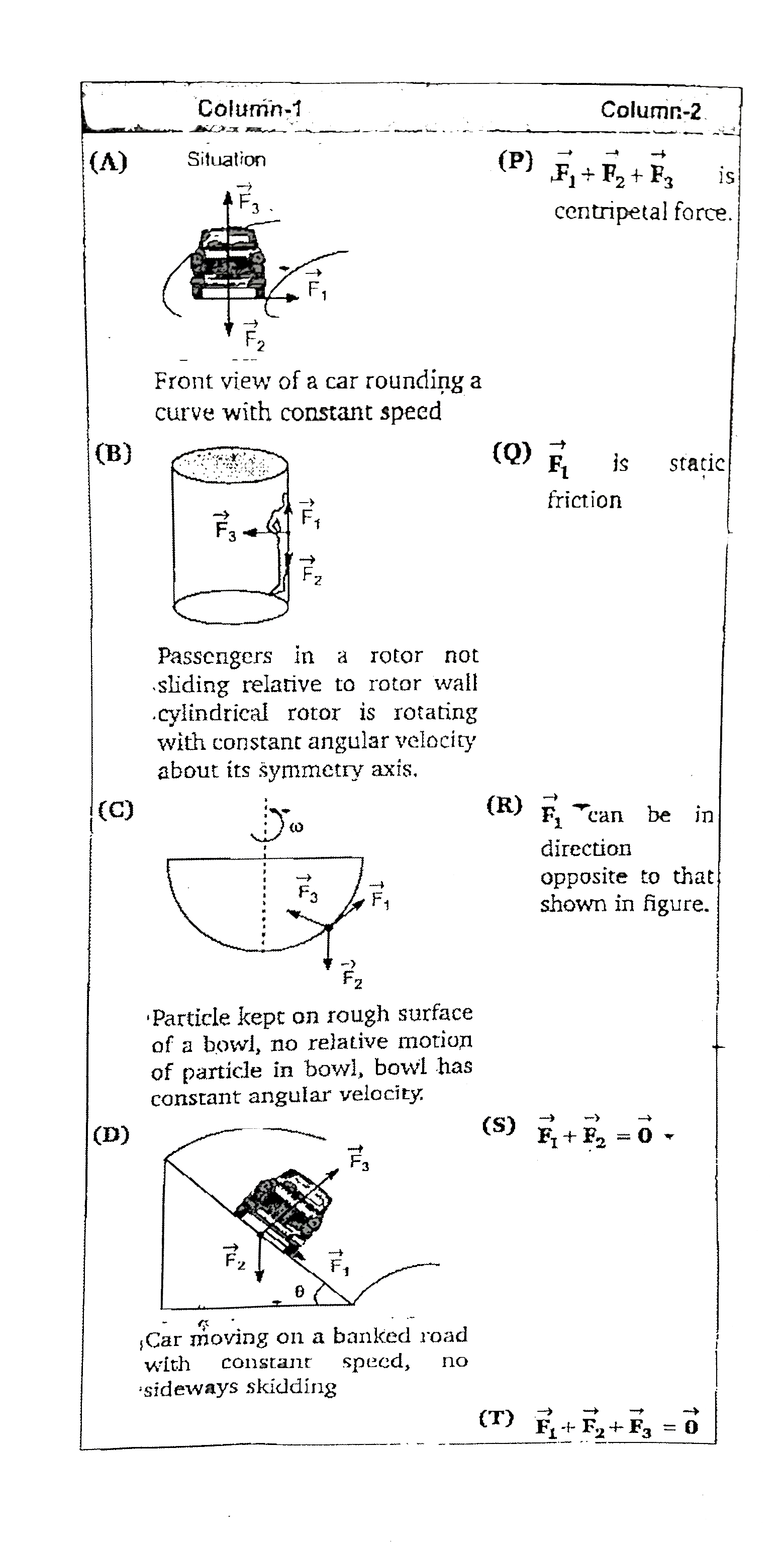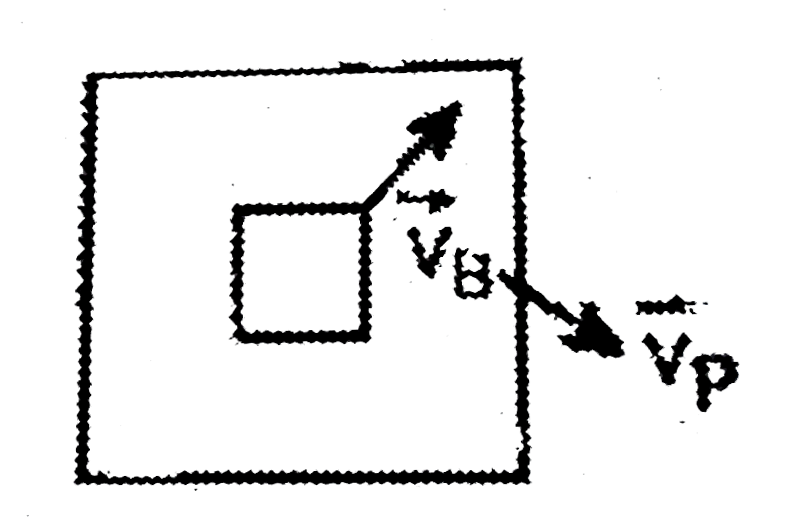Matching type from SHREE BALAJI PHYSICS (HINGLISH) FORCE ANALYSIS for Class 11
| Class 11 | PHYSICS |
| Chapter | FORCE ANALYSIS |
| SHREE BALAJI PHYSICS (HINGLISH) | Matching type |
| Medium | English |
| Academic Year | 2023-2024 |
Question 8
Figure shows a light spring balance connected to two blocks of mass 20 kg each. The graduations in the balance measure the tension in the spring. (A). What is the reading of the balance? (b).Will the reading change if the balance is heavy, say 2.0 kg? (c). What will happen if the spring is light but the blocks the unequal masses?
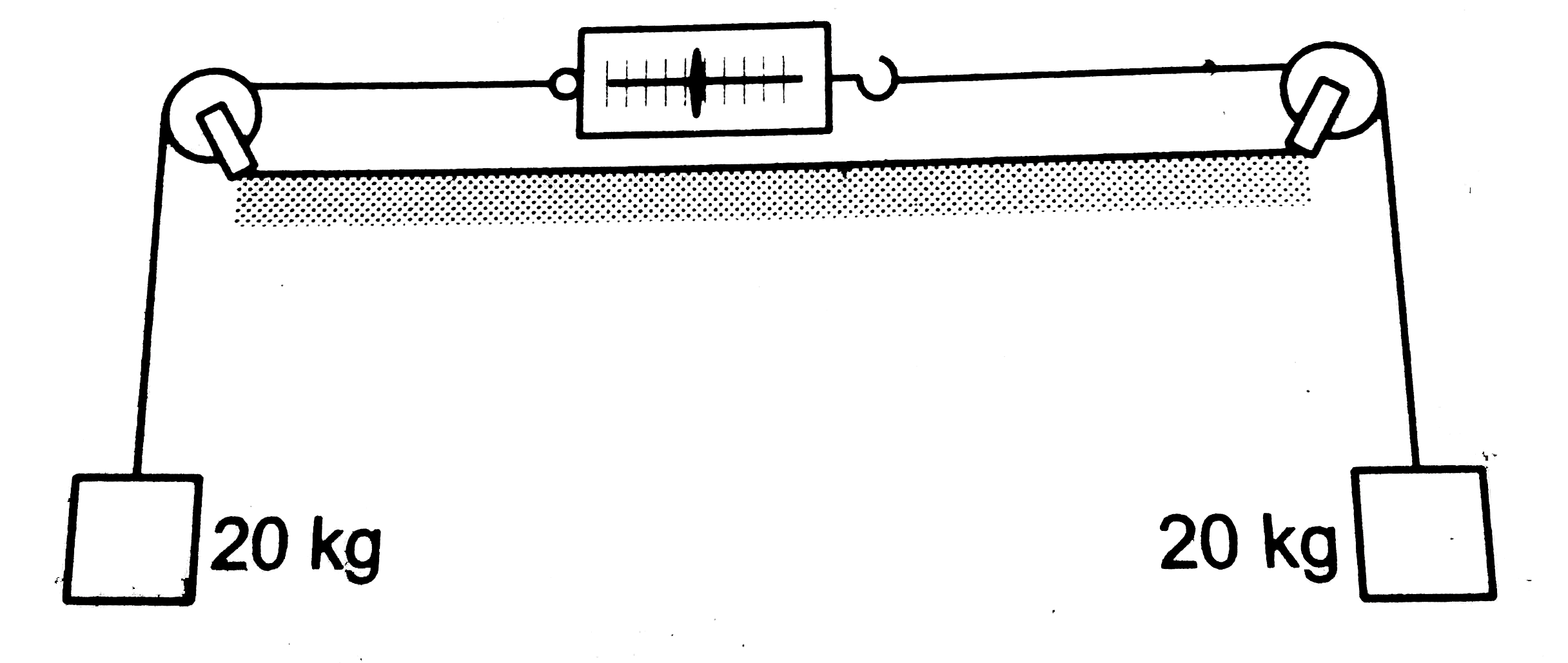 View Solution
View SolutionQuestion 12
A smooth wedge A is fitted in a chamber hanging from a fixed ceiling near the earth's surface.A block B placed at the top of the wedge takes a time T to slide down the length of the wedge. If the block is placed at the top of the wedge and the cable supporting the chamber is broken at the same instant, the block willView SolutionQuestion 16
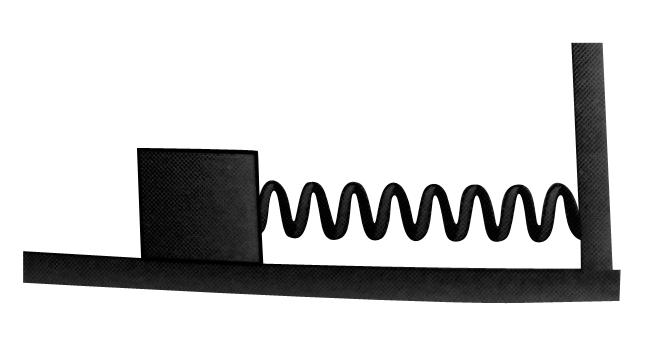
An ideal spring is compressed and placed horizontally between a vertical fixed wall and a block free to slide over a smooth horizontal table to as shown in the figure. The system is released from rest. The graph which represents the relation between the magnitude of acceleration a of the block and the distance x travelled by it (as long as the spring is compressed) isView SolutionQuestion 22
A force →F=→v×→A is exerted on a particle in addition to the force of gravity, where →v is the veocity of the particle and →A is a constant vector in the horizontal direction. With what minimum speed a particle of mass m be projected so that it continues to move undeflected with a constant velocity?View SolutionQuestion 28
Two masses each equal to m are lying on x-axis at (−a,0)(+a,0) respectively as shown in figure They are connected by a light string A force F is applied at the origin along vertical direction As a result the masses move toward each other without loosing contact with ground What is the acceleration of each mass? Assume the instantanceous position of the masses as(−x,0)and (x,0)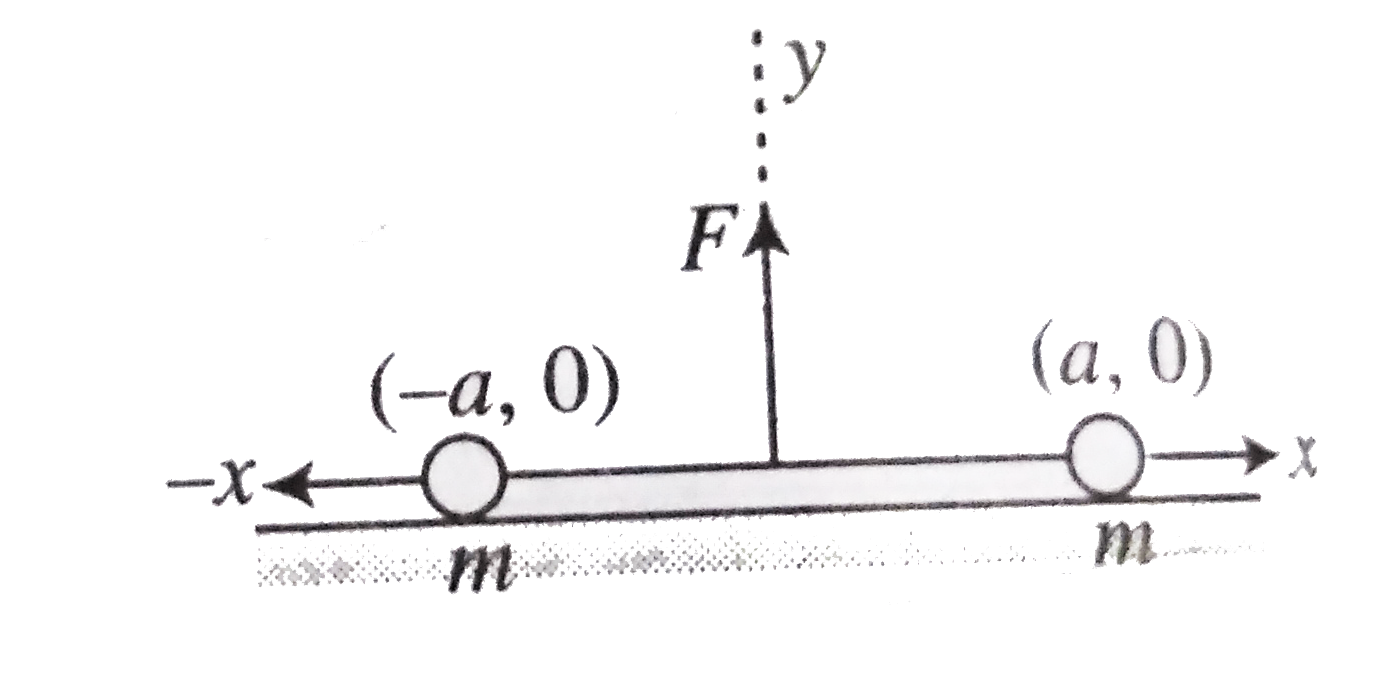 View Solution
View SolutionQuestion 41
An insect crawls up a hemispherical surface very slowly (see the figure). The coefficient of friction between the insect and the surface is 1/3. If the line joining the centre of the hemispherical surface to the insect makes an angle α with the vertical, the maximum possible value of α is given by
 View Solution
View SolutionQuestion 42
A block of mass 2kg is held at rest against a rough vertical wall by passing a horizontal (normal) force of 45N. Coefficient of friction between wall and the block is equal to 0.5. Now a horizontal force of 15N (tangential to wall) is also applied on the block. Then the block will :View SolutionQuestion 52
A block A is placed over a long rough plank B same mass as shown below. The plank is placed over a smooth horizontal surface. At time t=0, block A is given a velocity v0 in horizontal direction. Let v1 and v2 be the velocity of A & B at time 't'. Then choose the correct graph between v1 or v2 and t.
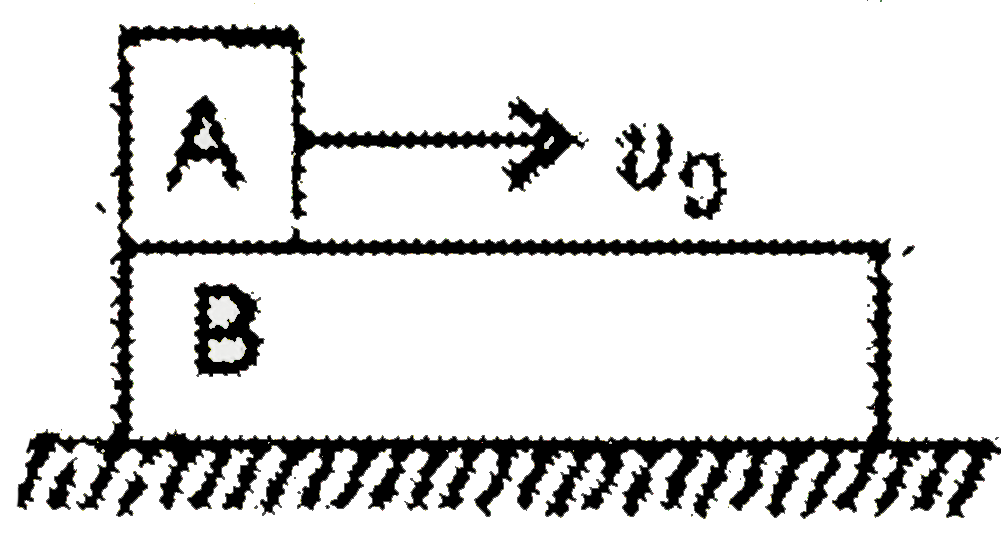 View Solution
View SolutionQuestion 63
The figure shows a block 'A' resting on a rough horizontal surface with μ=0.2. A man of mass 50 kg standing on the ground surface starts climbing the hanging ideal string. The maximum possible tension in the string is 1000N. The minimum time taken by the man to reach upto the pulley:
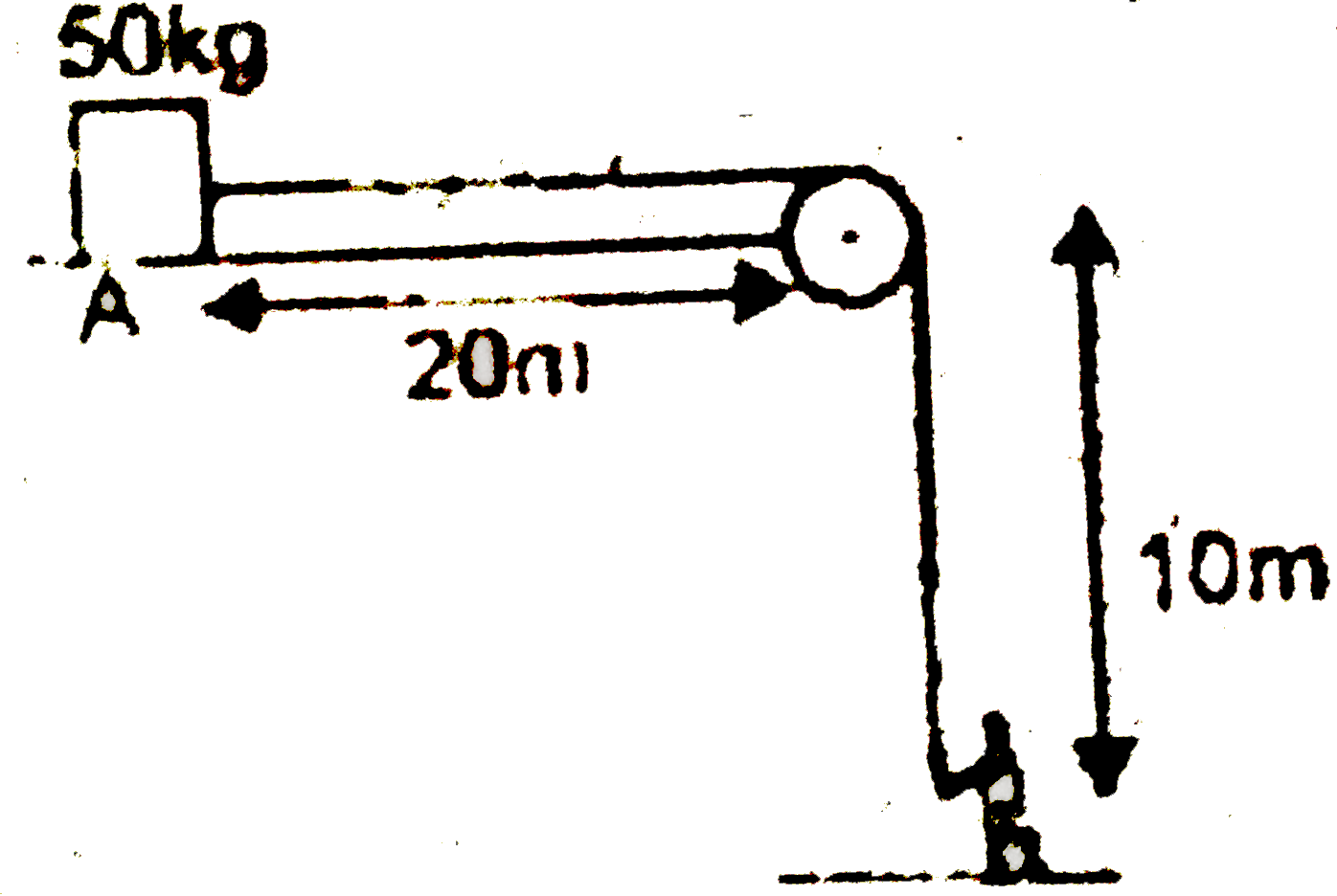 View Solution
View SolutionQuestion 70
Two particles of mass m each are tied at the ends of a light string of length 2a. The whole system is kept on a frictionless horizontal surface with the string held tight so that, each mass is at a distance 'a' from the center P (as shown in the figure). Now, the mid-point of the string is pulled vertically upwards with a small but constant force F. As a result, the particles move towards each other on the surface. The magnitude of acceleration, when the separation between them becomes 2x, is :
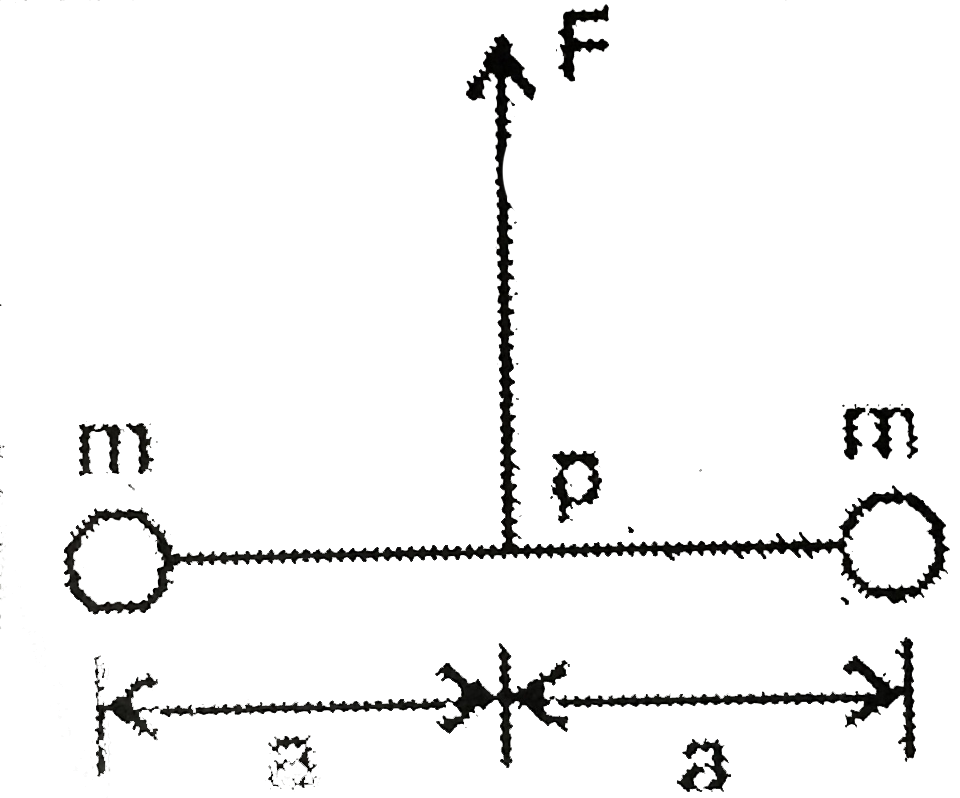 View Solution
View SolutionQuestion 73
A particle of mass m1 is fastened to one end of a massless string and another particle of mass m2 is fastened to the middle point of the same string. The other end of the string being fastened to a fixed point on a smooth horizontal table. The particles are then projected, so that the two particles and the string are always in the same straight line and describe horizontal circles. Then, the ratio of rotations in the two parts of the string is :View SolutionQuestion 77
A long horizontal rod has a bead which can slide along its length and is initially placed at a distance L from one end A of the rod. The rod is set in angular motion about A with a constant angular acceleration, α. If the coefficient of friction between the rod and bead is μ, and gravity is neglected, then the time after which the bead starts slipping is :View SolutionQuestion 82
A particle of mass m is attached to one end of string of length l while the other end is fixed to point h(h<l) above a horizontal table. The particle is made to revolve in a circle on the table so as to make p revolutions per second. The maximum value of p, if the particle is to be in contact with the table, is : (l>h)View SolutionQuestion 90
A particle is kept fixed on a turntable rotating uniformly. As seen from the ground the particle goes in a circle, its speed is 20cm/s & acceleration is 20cm/s2. The particle is now shifted to a new position to make the radius half of the original value. The new values of the speed & acceleration will be:View SolutionQuestion 95
A particle is resting on an inverted cone as shown. It is attached to cone by a thread of length 20 cm. String remains parallel to slope of cone. The cone is givenangular acceleration of 0.5rad/sec2 then at what time does mass leave contact with surface (assuming sufficient friction) :
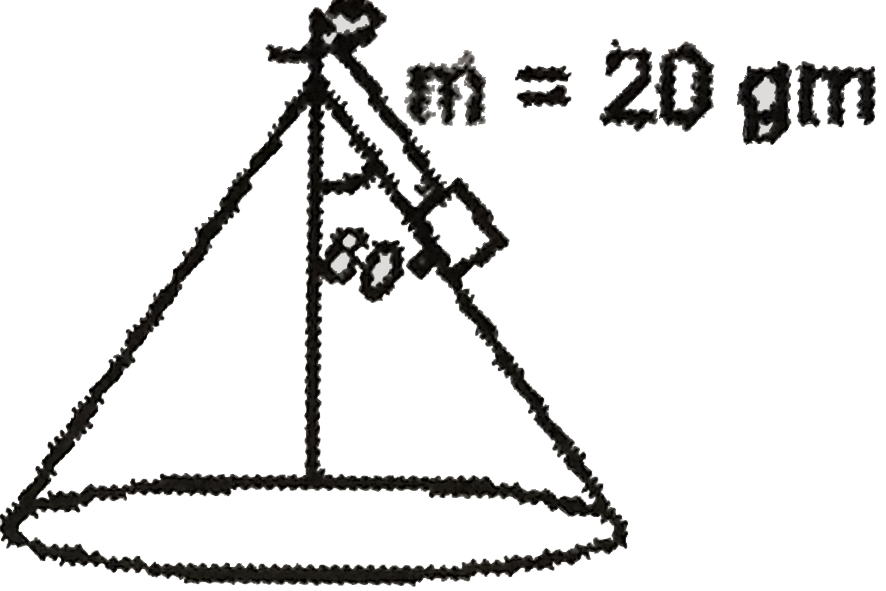 View Solution
View SolutionQuestion 121
A trolley C can run on a smooth horizontal table. Two, much smaller but equal masses A and B are hung by string which pass over smooth pulleys : The string are long enough that when C is in equilibrium. A and B both are just on the ground. The trolley is pulled slow to one side and released as shown below. The graph of its velocity v against 't' will be as :
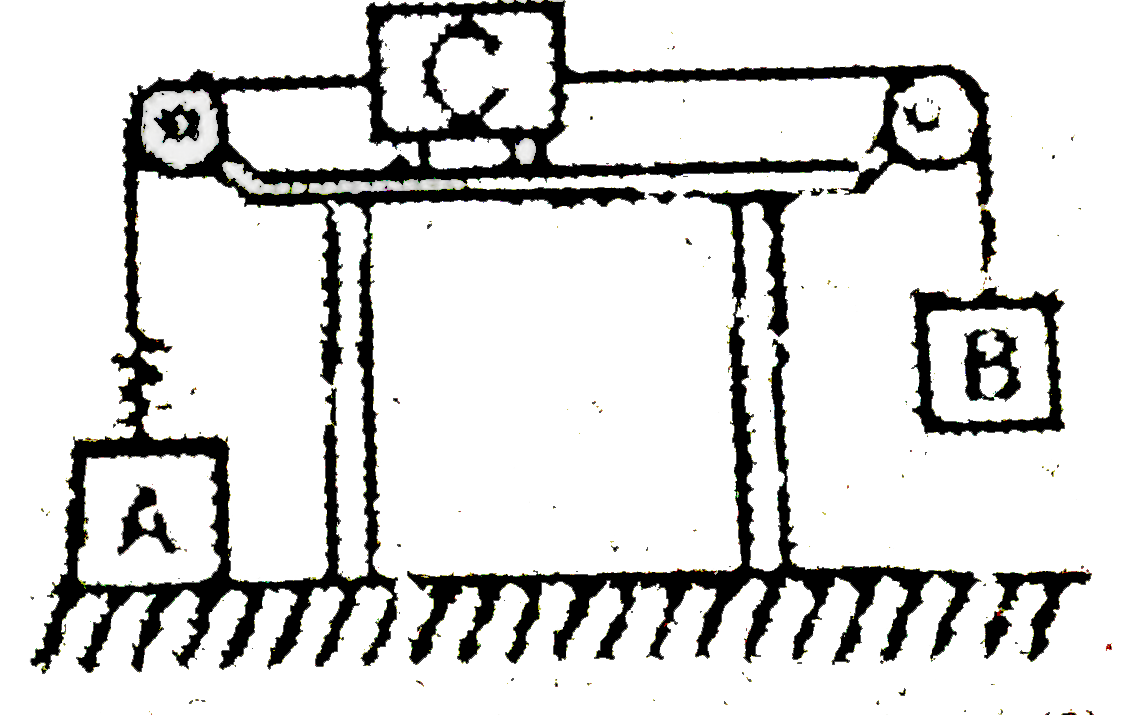 View Solution
View SolutionQuestion 132
A block of mass 0.1 kg is kept on an inclined plane whose angle of inclination can be varied from θ=30∘ to θ=90∘. The coefficient of friction between the block & the inclined plane is μ=1. A force of constant magnitude 12mg newton always acts on the block directed up the inclined plane and parallel to it. Then :
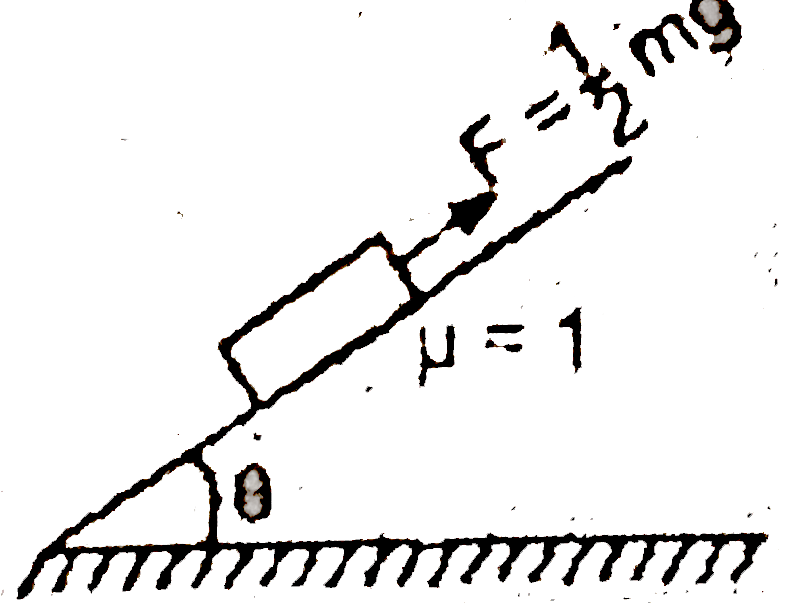 View Solution
View SolutionQuestion 144
A block is projected with velocity v0 up the inclined plane from its bottom at t=0. The plane makes an angle θ with the horizontal. If the coefficient of friction between the block and the incline is μ=tanα(α>θ) then fricitonal force applied by the plane on the block for t>v0g[sinθ+tanαcosθ] will be :View SolutionQuestion 148
ABCDE is a smooth iron track in the vertical plane. The sections ABC and CDE are quarter circles. Points B and D are very close to C.M is a small magnet of mass m. The force of attraction between M and the track is F, which is constant and always normal to the track. M starts from rest at A, then:
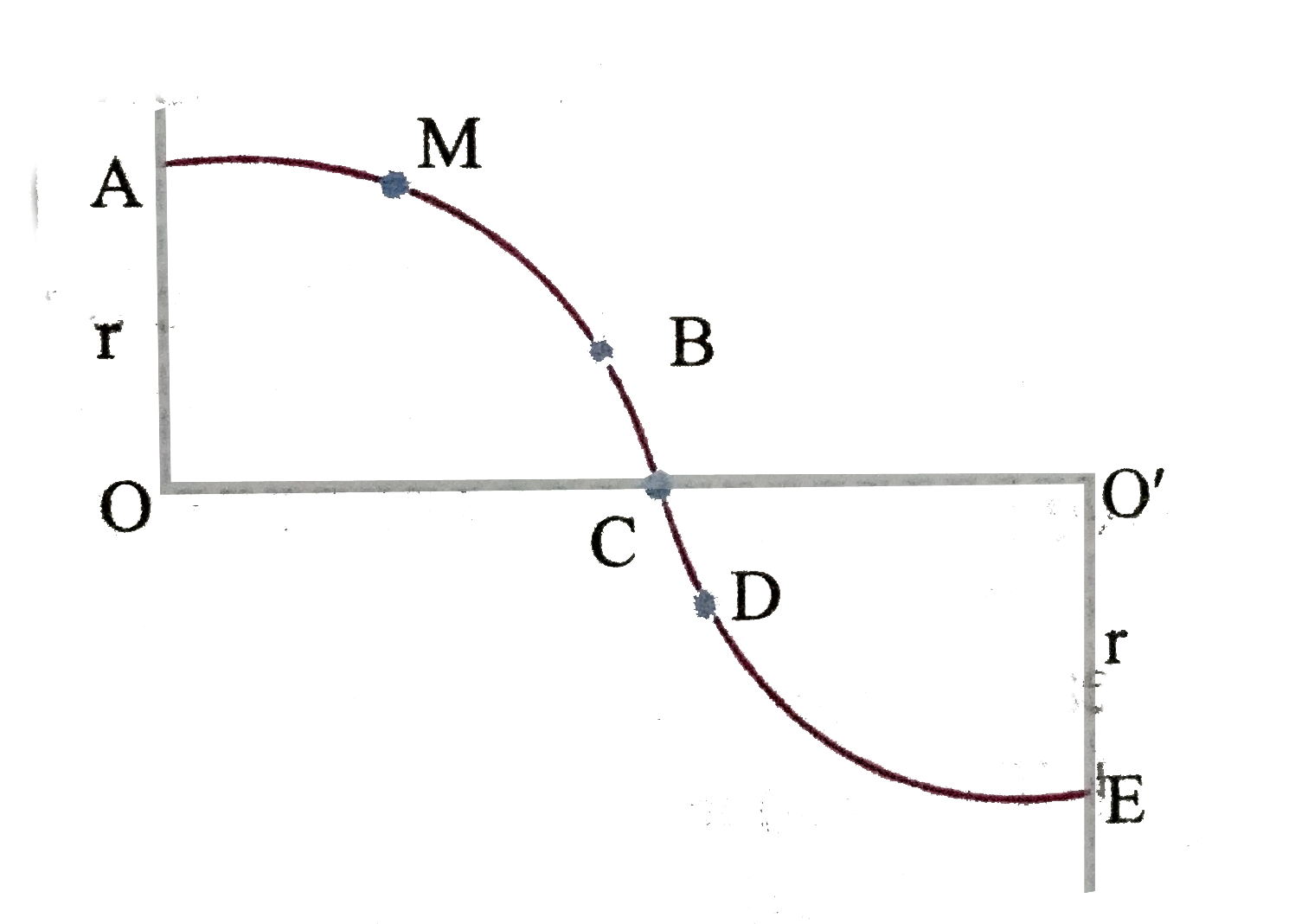 View Solution
View SolutionQuestion 150
Suppose a machine consists of a cage at the end of one arm The arm is hinged at O as shown in figure such that the cage revolves along a vertical circle of radius r at constant linear speed v=√gr. The cage is so attached that the man of weight W, standing on a weighing machine inside the cage, remains always vertical. Then :
 View Solution
View SolutionQuestion 152
A body moves on a horizontal circular road of radius r, with a tangential acceleration at. The coefficient of friction between the body and the road surface Is μ. It begins to slip when its speed is v.
(i) v2=μrg
(ii) μg=(v4r92)+at)
(iii) μ2g2=(v4r2+a2t
(iv) The force of friction makes an angle tan−1(v2/atr) with the direction of motion at the point of slipping.View SolutionQuestion 154
As shown below AB represents an infinite wall tangential to a horizontal semi-circular track. O is a point source of light on the ground at the centre of the circle. A block moves along the circular track with a speed v starting from the point where the wall touches the circle. If the velocity and acceleration of shadow along the length of the wall is respectively V and a, then :
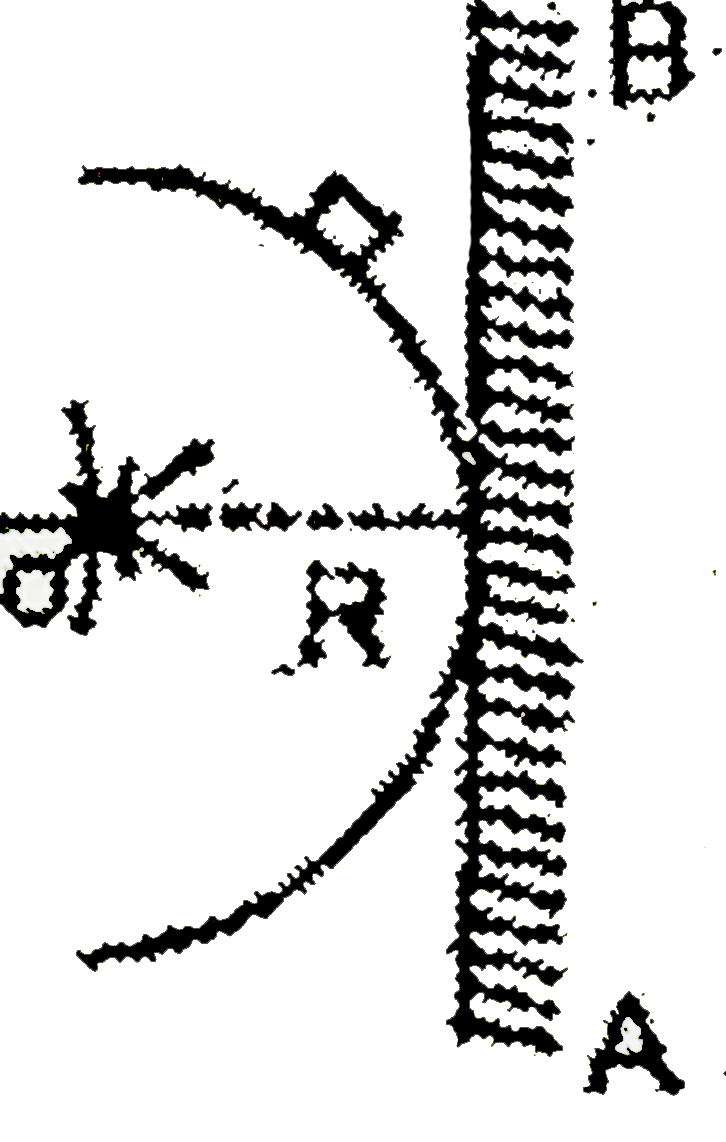 View Solution
View SolutionQuestion 169
A particle of mass m moves in a conservative force field along x axis where the potential energy U varies with position coordinate x as U=U0(1−cosax),U0 and a being positive constants. Which of the following statement is true regarding its motion. Its total energy is U0 and starts from x=0View SolutionQuestion 177
Effect of friction between pulley and thread :
In ideal cases i.e., when pulley and strings are massless and no friction exists at any contact surface, then tension in the string is constant throughout its length. But consider a, massless pulley and massless string but friction exists between pulley and string With coefficient μ. Then tension at the two ends of the pulley will be different. As shown in figure, consider an element of string :
dN=(T+dT)sindθ2+Tsindθ2

(T+dT)cosdθ2−Tcosdθ2−μdN=dra=0 (massless strings)
dTcosdθ2=μdN
dTcosdθ2=μ[(T+dt)sindθ2+Tsindθ2]
dt.cosdθ2=μ[Tsindθ2+dT.sindθ2+Tsindθ2]
dT=μ[T.dθ2+0+Tdθ2]=μTcosθ
int_(T_(1))^(T_(2)) (d T)/T=int _(0)^(pi)mu d theta rArr ln(T_(2)/T_(1))=mu pi rArrT_(2)/T_(1)=e^(mu pi)<br>Supposecofficientofictionbetweenthestr∈gandp≤––––yismu =1/pi
What should be the ratio of heavier mass to lighter mass for no motion ? View SolutionQuestion 178
Effect of friction between pulley and thread :
In ideal cases i.e., when pulley and strings are massless and no friction exists at any contact surface, then tension in the string is constant throughout its length. But consider a, massless pulley and massless string but friction exists between pulley and string With coefficient μ. Then tension at the two ends of the pulley will be different. As shown in figure, consider an element of string :
dN=(T+dT)sindθ2+Tsindθ2

(T+dT)cosdθ2−Tcosdθ2−μdN=dra=0 (massless strings)
dTcosdθ2=μdN
dTcosdθ2=μ[(T+dt)sindθ2+Tsindθ2]
dt.cosdθ2=μ[Tsindθ2+dT.sindθ2+Tsindθ2]
dT=μ[T.dθ2+0+Tdθ2]=μTcosθ
int_(T_(1))^(T_(2)) (d T)/T=int _(0)^(pi)mu d theta rArr ln(T_(2)/T_(1))=mu pi rArrT_(2)/T_(1)=e^(mu pi)<br>Supposecofficientofictionbetweenthestr∈gandp≤––––yismu =1/pi<br>Ifm_(2)=2em then acceleration of each mass is : View SolutionQuestion 179
Effect of friction between pulley and thread :
In ideal cases i.e., when pulley and strings are massless and no friction exists at any contact surface, then tension in the string is constant throughout its length. But consider a, massless pulley and massless string but friction exists between pulley and string With coefficient μ. Then tension at the two ends of the pulley will be different. As shown in figure, consider an element of string :
dN=(T+dT)sindθ2+Tsindθ2
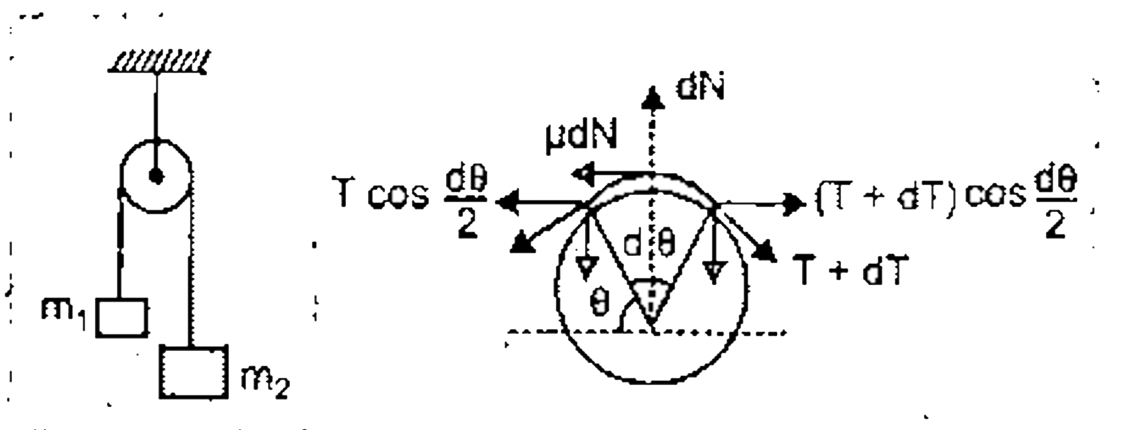
(T+dT)cosdθ2−Tcosdθ2−μdN=dra=0 (massless strings)
dTcosdθ2=μdN
dTcosdθ2=μ[(T+dt)sindθ2+Tsindθ2]
dt.cosdθ2=μ[Tsindθ2+dT.sindθ2+Tsindθ2]
dT=μ[T.dθ2+0+Tdθ2]=μTcosθ
int_(T_(1))^(T_(2)) (d T)/T=int _(0)^(pi)mu d theta rArr ln(T_(2)/T_(1))=mu pi rArrT_(2)/T_(1)=e^(mu pi)<br>Supposecofficientofictionbetweenthestr∈gandp≤––––yismu =1/pi
The tension on side ofheavier\nass will be:View SolutionQuestion 180
Effect of friction between pulley and thread :
In ideal cases i.e., when pulley and strings are massless and no friction exists at any contact surface, then tension in the string is constant throughout its length. But consider a, massless pulley and massless string but friction exists between pulley and string With coefficient μ. Then tension at the two ends of the pulley will be different. As shown in figure, consider an element of string :
dN=(T+dT)sindθ2+Tsindθ2
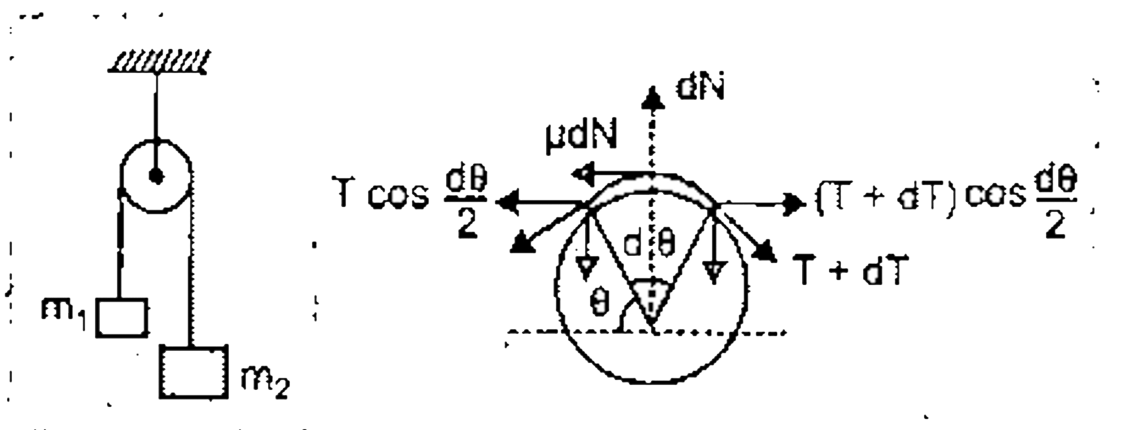
(T+dT)cosdθ2−Tcosdθ2−μdN=dra=0 (massless strings)
dTcosdθ2=μdN
dTcosdθ2=μ[(T+dt)sindθ2+Tsindθ2]
dt.cosdθ2=μ[Tsindθ2+dT.sindθ2+Tsindθ2]
dT=μ[T.dθ2+0+Tdθ2]=μTcosθ
int_(T_(1))^(T_(2)) (d T)/T=int _(0)^(pi)mu d theta rArr ln(T_(2)/T_(1))=mu pi rArrT_(2)/T_(1)=e^(mu pi)<br>Supposecofficientofictionbetweenthestr∈gandp≤––––yismu =1/pi
The tension on side of lighter mass will be:View SolutionQuestion 181
consider the situation shown in figure in which a block 'A' of mass 2 kg is placed over a biock.'B' of mass 4 kg. The combination of the blocks are placed on a inclined plane of inclination 37∘ with horizontal. The coefficient of friction between block B and inclined plane is μ2 and in between the two, blocks is μ1. The system is released from rest.
(Take g=10m/sec2)
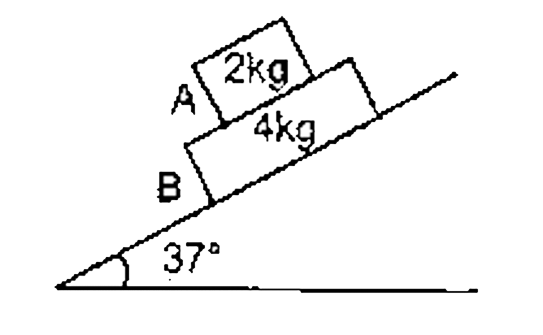
If μ1=0.8,μ2=0.8 then :View SolutionQuestion 182
consider the situation shown in figure in which a block 'A' of mass 2 kg is placed over a biock.'B' of mass 4 kg. The combination of the blocks are placed on a inclined plane of inclination 37∘ with horizontal. The coefficient of friction between block B and inclined plane is μ2 and in between the two, blocks is μ1. The system is released from rest.
(Take g=10m/sec2)

In the previous question the frictional force between block B and plane is : View SolutionQuestion 183
consider the situation shown in figure in which a block 'A' of mass 2 kg is placed over a biock.'B' of mass 4 kg. The combination of the blocks are placed on a inclined plane of inclination 37∘ with horizontal. The coefficient of friction between block B and inclined plane is μ2 and in between the two, blocks is μ1. The system is released from rest.
(Take g=10m/sec2)

If μ1=0.5,μ2=0.5 then :View SolutionQuestion 184
consider the situation shown in figure in which a block 'A' of mass 2 kg is placed over a biock.'B' of mass 4 kg. The combination of the blocks are placed on a inclined plane of inclination 37∘ with horizontal. The coefficient of friction between block B and inclined plane is μ2 and in between the two, blocks is μ1. The system is released from rest.
(Take g=10m/sec2)

The frictional force acting between the two blocks in the previous question is : View SolutionQuestion 185
consider the situation shown in figure in which a block 'A' of mass 2 kg is placed over a biock.'B' of mass 4 kg. The combination of the blocks are placed on a inclined plane of inclination 37∘ with horizontal. The coefficient of friction between block B and inclined plane is μ2 and in between the two, blocks is μ1. The system is released from rest.
(Take g=10m/sec2)
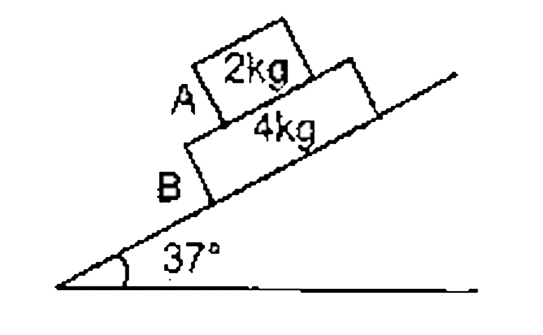
If μ1=0.4,μ2=0.5 then:View SolutionQuestion 186
consider the situation shown in figure in which a block 'A' of mass 2 kg is placed over a biock.'B' of mass 4 kg. The combination of the blocks are placed on a inclined plane of inclination 37∘ with horizontal. The coefficient of friction between block B and inclined plane is μ2 and in between the two, blocks is μ1. The system is released from rest.
(Take g=10m/sec2)

The frictional force acting between the blocks in the previous case will be: View SolutionQuestion 187
consider the situation shown in figure in which a block 'A' of mass 2 kg is placed over a biock.'B' of mass 4 kg. The combination of the blocks are placed on a inclined plane of inclination 37∘ with horizontal. The coefficient of friction between block B and inclined plane is μ2 and in between the two, blocks is μ1. The system is released from rest.
(Take g=10m/sec2)
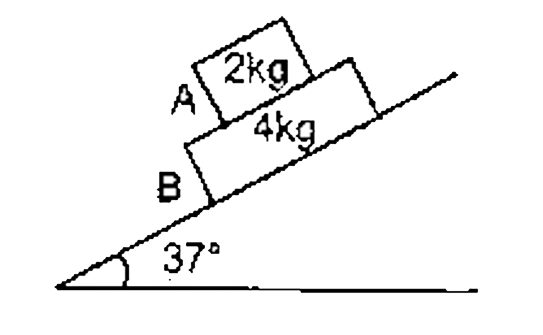
If μ1=0.5,μ2=0.4 then:View SolutionQuestion 188
consider the situation shown in figure in which a block 'A' of mass 2 kg is placed over a biock.'B' of mass 4 kg. The combination of the blocks are placed on a inclined plane of inclination 37∘ with horizontal. The coefficient of friction between block B and inclined plane is μ2 and in between the two, blocks is μ1. The system is released from rest.
(Take g=10m/sec2)
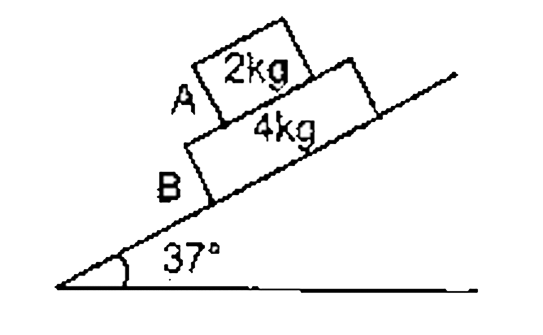
The frictional force acting between the blocks in the previous case : View SolutionQuestion 189
In the given figure, the blocks of mass 2kg and 3kg are placed one over the other as shown. The surface are rough with coefficient of friction μ1=0.2,μ2=0.06. A force F=0.5t( where 't'insec) is applied on upper block in the direction shown. Based on above data answer the following questions.
(g=10m/sec2)
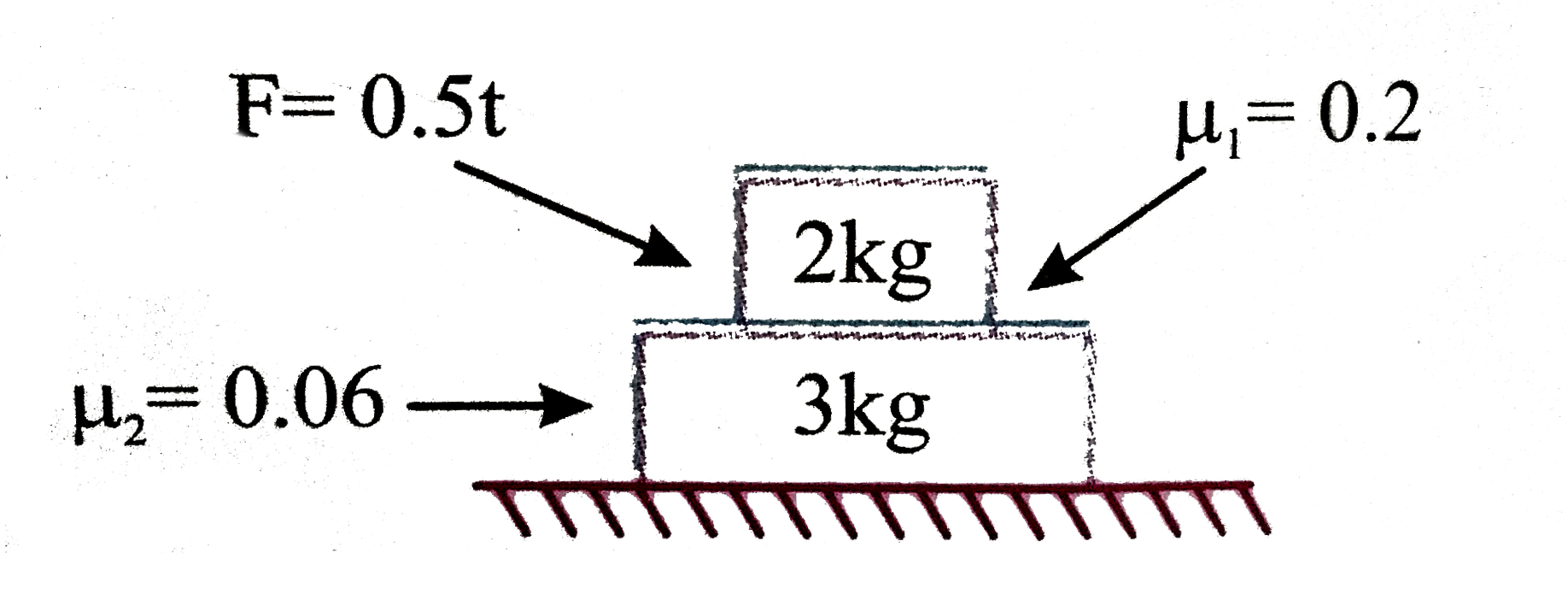
The motion of blocks 2kg and 3kg will begin at time t=−,− respectivelyView SolutionQuestion 190
In the given figure, the blocks of mass 2kg and 3kg are placed one over the other as shown. The surface are rough with coefficient of friction μ1=0.2,μ2=0.06. A force F=0.5t (where 't' in sec) is applied on upper block in the direction shown. Based on above data answers the following questions. (g=10m/sec2)

The realtive slipping between the blocks occurs at t=View SolutionQuestion 191
In the given figure, the blocks of mass 2kg and 3kg are placed one over the other as shown. The surface are rough with coefficient of friction μ1=0.2,μ2=0.06. A force F=0.5t (where 't' in sec) is applied on upper block in the direction shown. Based on above data answers the following questions. (g=10m/sec2)

The frictional force acting between the two blocks at t=9 secView SolutionQuestion 192
In the given figure, the blocks of mass 2kg and 3kg are placed one over the other as shown. The surface are rough with coefficient of friction μ1=0.2,μ2=0.06. A force F=0.5t (where 't' in sec) is applied on upper block in the direction shown. Based on above data answers the following questions. (g=10m/sec2)

The frictional force acting between the blocks at t=10sec isView SolutionQuestion 193
In the given figure, the blocks of mass 2kg and 3kg are placed one over the other as shown. The surface are rough with coefficient of friction μ1=0.2,μ2=0.06. A force F=0.5t (where 't' in sec) is applied on upper block in the direction shown. Based on above data answers the following questions. (g=10m/sec2)

The acceleration time graph for 2kg blok is :View SolutionQuestion 194
In the given figure, the blocks of mass 2kg and 3kg are placed one over the other as shown. The surface are rough with coefficient of friction μ1=0.2,μ2=0.06. A force F=0.5t (where 't' in sec) is applied on upper block in the direction shown. Based on above data answers the following questions. (g=10m/sec2)

The acceleration time graph for 4 kg block is :View SolutionQuestion 195
In the given figure, the blocks of mass 2kg and 3kg are placed one over the other as shown. The surface are rough with coefficient of friction μ1=0.2,μ2=0.06. A force F=0.5t (where 't' in sec) is applied on upper block in the direction shown. Based on above data answers the following questions. (g=10m/sec2)

The frictional force acting between 3 kg block and ground w.r.t. time will vary as :View SolutionQuestion 196
In the given figure, the blocks of mass 2kg and 3kg are placed one over the other as shown. The surface are rough with coefficient of friction μ1=0.2,μ2=0.06. A force F=0.5t (where 't' in sec) is applied on upper block in the direction shown. Based on above data answers the following questions. (g=10m/sec2)

The friction force between the blocks and time graph is :View SolutionQuestion 201
The figure shows a rod which startsm rotating with angular acceleration α about vertical axis passing through one of its end (A) in horizontal plane. A bead of mass m just fit's the rod and is situated at a distance 'r' from end A. Friction exists between rod and the bead with coefficient μ. As the angular velocity of rod increases the bead starts sliding over the rod (say after time t0)
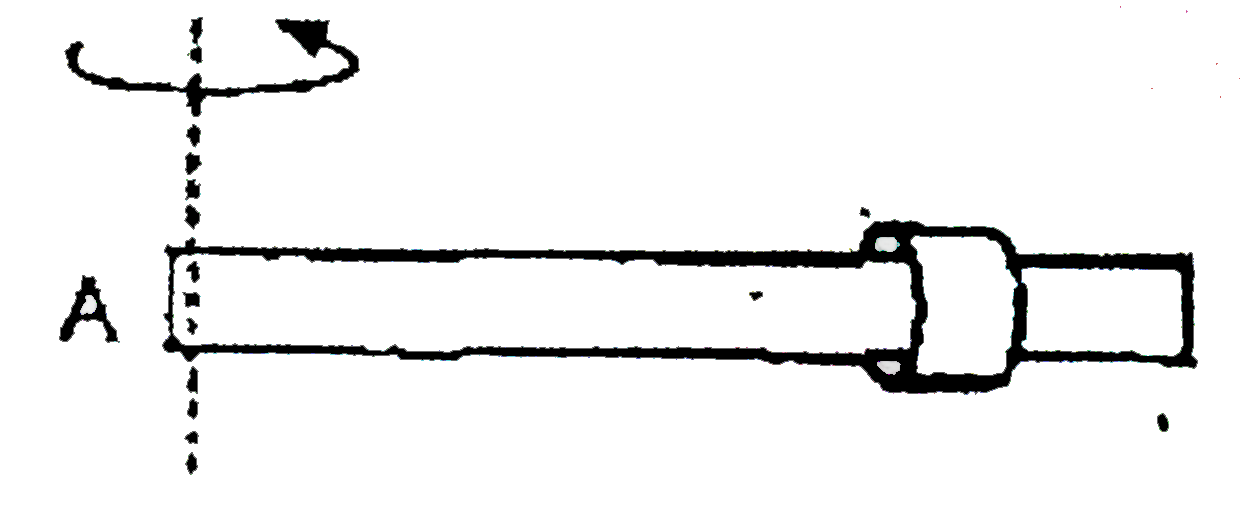
Based on above information answer the following question :
The normal force acting on bead at time t(<t0) is :View SolutionQuestion 202
The figure shows a rod which startsm rotating with angular acceleration α about vertical axis passing through one of its end (A) in horizontal plane. A bead of mass m just fit's the rod and is situated at a distance 'r' from end A. Friction exists between rod and the bead with coefficient μ. As the angular velocity of rod increases the bead starts sliding over the rod (say after time t0)
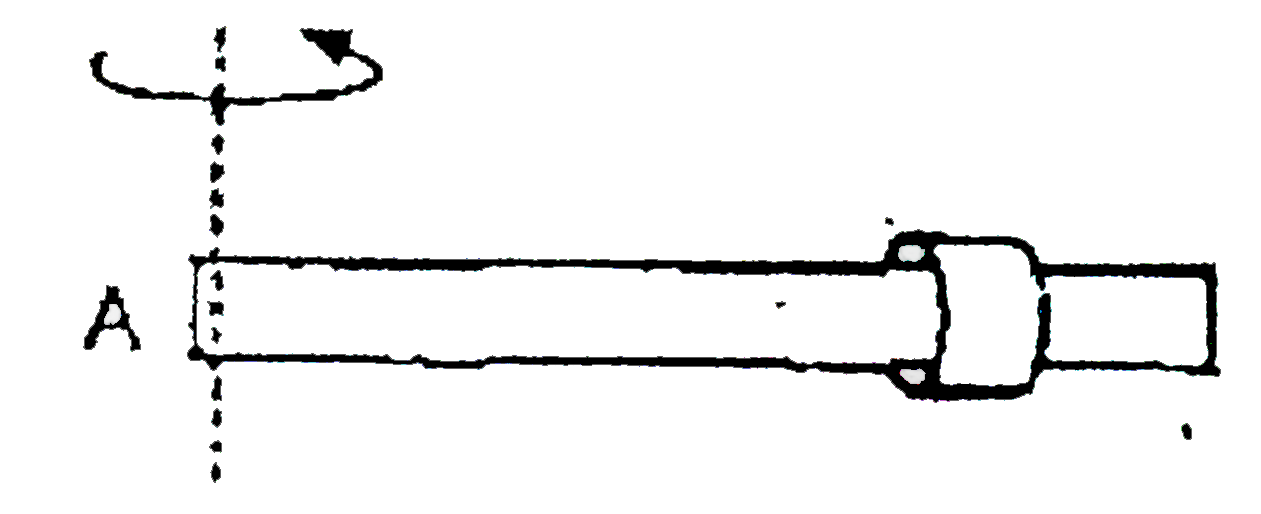
Based on above information answer the following question :
Friction force acting on bead at time t(<t0) is given by :View SolutionQuestion 203
The figure shows a rod which startsm rotating with angular acceleration α about vertical axis passing through one of its end (A) in horizontal plane. A bead of mass m just fit's the rod and is situated at a distance 'r' from end A. Friction exists between rod and the bead with coefficient μ. As the angular velocity of rod increases the bead starts sliding over the rod (say after time t0)

Based on above information answer the following question :
If the bead start sliding at t=t0 then value of t0 is given by :View SolutionQuestion 204
A very small cube of mass 2kg is placed on the surface of a funnel as shown in figure. The funnel is rotating about its vertical axis of symmetry with angular velocity ω. The wall of funnel makes an angle 37∘ with horizontal. The distance of cube from the axis of rotation is 20 cm and friction coefficient is μ (Take g=10m/s2)
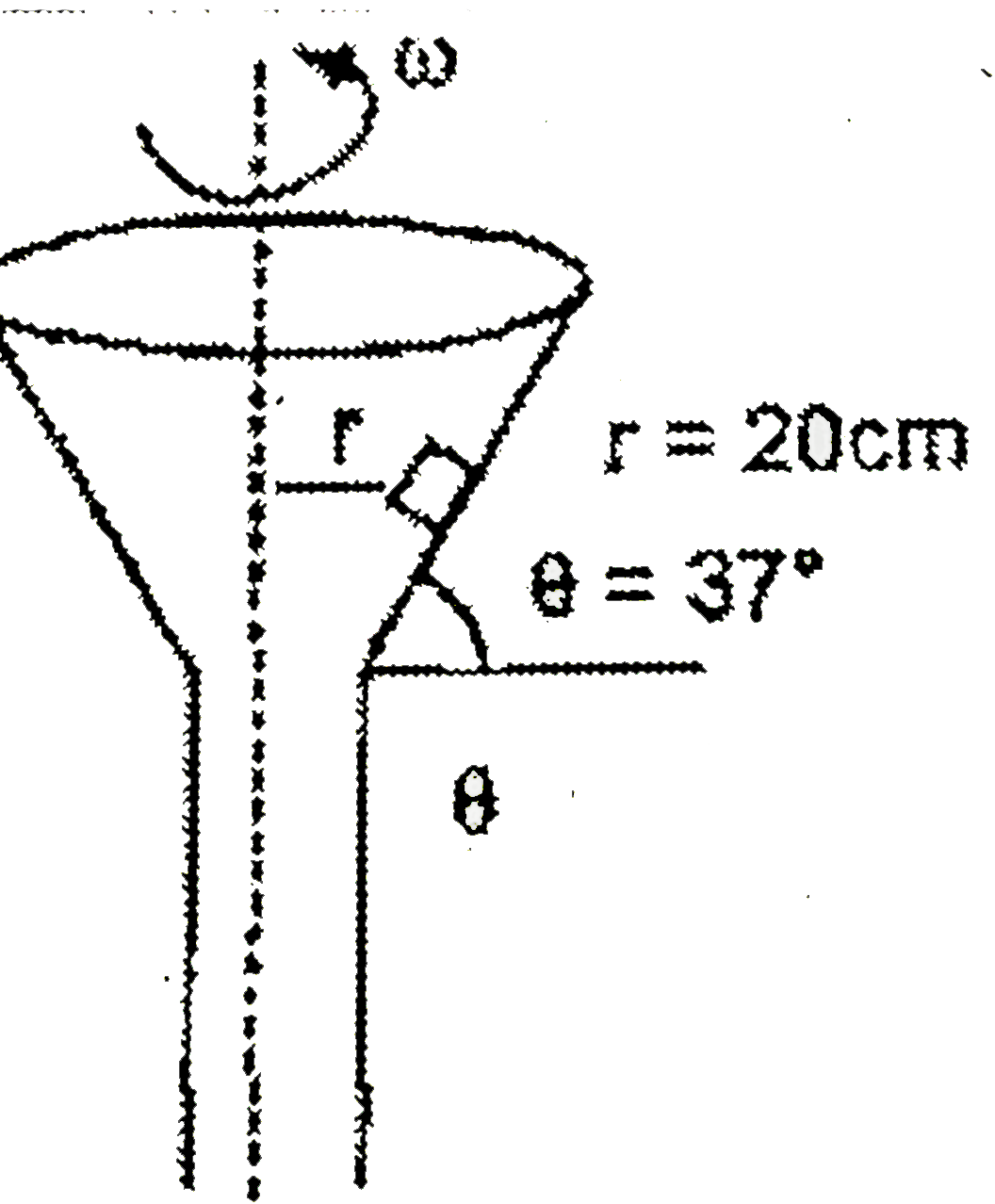
The friction force acting between the block and surface (if μ=0.3) of funnel at ω=5rad/s is :View SolutionQuestion 205
A very small cube of mass 2kg is placed on the surface of a funnel as shown in figure. The funnel is rotating about its vertical axis of symmetry with angular velocity ω. The wall of funnel makes an angle 37∘ with horizontal. The distance of cube from the axis of rotation is 20 cm and friction coefficient is μ (Take g=10m/s2)

For what value of ω, there would be no frictional force acting between the surfaces :View SolutionQuestion 206
A very small cube of mass 2kg is placed on the surface of a funnel as shown in figure. The funnel is rotating about its vertical axis of symmetry with angular velocity ω. The wall of funnel makes an angle 37∘ with horizontal. The distance of cube from the axis of rotation is 20 cm and friction coefficient is μ (Take g=10m/s2)
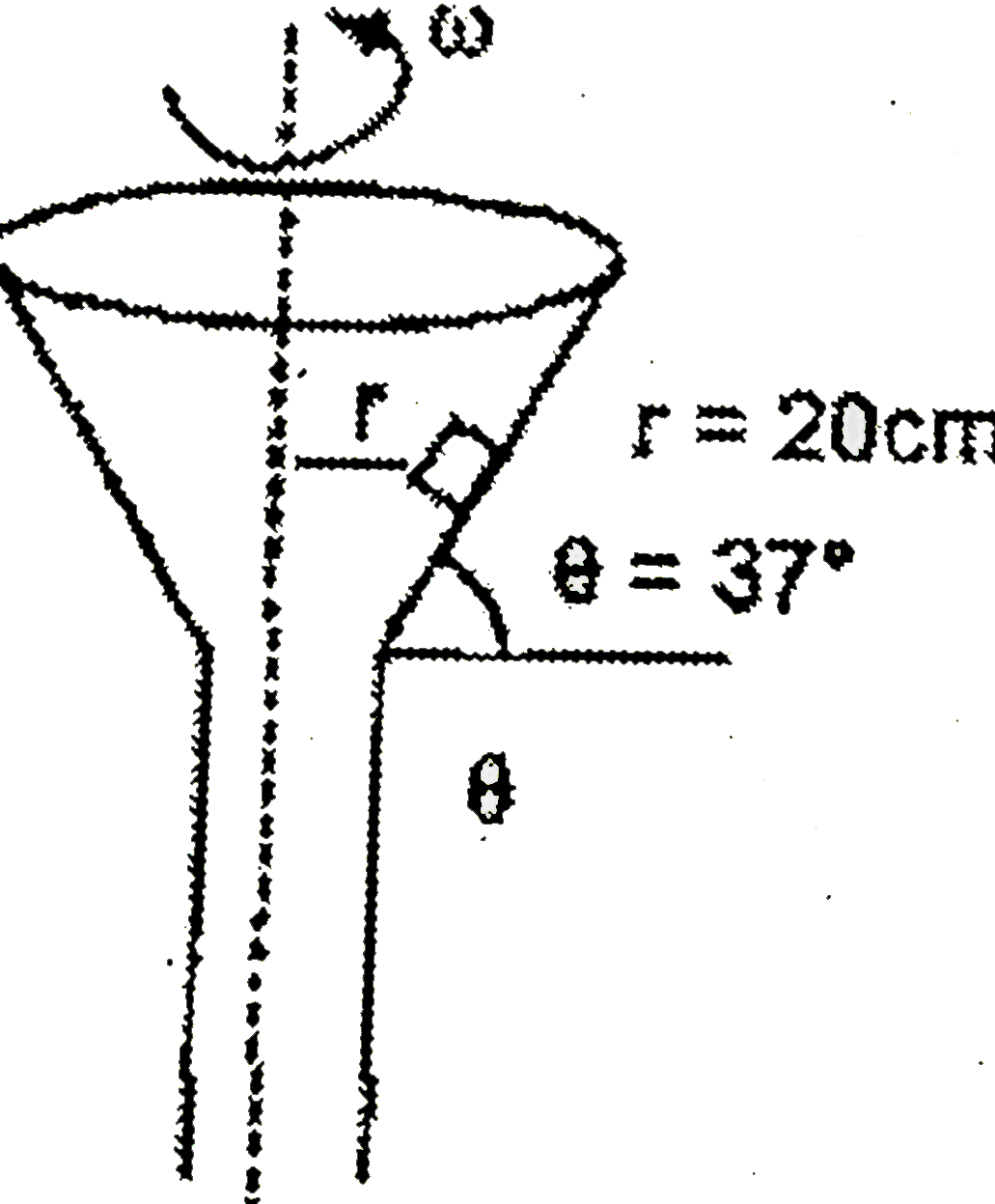
The maximum value of angular velocity for which no relative slipping occur and also direction of frictional force is : (take μ=2/3)View SolutionQuestion 207
A very small cube of mass 2kg is placed on the surface of a funnel as shown in figure. The funnel is rotating about its vertical axis of symmetry with angular velocity ω. The wall of funnel makes an angle 37∘ with horizontal. The distance of cube from the axis of rotation is 20 cm and friction coefficient is μ (Take g=10m/s2)
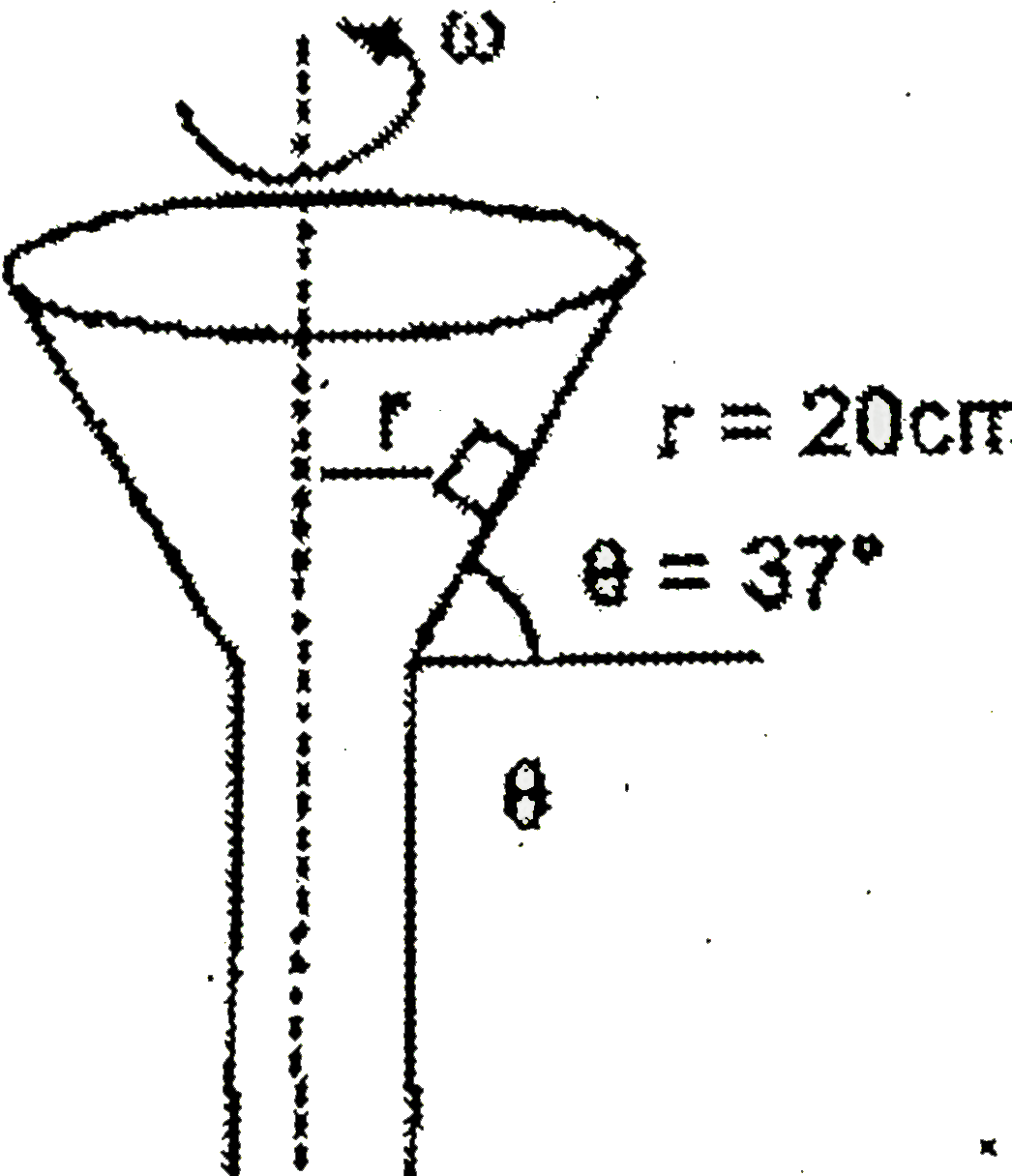
The mimimum value of angular velocity for which relative slipping occurs and also the direction of frictional force acting μ=2/3 :View SolutionQuestion 208
A car is moving with speed v and is taking a turn on a circular road of radius 10 m. The angle of banking is 37∘. The driver wants that car does not slip on the road. The coefficient of friction is 0.4(g=10m/sec2)
The speed of car for which no frictional force is produced is :View SolutionQuestion 209
A car is moving with speed v and is taking a turn on a circular road of radius 10 m. The angle of banking is 37∘. The driver wants that car does not slip on the road. The coefficient of friction is 0.4(g=10m/sec2)
The friction force acting when v=10m/sec and mass of car is 50 kg is :View SolutionQuestion 210
A car is moving with speed v and is taking a turn on a circular road of radius 10 m. The angle of banking is 37∘. The driver wants that car does not slip on the road. The coefficient of friction is 0.4(g=10m/sec2)
If the car were moving on a flat road and distance between the front tyres is 2 m and the height of the centre of the mass of the car is 1m from the ground, then, the minimum velocity for which car topples is :View SolutionQuestion 211
A body of mass m=1.8kg is placed on an inclined plane, the angle of inclination is α=37∘, and is attached to the top end of the slope with a thread which is parallel to the slop. Then the slope is moved with a horizontal acceleration of a. Fraction is negligible.
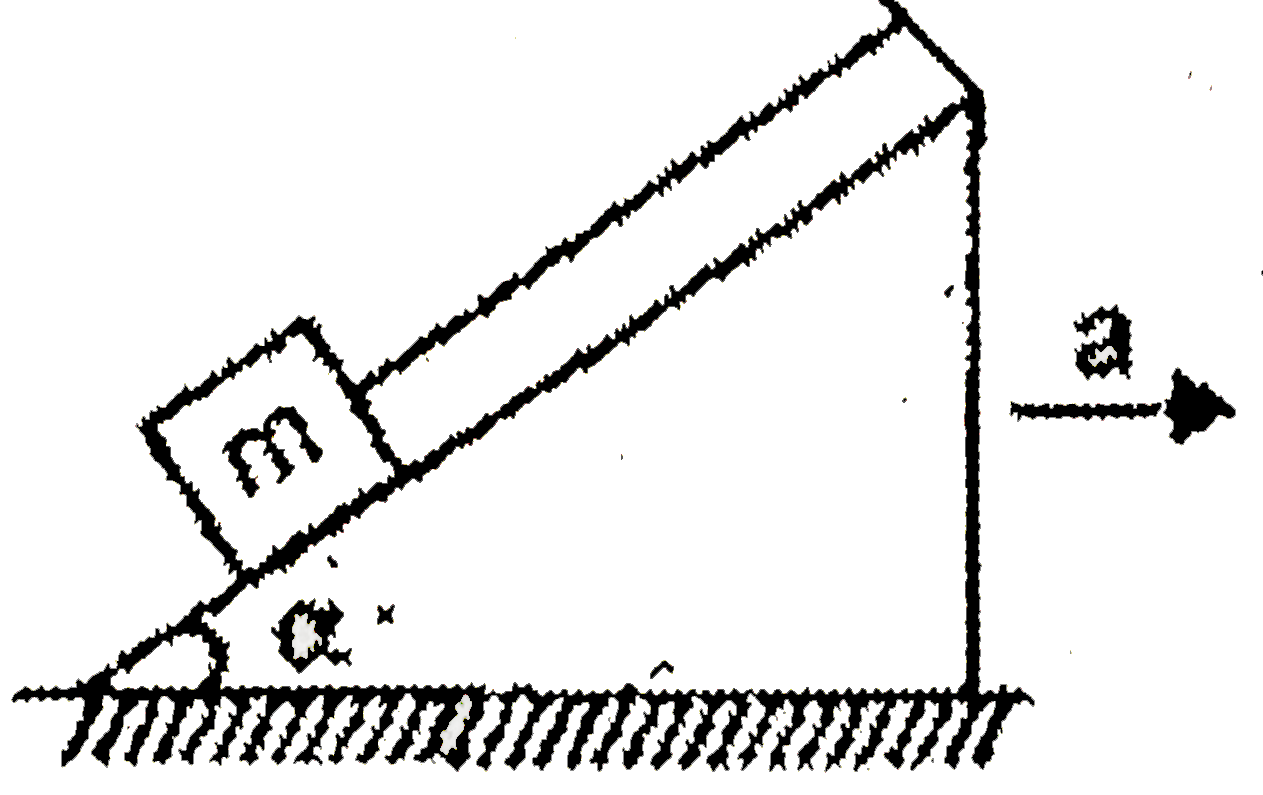
The acceleration, if the body pushes the slope with a force of 34mg is :View SolutionQuestion 212
A body of mass m=1.8kg is placed on an inclined plane, the angle of inclination is α=37∘, and is attached to the top end of the slope with a thread which is parallel to the slop. Then the slope is moved with a horizontal acceleration of a. Fraction is negligible.

The tension in thread is :View SolutionQuestion 213
A body of mass m=1.8kg is placed on an inclined plane, the angle of inclination is α=37∘, and is attached to the top end of the slope with a thread which is parallel to the slop. Then the slope is moved with a horizontal acceleration of a. Fraction is negligible.

At what acceleration will the body lose contact with plane :View SolutionQuestion 214
A lift can move upward or downward. A light inextensible string fixed from ceiling of lift when a frictionless pulley and tensions in string T1. Two masses of m1andm2 are connected with inextensible light string and tension in this string T2 as shown in figure. Read the questionbs carefully and answer
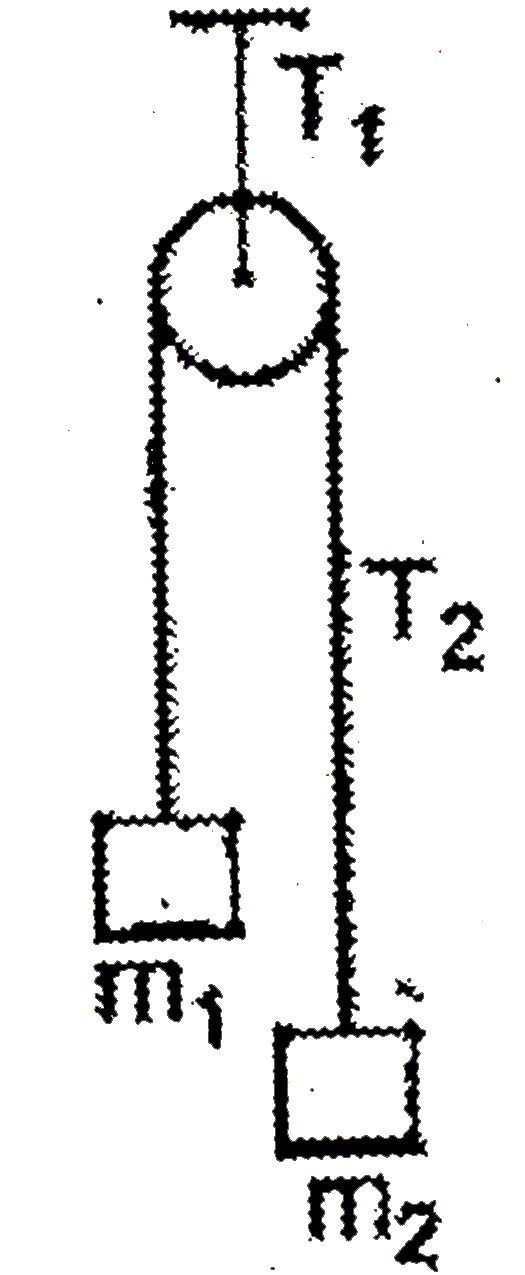
If m1+m2=m and lift is moving with constant velocity then value of T1 :View SolutionQuestion 215
A lift can move upward or downward. A light inextensible string fixed from ceiling of lift when a frictionless pulley and tensions in string T1. Two masses of m1andm2 are connected with inextensible light string and tension in this string T2 as shown in figure. Read the questionbs carefully and answer
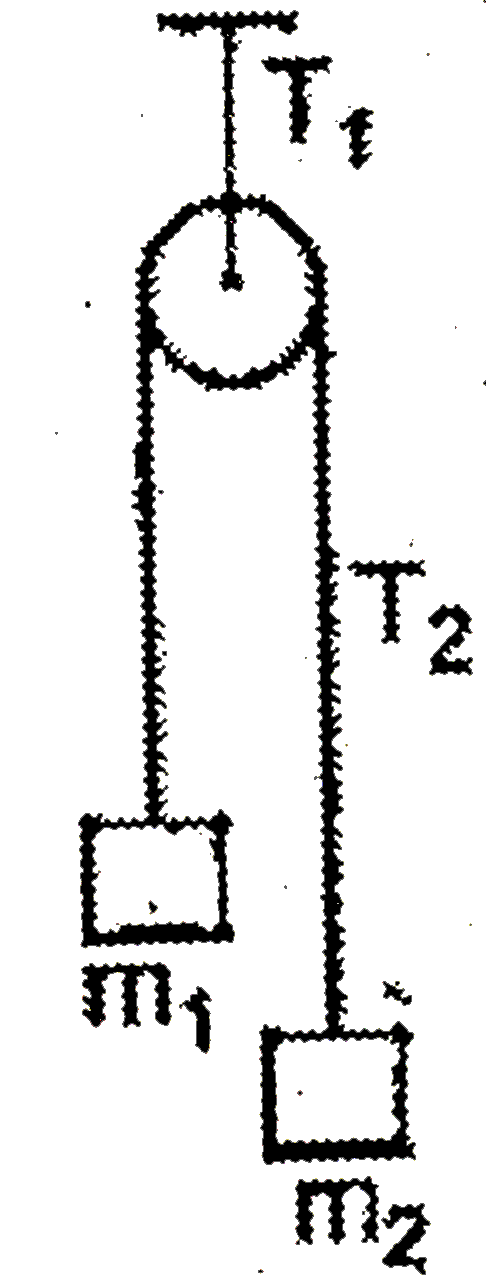
If m1 is very small as compared to m2 and lift is moving with constant velocity then value of T2 is nearly :View SolutionQuestion 216
A lift can move upward or downward. A light inextensible string fixed from ceiling of lift when a frictionless pulley and tensions in string T1. Two masses of m1andm2 are connected with inextensible light string and tension in this string T2 as shown in figure. Read the questionbs carefully and answer
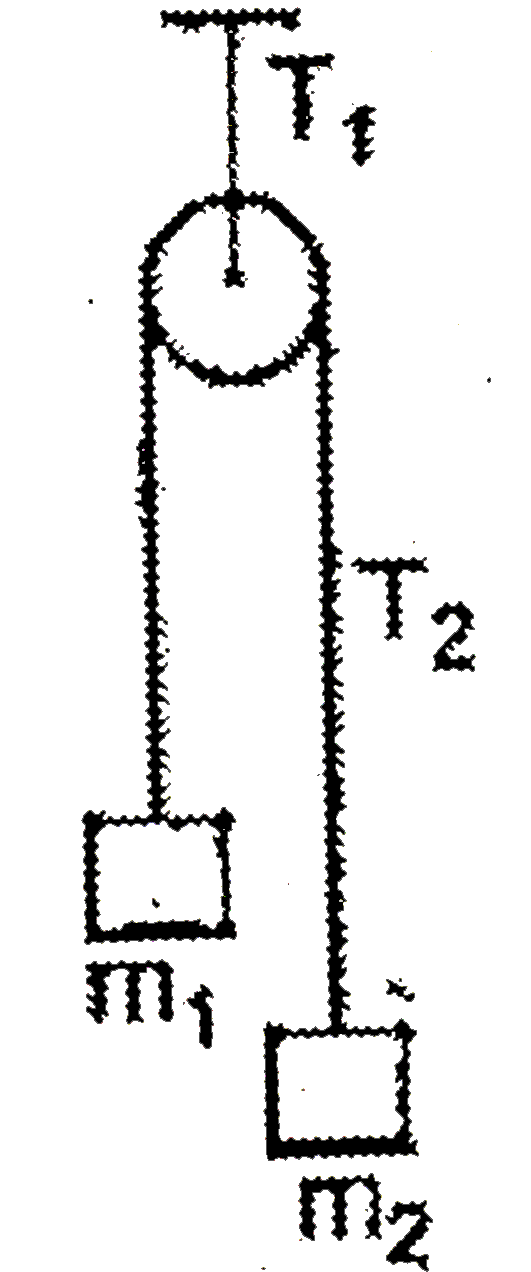
If m1=m2andm1 is moving at a certain instant with velocity v upward with respect to lift and the lift is moving in upward direction with constant acceleration (a<g) then speed of m1 with respect to lift :View SolutionQuestion 217
A shot putter with a mass of 80 kg pushes the iron ball of mass of 6 kg from a standing position accelerating it uniformly from rest at an angle of 45∘ with the horizontal during a time interval of 0.1 seconds. The ball leaves his hand when it is 2m high above the level, ground and hits the ground 2 seconds later.
The acceleration of the ball in shot putter's hand :View SolutionQuestion 218
A shot putter with a mass of 80 kg pushes the iron ball of mass of 6 kg from a standing position accelerating it uniformly from rest at an angle of 45∘ with the horizontal during a time interval of 0.1 seconds. The ball leaves his hand when it is 2m high above the level, ground and hits the ground 2 seconds later.
The horizontal distance between the point of release and the point where the ball hits the ground :View SolutionQuestion 219
A shot putter with a mass of 80 kg pushes the iron ball of mass of 6 kg from a standing position accelerating it uniformly from rest at an angle of 45∘ with the horizontal during a time interval of 0.1 seconds. The ball leaves his hand when it is 2m high above the level, ground and hits the ground 2 seconds later.
The minimum value of the static coefficient of frictin if the shot putter does not slip during the shot is closet to :View SolutionQuestion 220
In the figure shown, the mass of the trolley is 100 kg and it can move without friction on the horizontal floor. It length is 12 cm. The mass of the girl is 50 kg. Friction exists between is 12 m. The mass of the girl is 50 kg. Friction exists between the shoes of the girl and the trolley's upper surface, with μ=1/3, The girl can run with a maximum speed =9m/s on the surface of the trolley, with respect to the surface =9m/s on the surface of thr trolley, with respect to the surface. At t=0 the girlm starts running from left to the right. The trolley was initially stationary. (g=10m/s2)
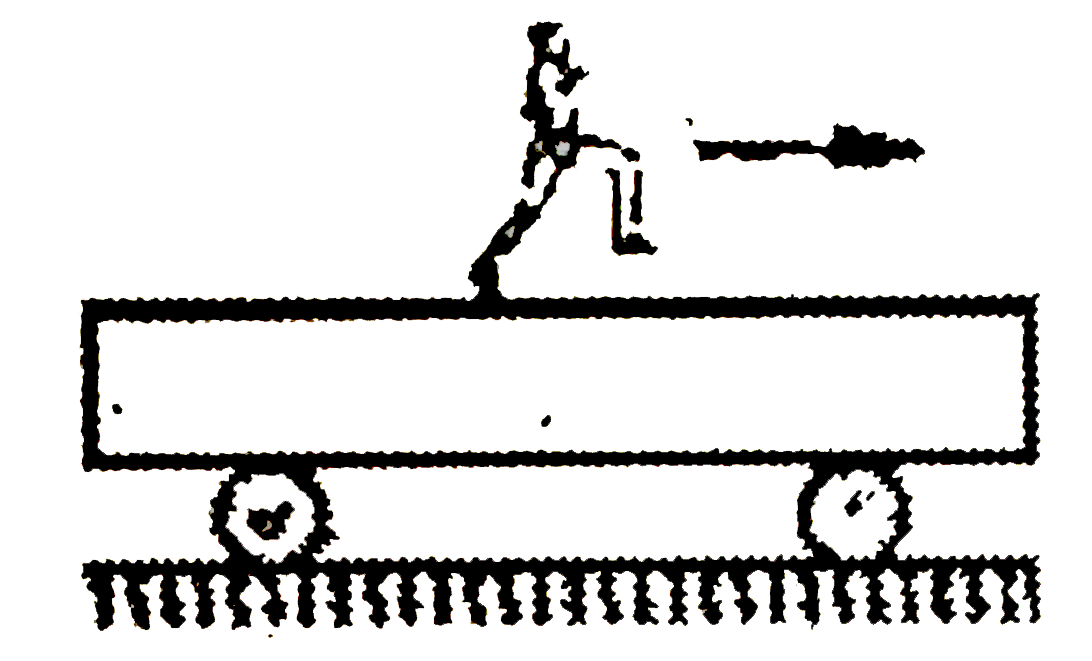
The minimum time in which the girl can acquire her maximum speed, for no slipping is :View SolutionQuestion 221
In the figure shown, the mass of the trolley is 100 kg and it can move without friction on the horizontal floor. It length is 12 cm. The mass of the girl is 50 kg. Friction exists between is 12 m. The mass of the girl is 50 kg. Friction exists between the shoes of the girl and the trolley's upper surface, with μ=1/3, The girl can run with a maximum speed =9m/s on the surface of the trolley, with respect to the surface =9m/s on the surface of thr trolley, with respect to the surface. At t=0 the girlm starts running from left to the right. The trolley was initially stationary. (g=10m/s2)

The total kinetic energy of system (trolley + girl) at the instant the girl acquires her maximum relative speed with respect to trolley, is :View SolutionQuestion 222
In the figure shown, the mass of the trolley is 100 kg and it can move without friction on the horizontal floor. It length is 12 cm. The mass of the girl is 50 kg. Friction exists between is 12 m. The mass of the girl is 50 kg. Friction exists between the shoes of the girl and the trolley's upper surface, with μ=1/3, The girl can run with a maximum speed =9m/s on the surface of the trolley, with respect to the surface =9m/s on the surface of thr trolley, with respect to the surface. At t=0 the girlm starts running from left to the right. The trolley was initially stationary. (g=10m/s2)

The displacement of the trolley by the time the girl reaches the right end of the trolley is :View SolutionQuestion 223
In the figure shown, the mass of the trolley is 100 kg and it can move without friction on the horizontal floor. It length is 12 cm. The mass of the girl is 50 kg. Friction exists between is 12 m. The mass of the girl is 50 kg. Friction exists between the shoes of the girl and the trolley's upper surface, with μ=1/3, The girl can run with a maximum speed =9m/s on the surface of the trolley, with respect to the surface =9m/s on the surface of thr trolley, with respect to the surface. At t=0 the girlm starts running from left to the right. The trolley was initially stationary. (g=10m/s2)
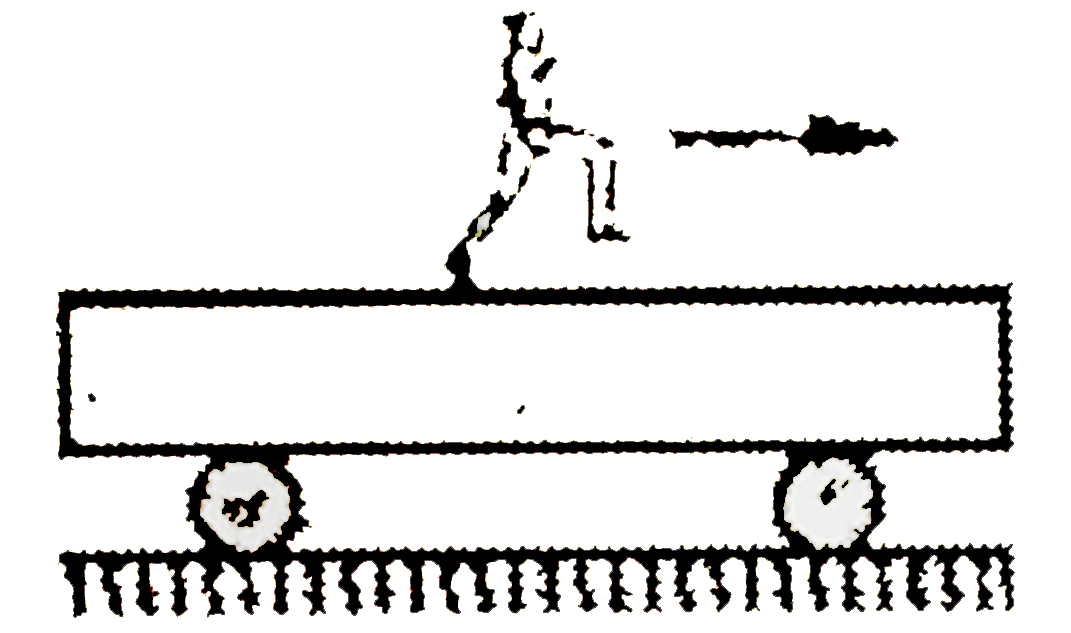
The minimum time in which the girl can stop from 9 m/s relative speed, to zero relative speed, without causing her shoes to slip is :View SolutionQuestion 224
In the figure shown, the mass of the trolley is 100 kg and it can move without friction on the horizontal floor. It length is 12 cm. The mass of the girl is 50 kg. Friction exists between is 12 m. The mass of the girl is 50 kg. Friction exists between the shoes of the girl and the trolley's upper surface, with μ=1/3, The girl can run with a maximum speed =9m/s on the surface of the trolley, with respect to the surface =9m/s on the surface of thr trolley, with respect to the surface. At t=0 the girlm starts running from left to the right. The trolley was initially stationary. (g=10m/s2)
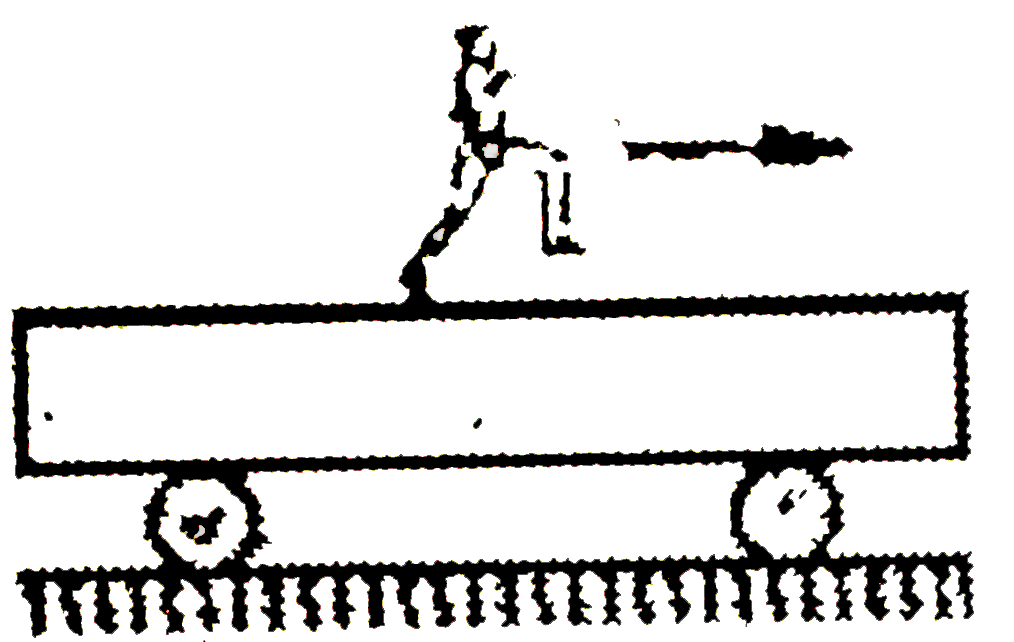
At a certain moment when the girl was accelerating, the earth frame accelerating of the trolley is found to be 1m/s2. At this moment, the friction force between the girl's shoes and the trolley's surface is :View SolutionQuestion 225
In the figure shown, the mass of the trolley is 100 kg and it can move without friction on the horizontal floor. It length is 12 cm. The mass of the girl is 50 kg. Friction exists between is 12 m. The mass of the girl is 50 kg. Friction exists between the shoes of the girl and the trolley's upper surface, with μ=1/3, The girl can run with a maximum speed =9m/s on the surface of the trolley, with respect to the surface =9m/s on the surface of thr trolley, with respect to the surface. At t=0 the girlm starts running from left to the right. The trolley was initially stationary. (g=10m/s2)
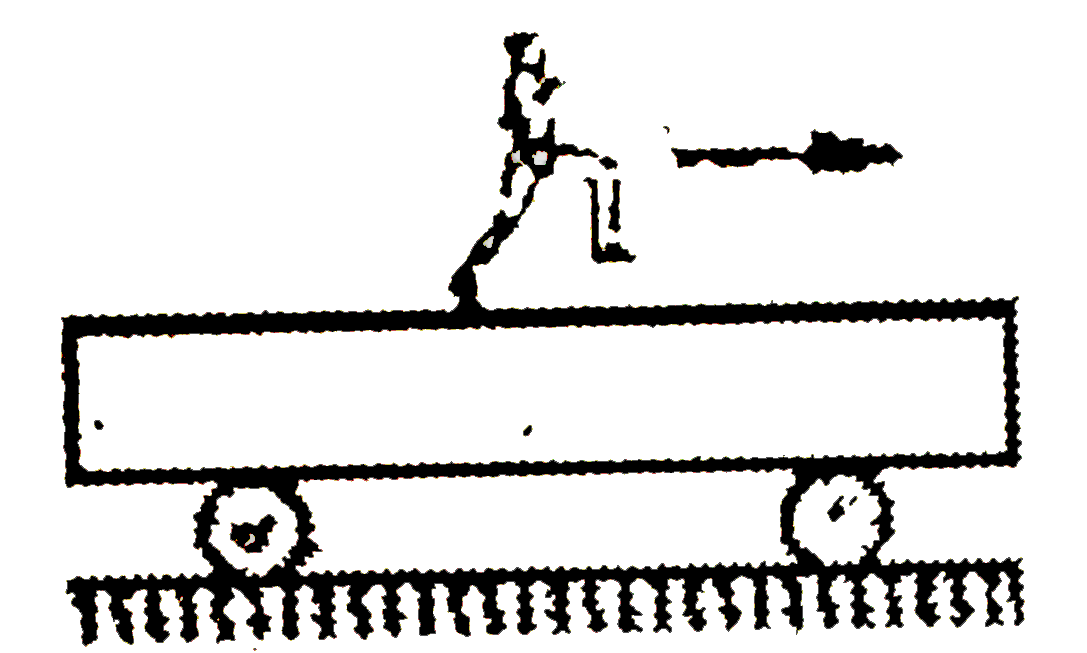
Suppose the girl accelerates slowly, at a constant rate, and acquires the relative speed of 9m/s only when it reaches the right end of the trolley, then what must be the earth frame acceleration of the girl ?View SolutionQuestion 226
A motorcycle moves around a vertical circle with a constants speed under the influence of the force of gravity →W, friction between wheel and track →f and normal reaction between wheel track →N :
Column-1Column-2(A)Constant magnitude(P)→N(B)Directed towards centre when value in non-zero(Q)→N+→f(C)Total reaction force by track(R)→f+→w(D)When motion is along vertical the value is zero(S)→N+→w+→fView SolutionQuestion 227
A block is projected with an initial velocity vBlock on a long conveyor belt moving with velocity vBlock (at that instant)having constant acceleration aBelt. Mark the correct option regarding friction after long time (friction coefficient between block and belt =μ). If :
Column-1Column-2(A)vBlock=2vBeltandaBelt=0(P)zero(B)vblock=2vBeltandaBelt>μg(Q)fsstatic friction(0<fs<fL)(C)vBlock=2vBeltandaBelt=μg(R)fLlimiting friction(D)vBlock=2vBeltandaBelt<μg(S)fKkinetic frictionView SolutionQuestion 228
The inclined surface is rough μ=12. For different values of m and M system slides down or up the plane or remains stationary. Match the appropriate entries of column-1 with those of column-2
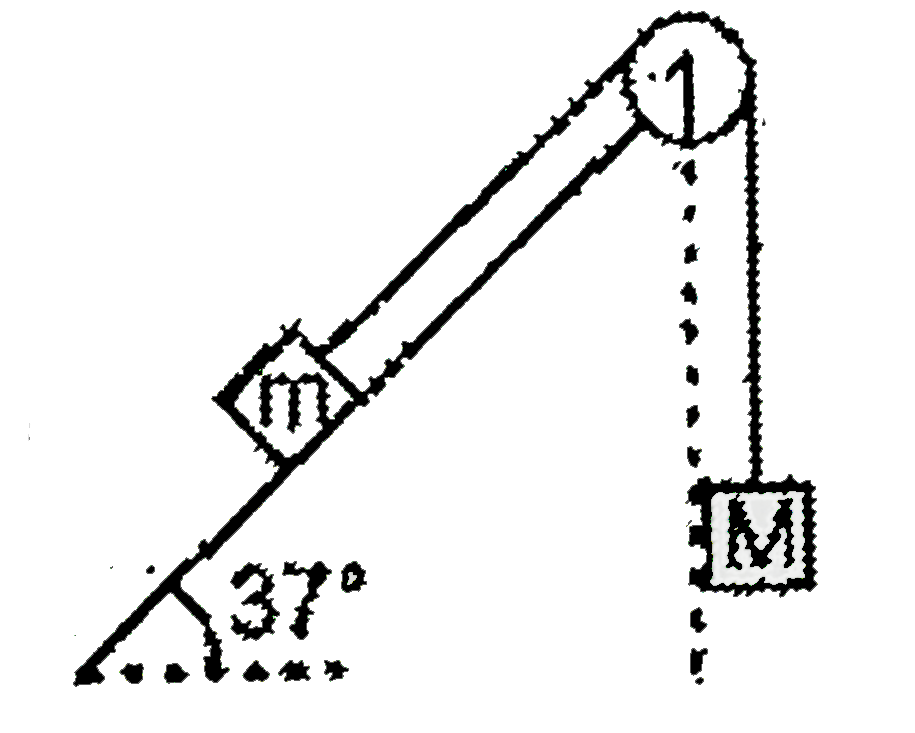
Column-1Column-2(A)Minimum value of mMso theta m slides down(P)53(B)Minimum valie of Mmso that m slides up(Q)1(C)Value ofmMso that friction force on m is zero(R)35(D)Ratio of vertical component of acceleration of mand acceleration of M(S)5View SolutionQuestion 230
A particle is moving on a straight line. It is initially at rest
v= instantaneous velocity
P = instantaneous power S = displacement
F= force t = time
Match the possible expression of the quantities in column-1 with the situation in column-2
Column-1Column-2(A)v3∝S(P)P = constant(B)v2∝t(Q)P∝v(C)v2∝S(R)F = constant(D)v∝t(S)F∝1v(T)P∝tView SolutionQuestion 232
Lift can move in y-axis as well as along x-axis. A ball of mass m is attached to ceiling of lift with inetensible light rope and box of mass mis placed against a wall as shown in figure. Neglect friction everywhere.
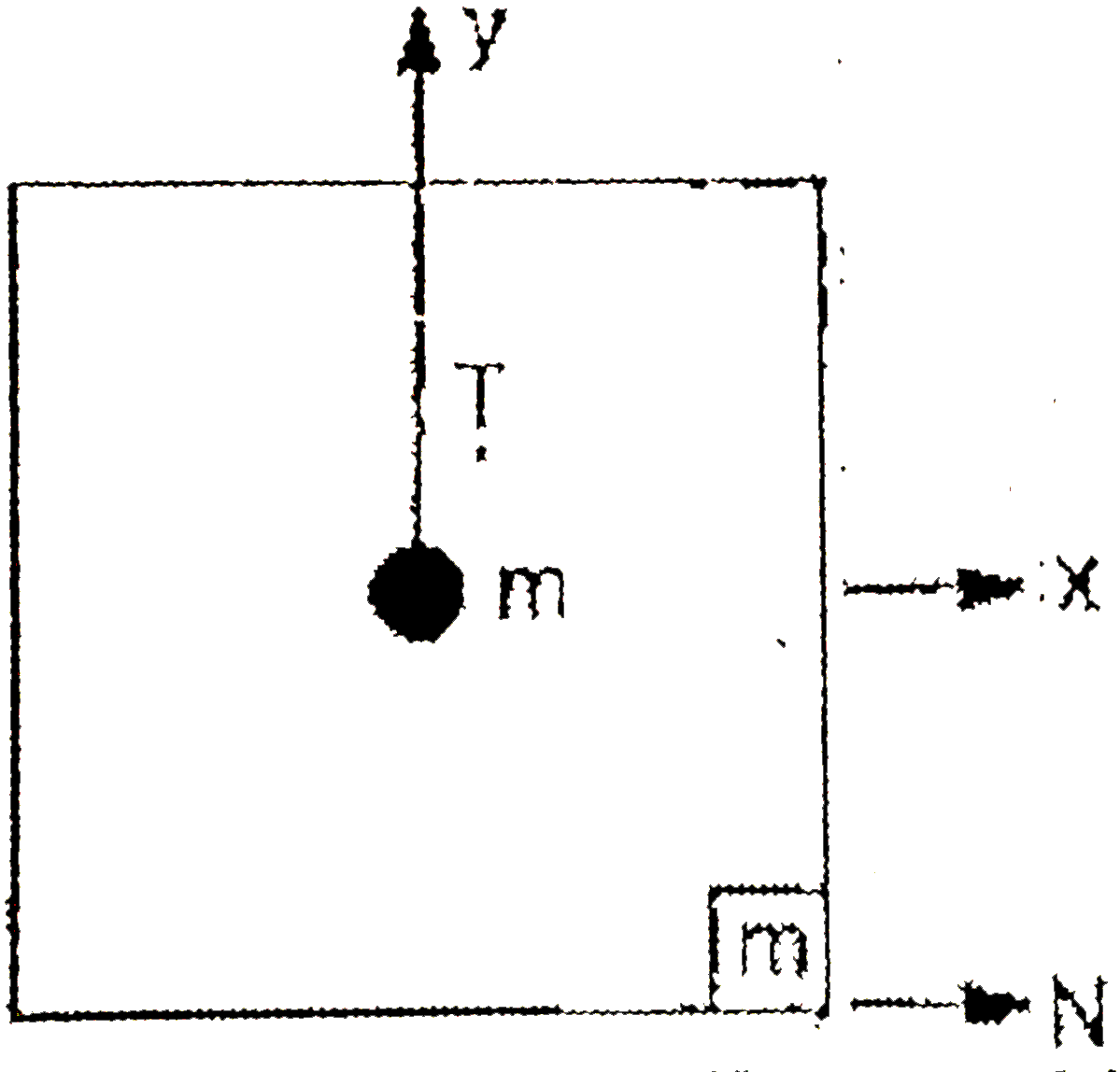
∣∣ ∣ ∣ ∣ ∣ ∣ ∣ ∣ ∣ ∣ ∣ ∣ ∣ ∣ ∣∣Column -1Column -2(A)In figure lift is moving along x-axis(P)zerothen, value of T may be(B)Lift moving toward right along(Q)>mgx-axis with decreasing speed thenvalue of N may be(C)Lift is moving in upward direction(R)<mg(y-axis) then value of T may be(D)Lift is moving in downward(S)=mgdirection with constant velocitythen value of T may be∣∣ ∣ ∣ ∣ ∣ ∣ ∣ ∣ ∣ ∣ ∣ ∣ ∣ ∣ ∣∣View SolutionQuestion 233
In the diagram strings, springs and the pulley are light and ideal. The system is in equilibrium with the strings taut (T>0), match the column. Masses are equal.
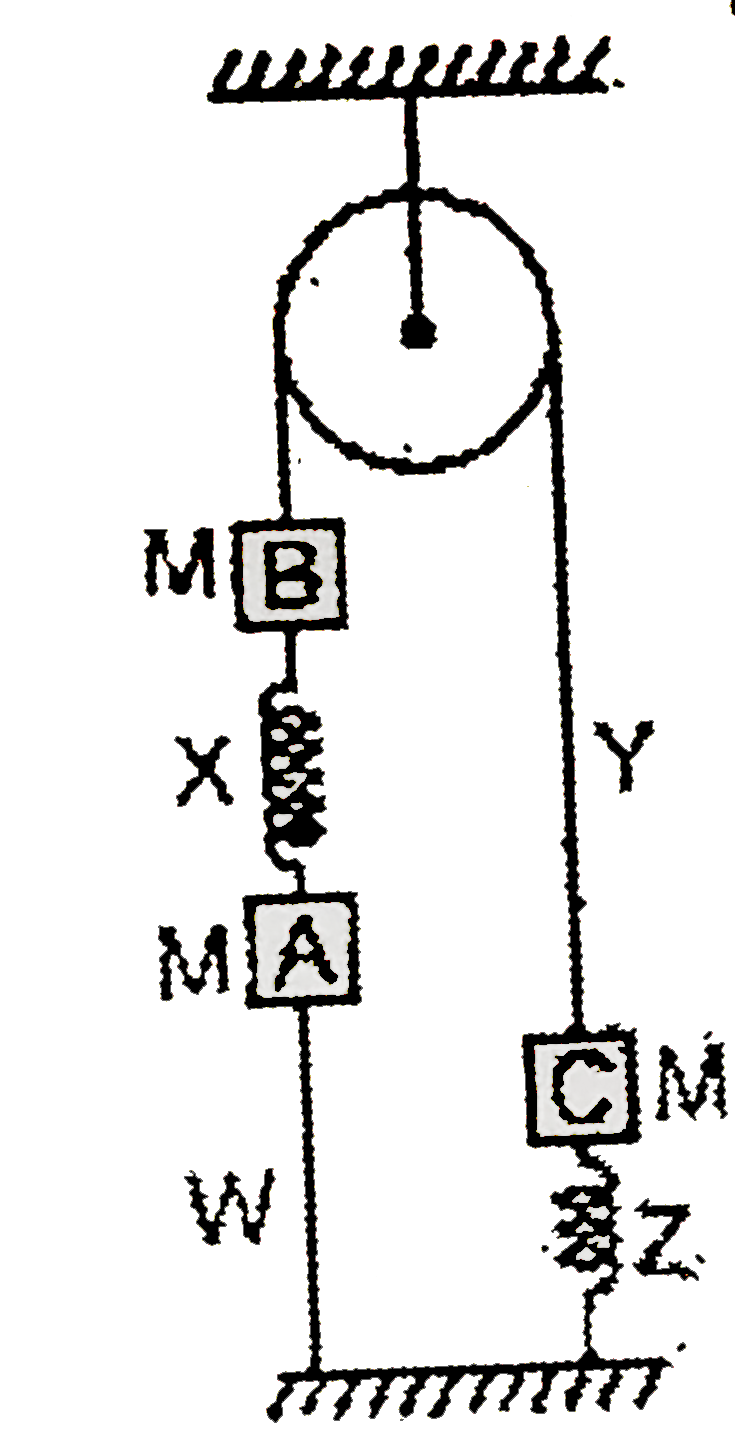
∣∣ ∣ ∣ ∣ ∣ ∣∣Column -1Column -2(A)Just after string W breaks(P)aA=0(B)Just after spring X breaks(Q)aB=0(C)Just after string Y breaks(R)aC=0(D)Just after spring Z breaks(S)aB=aC∣∣ ∣ ∣ ∣ ∣ ∣∣View SolutionQuestion 235
See the diagrams carefully in Column-1 and match each with the obeying relation (S) in column-2. The string is massless, inextensible and pulley is frictionless in each case. a=g/3, m= mass of block T = tension in a given string, apulley= acceleration of movable pulley in each case, acceleration due to gravity is g.
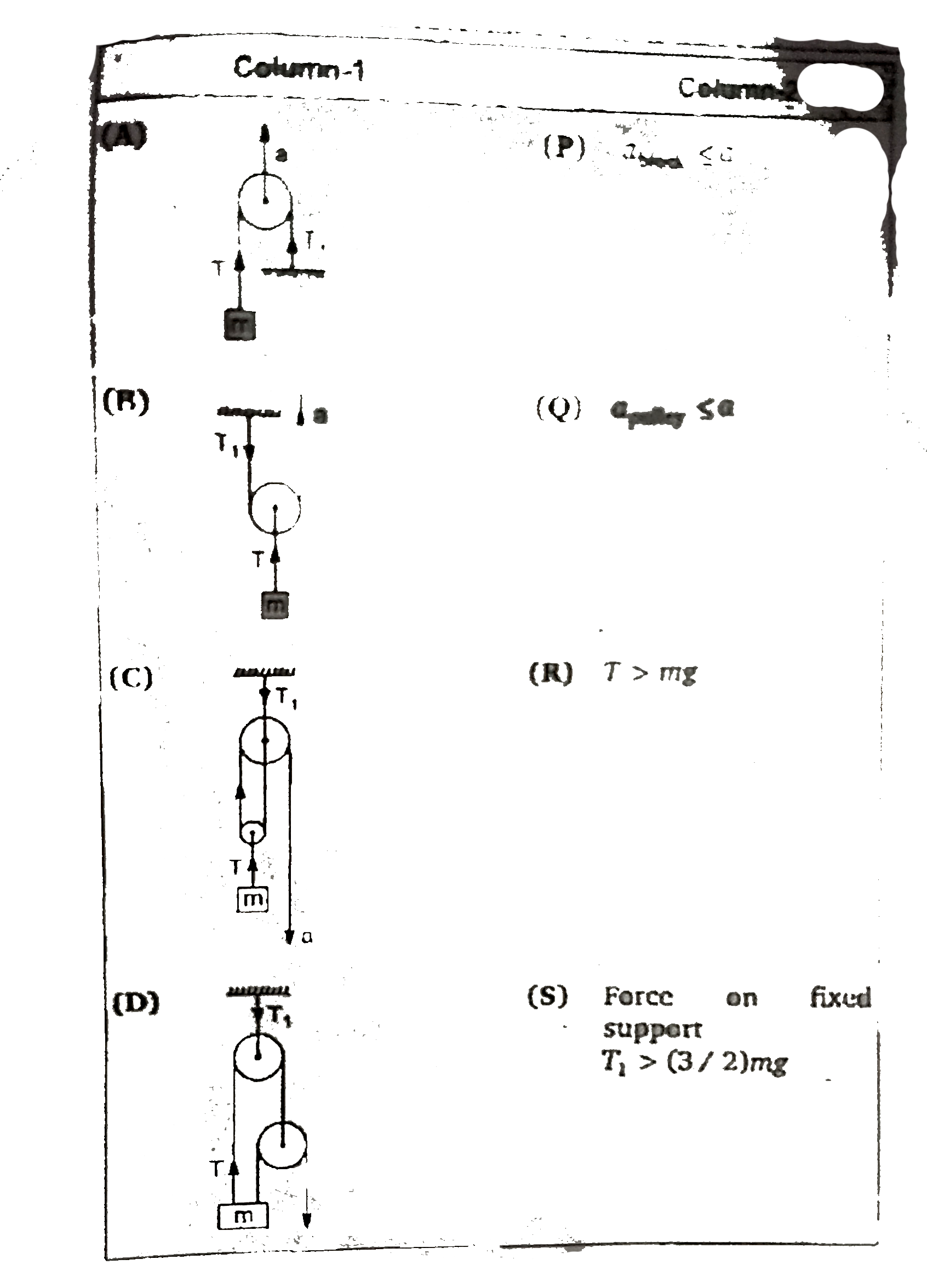 View Solution
View SolutionQuestion 236
A block is placed on a rough horizontal surface. A constant force F is acting on the block as shown in the figure.
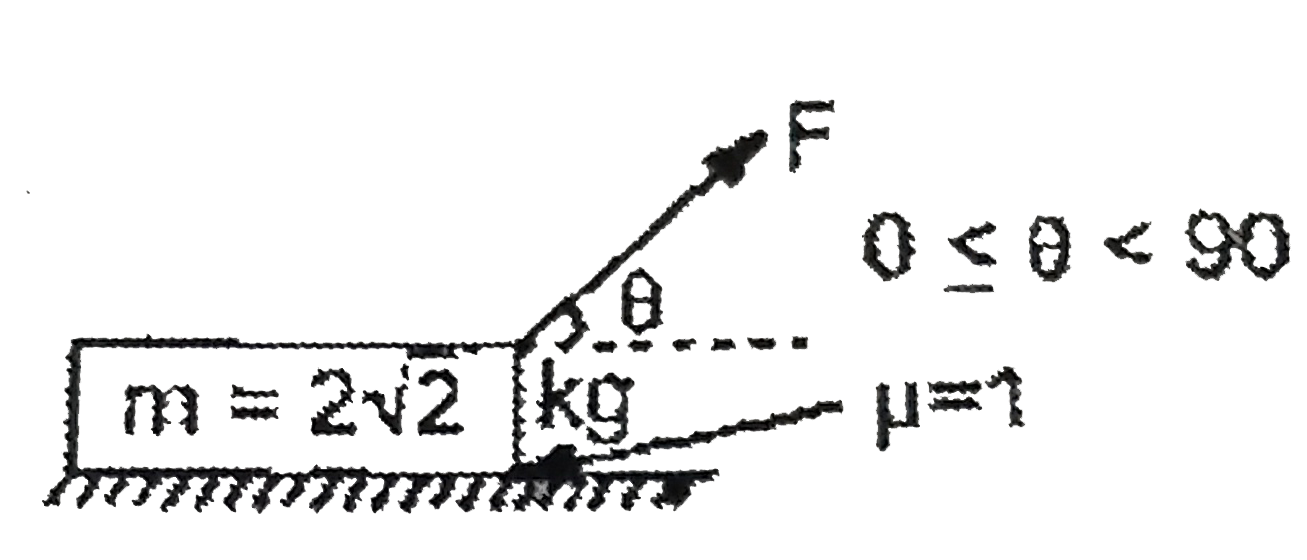
Column-1 gives the magnitude of force F and column-2 gives information about friction acting on the block. Match the entries in column-1 to all possible entries in column-2.
View Solution

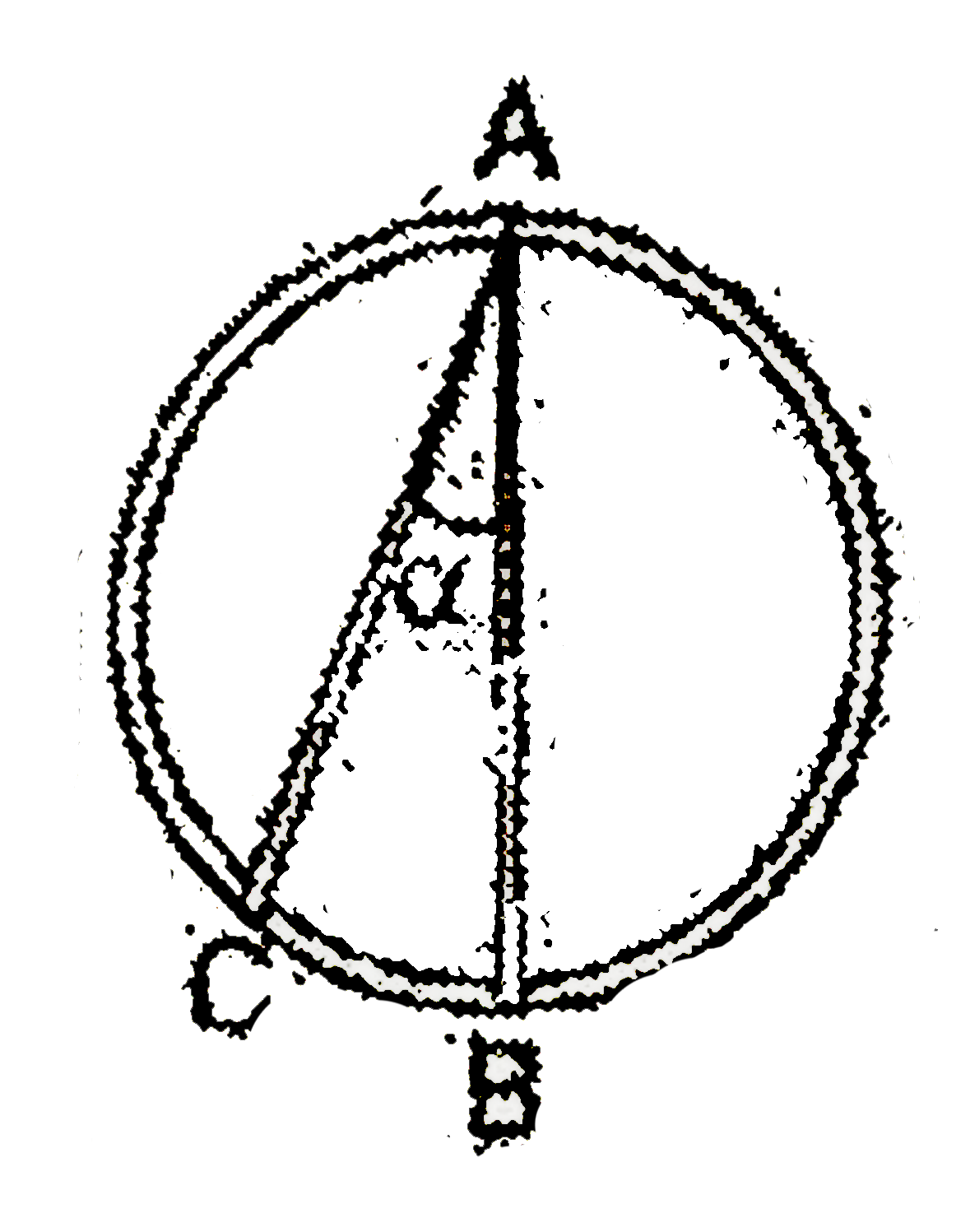
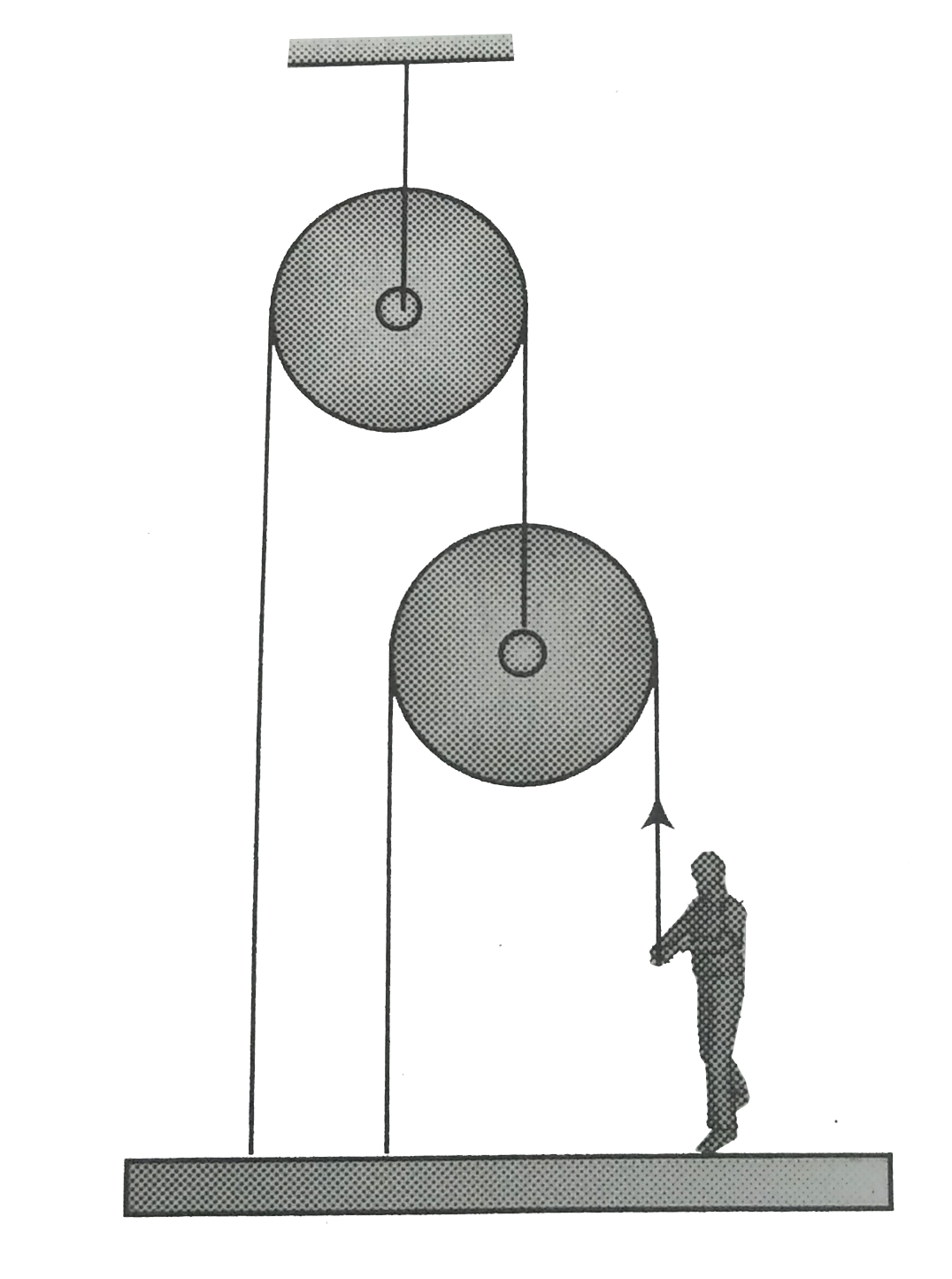

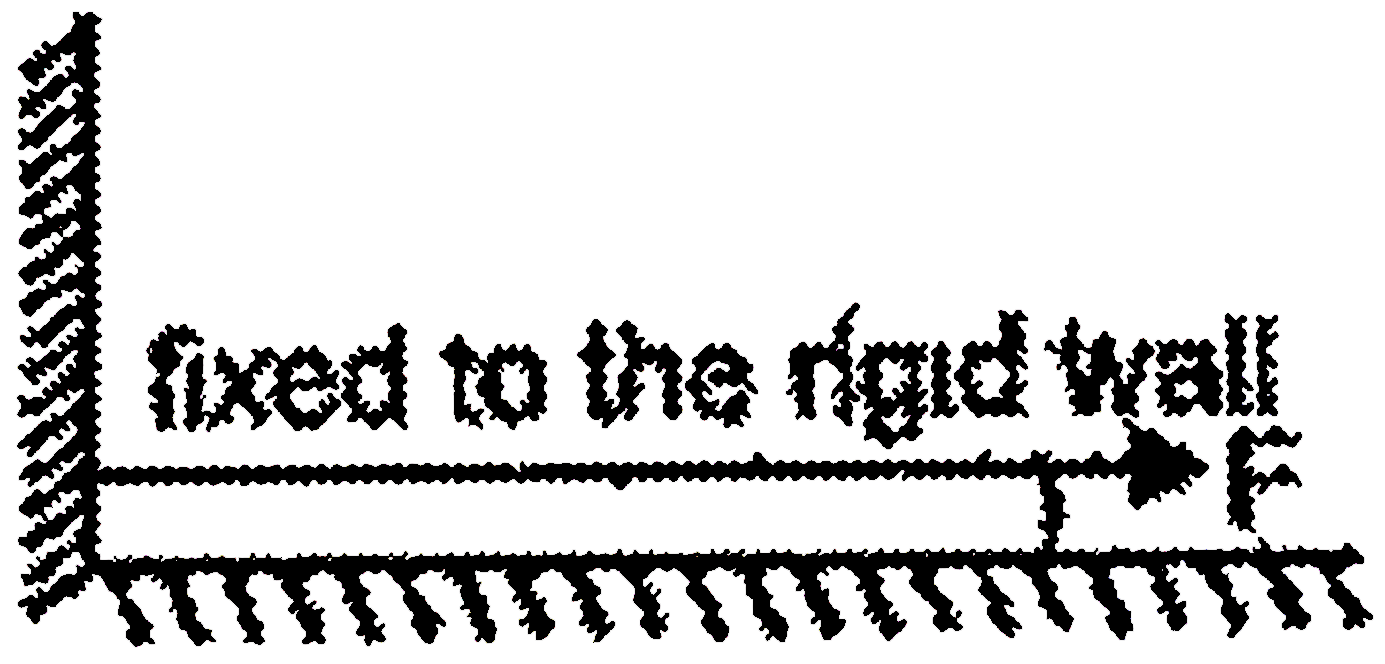
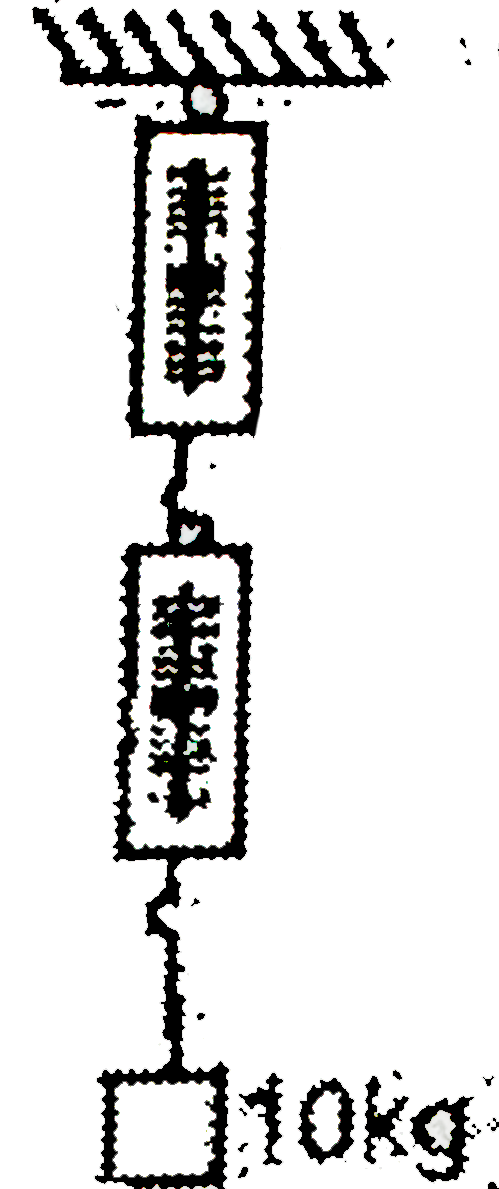
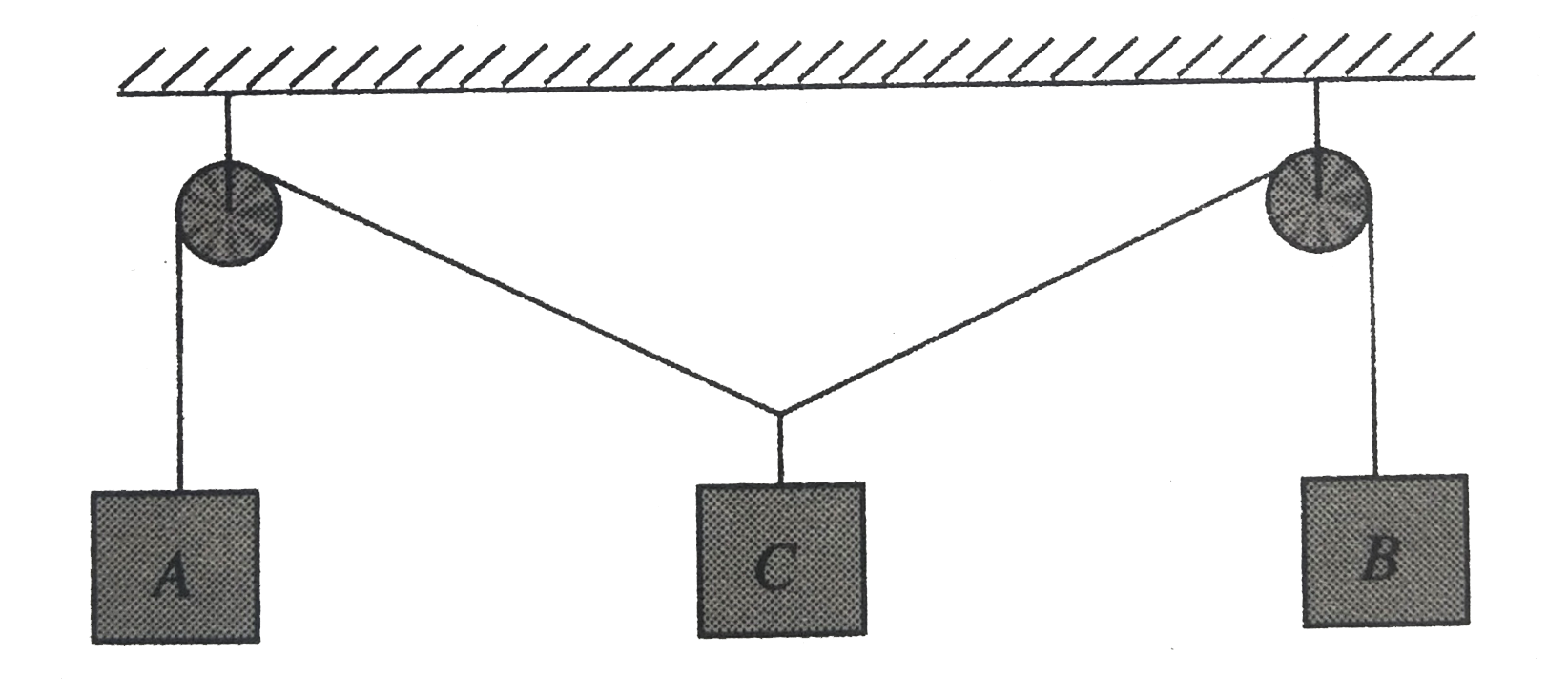

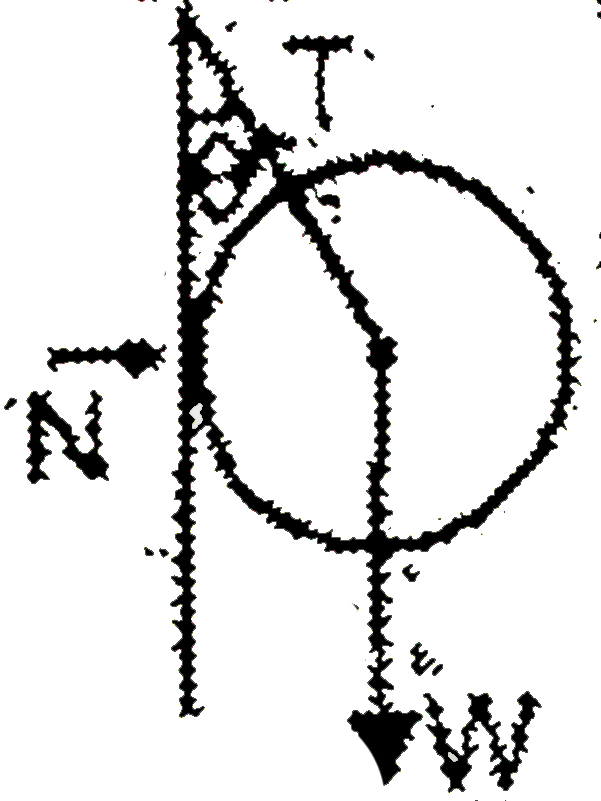
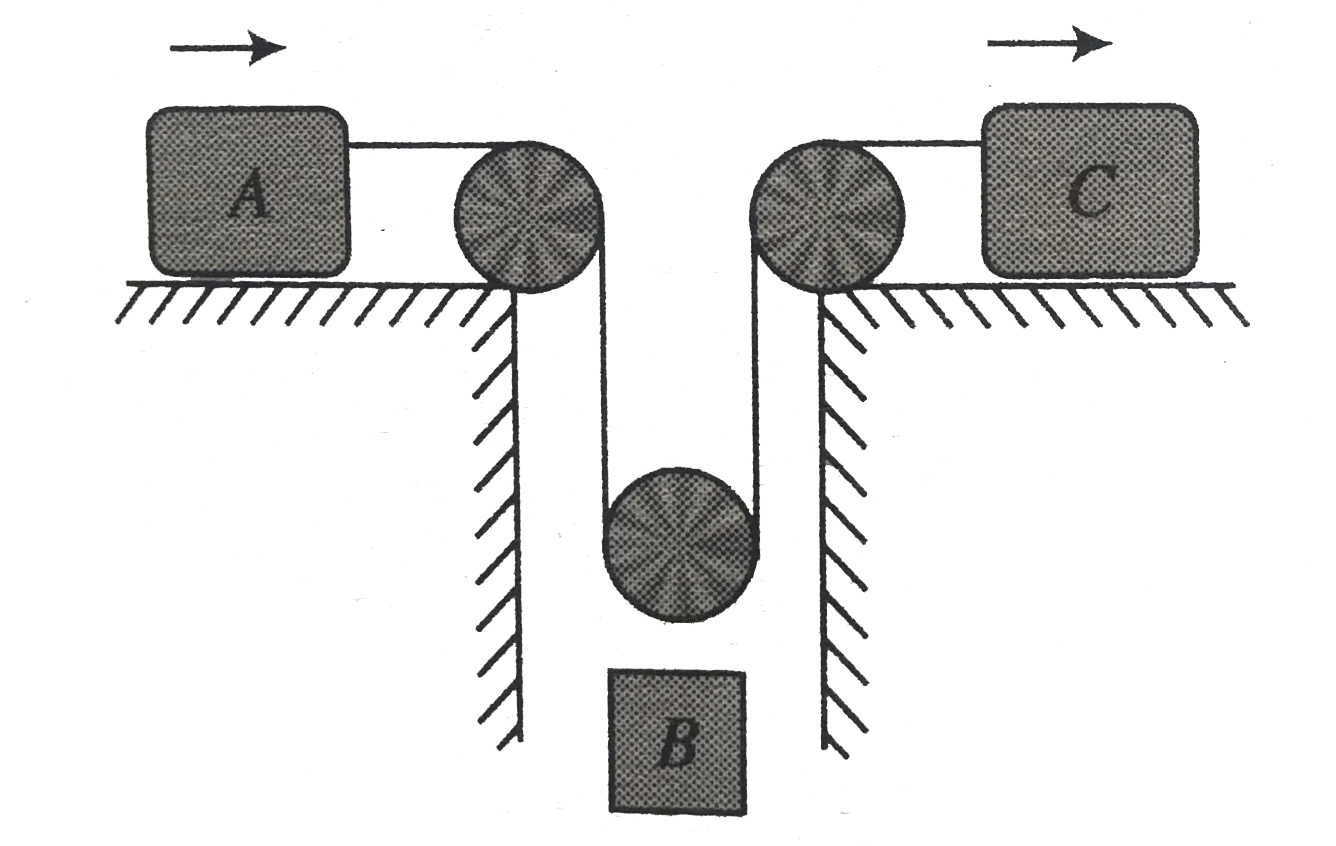
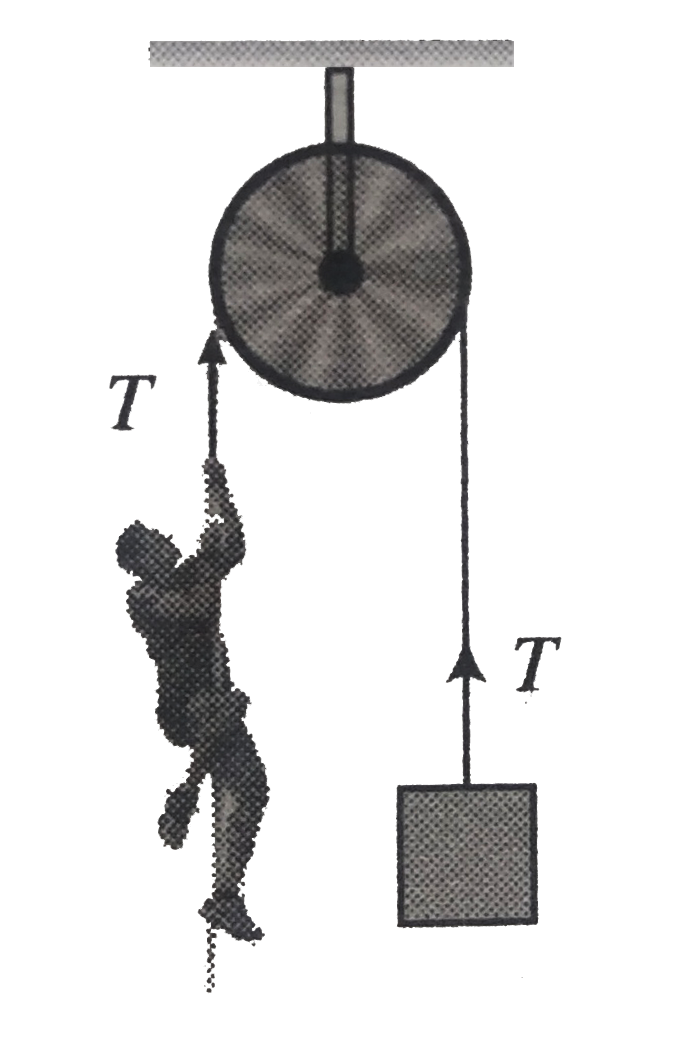

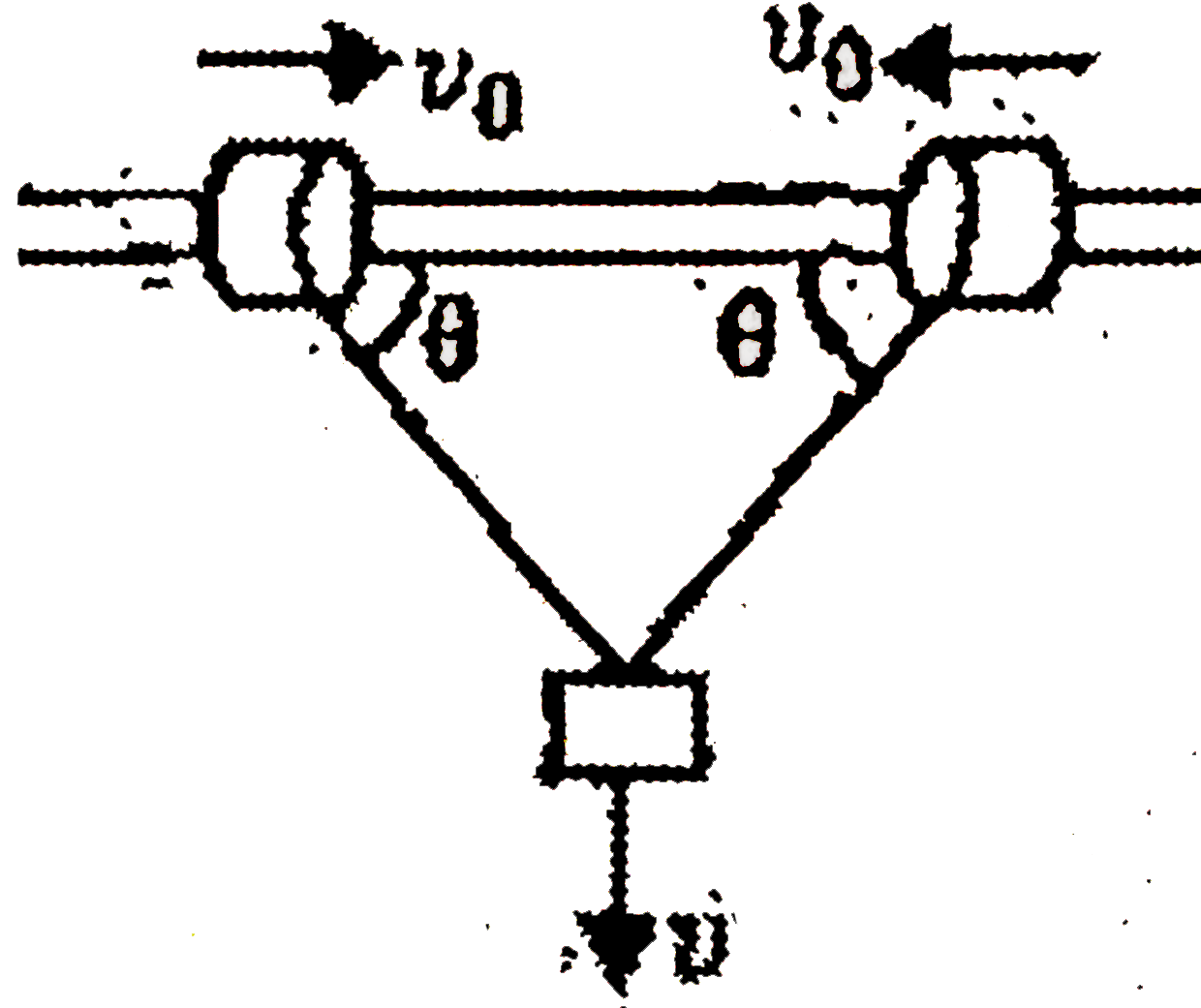
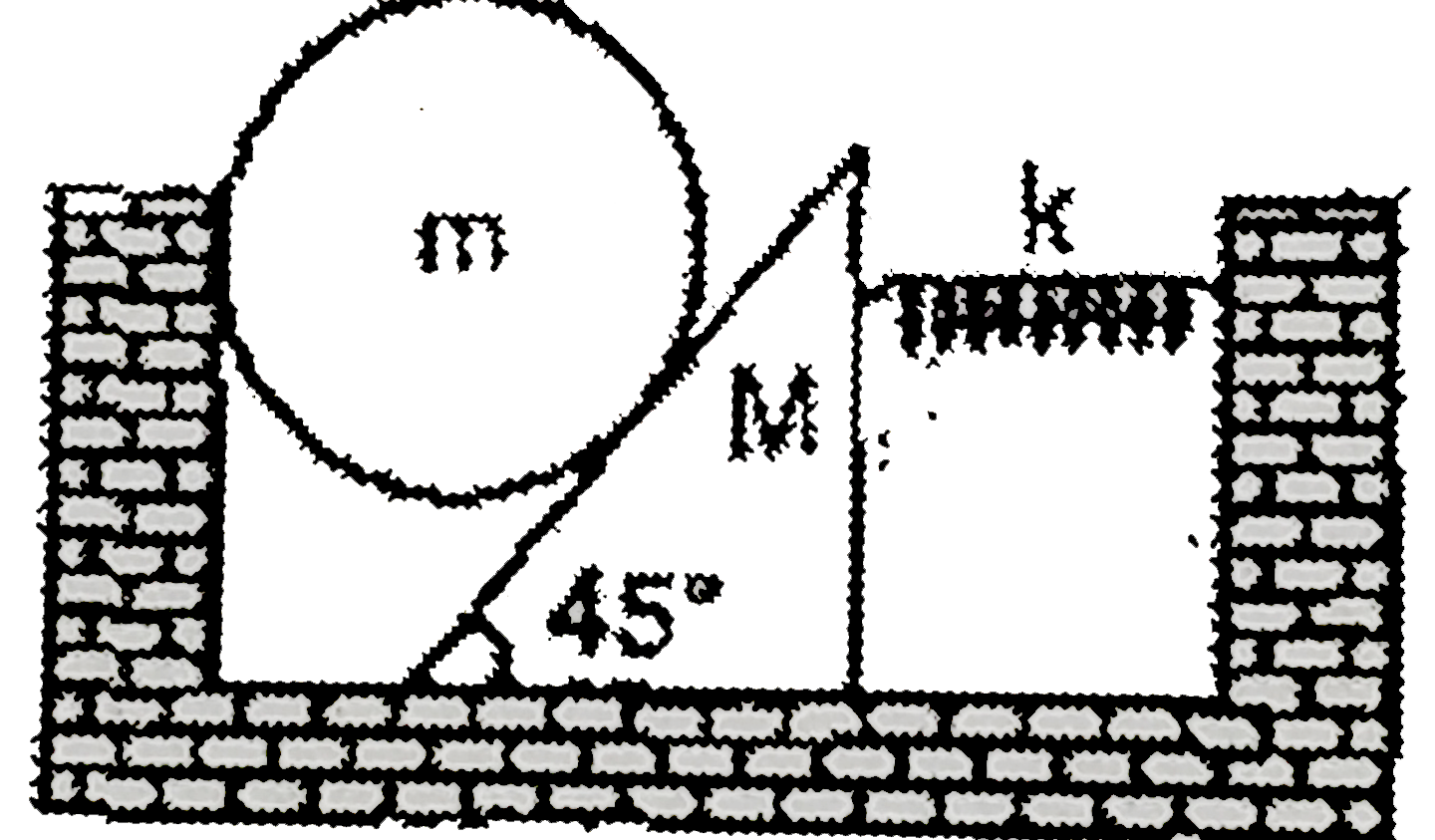
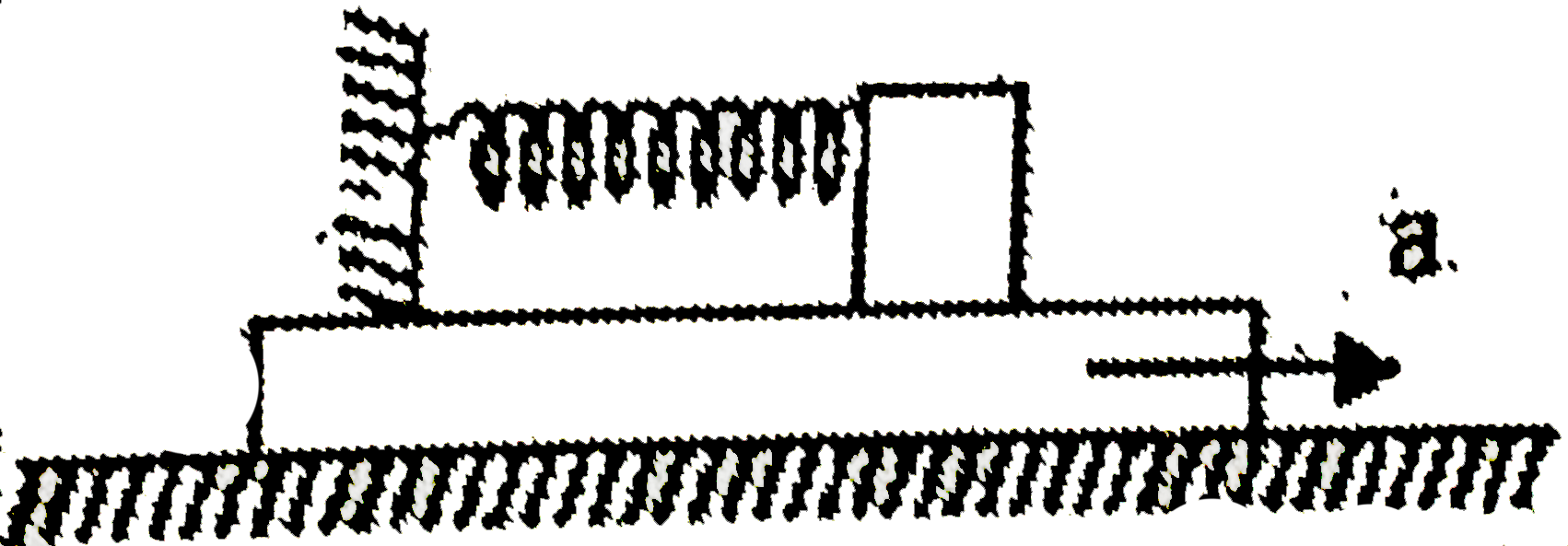
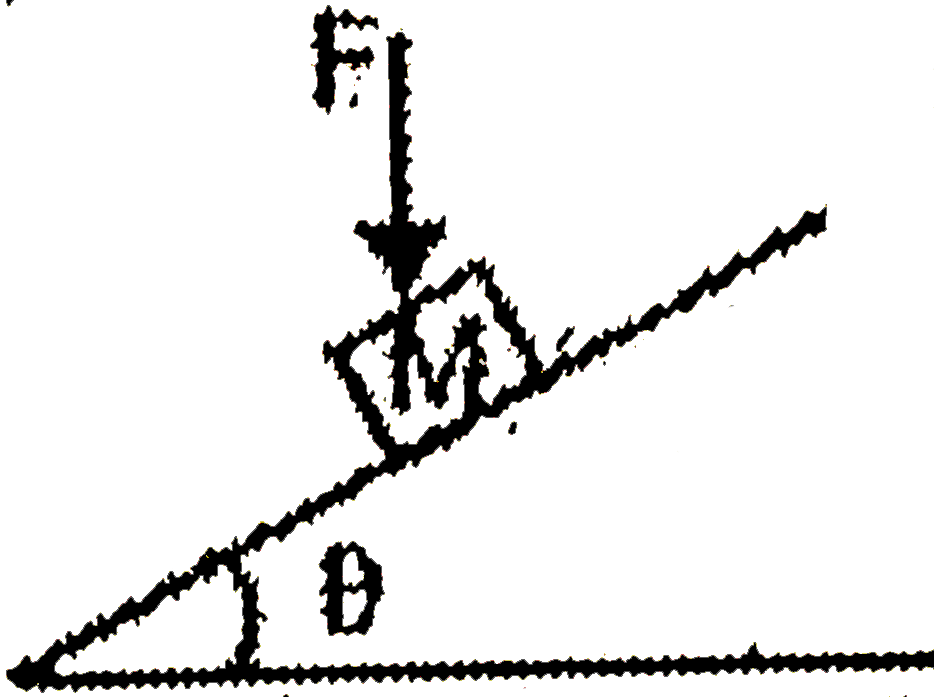
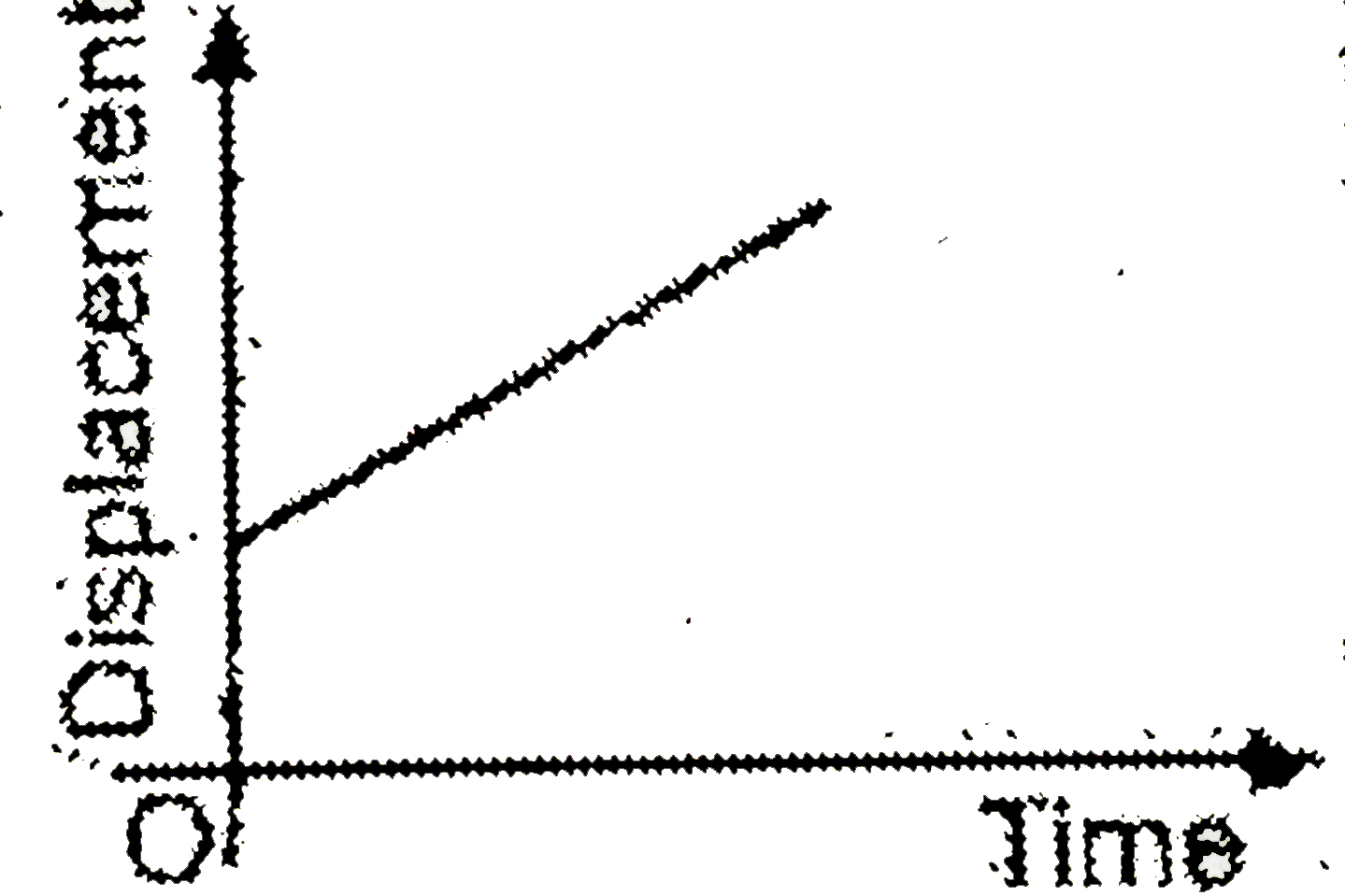
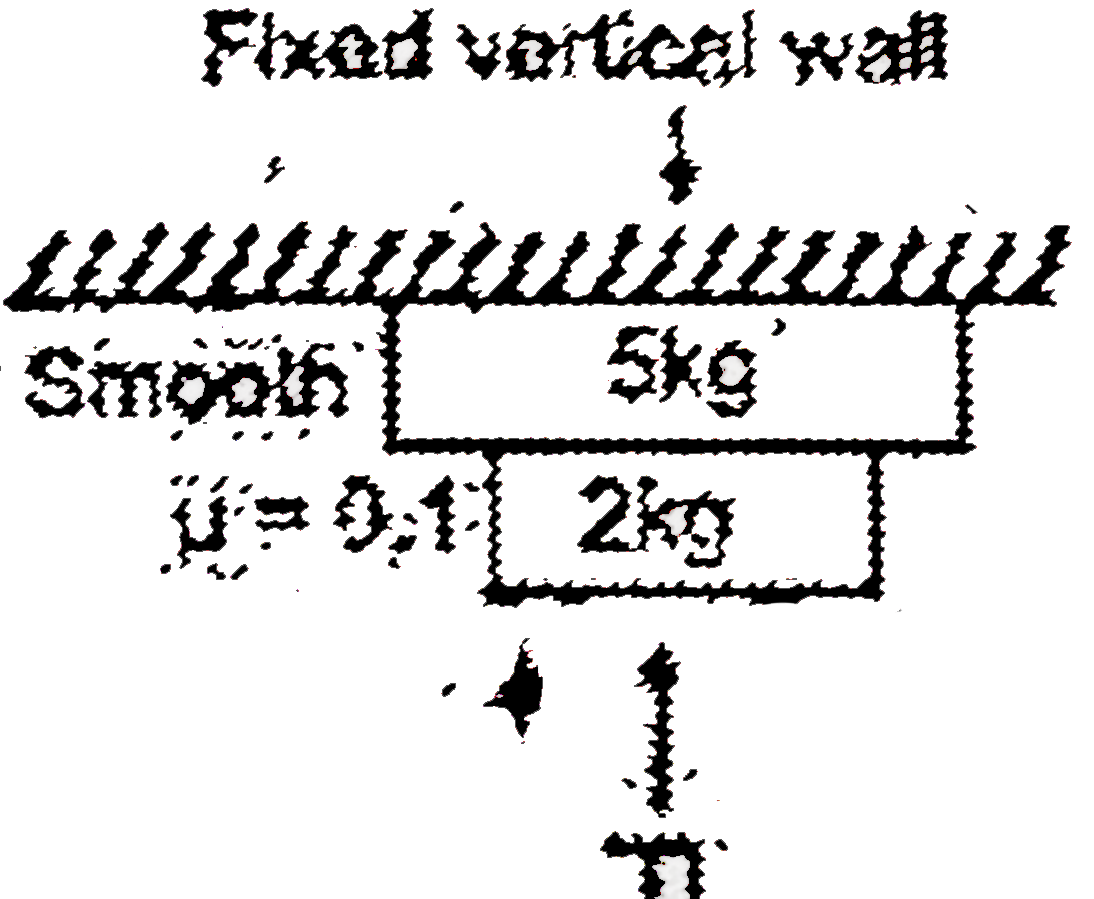

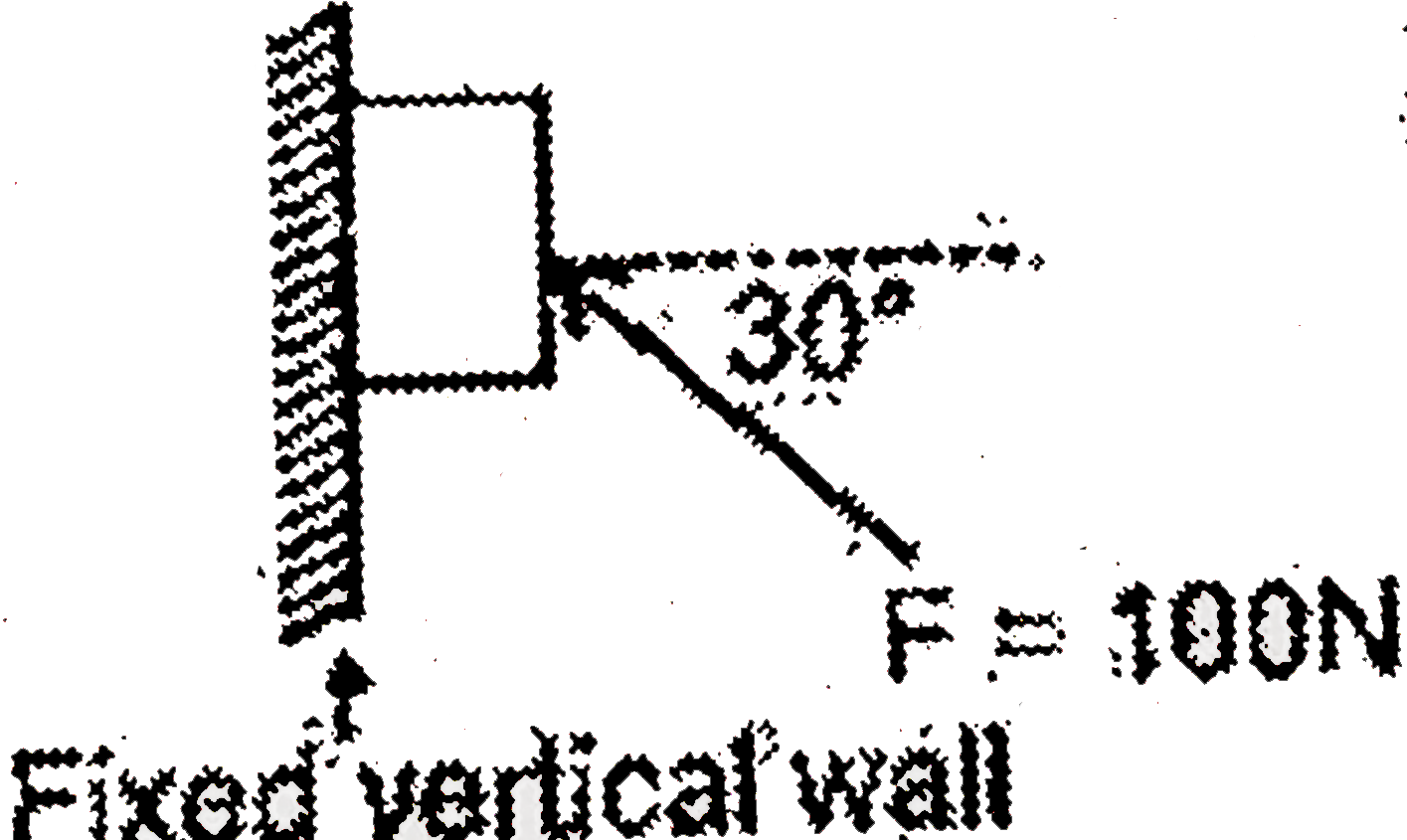
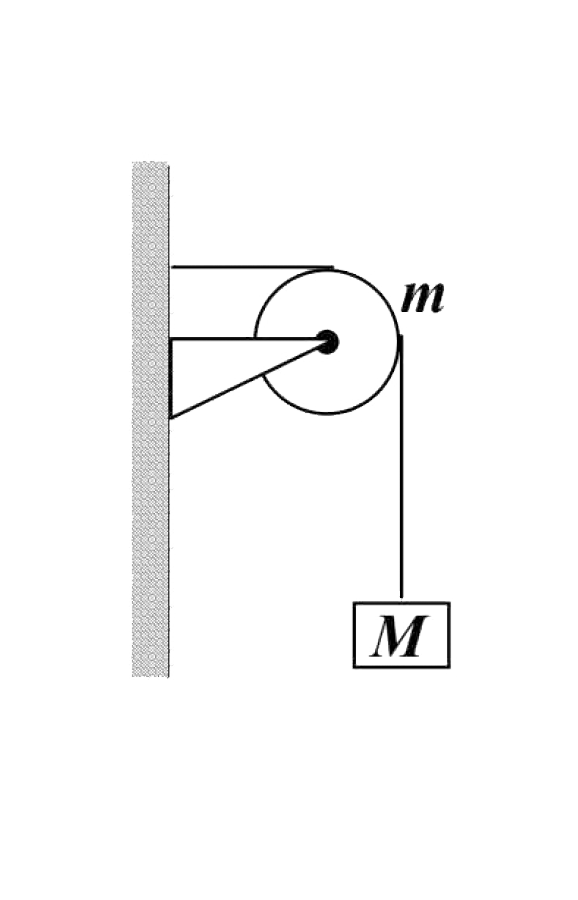
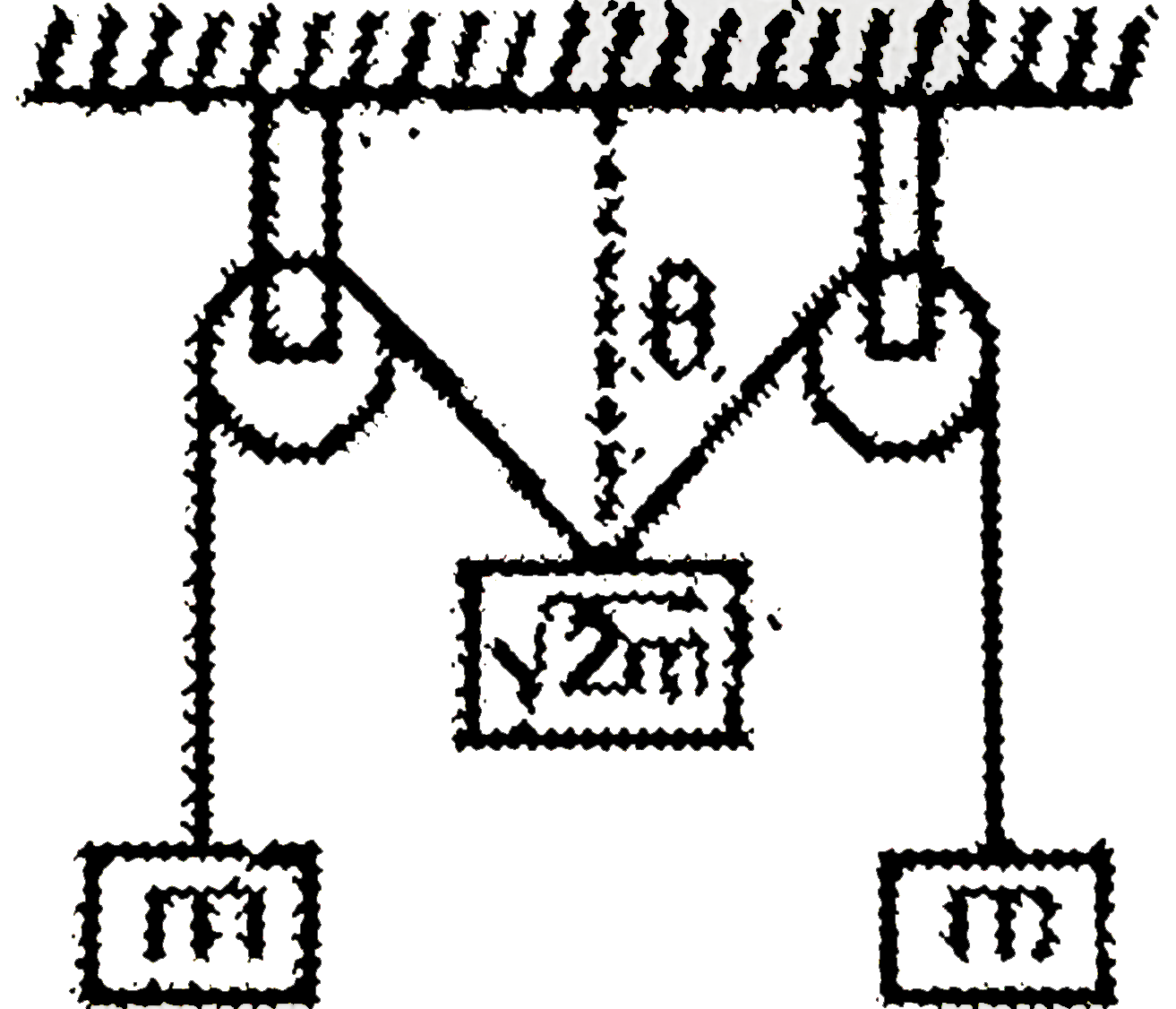


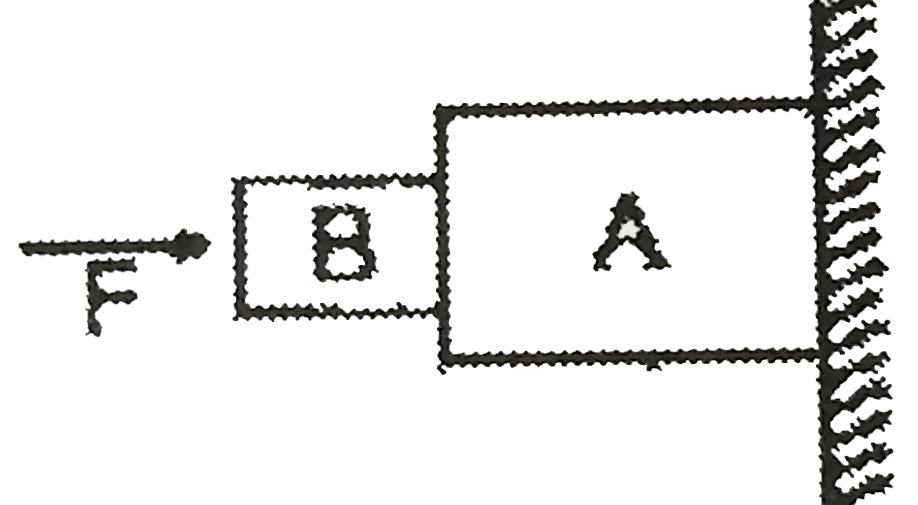
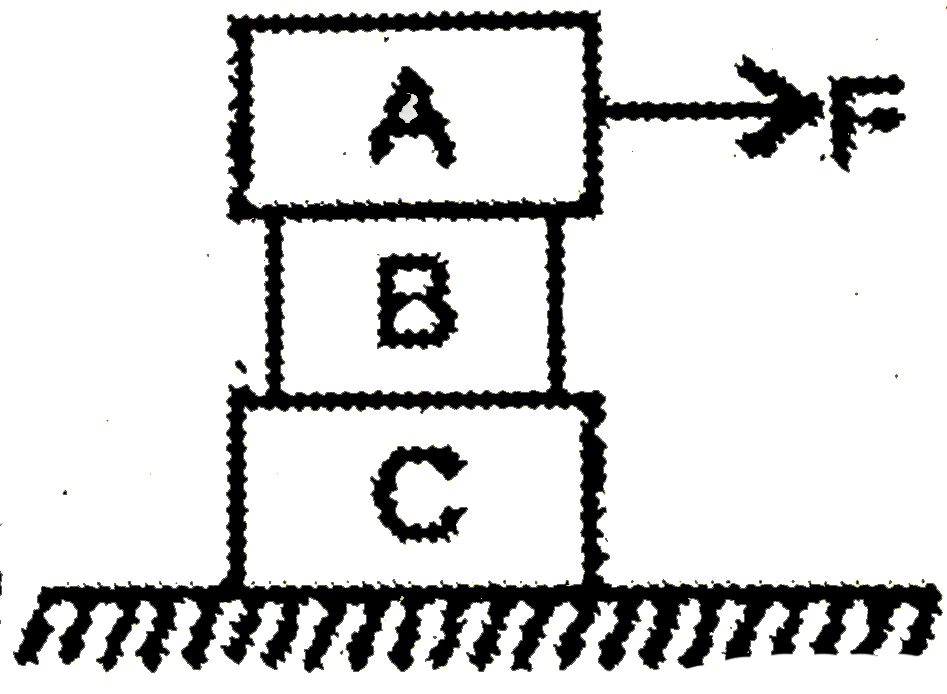
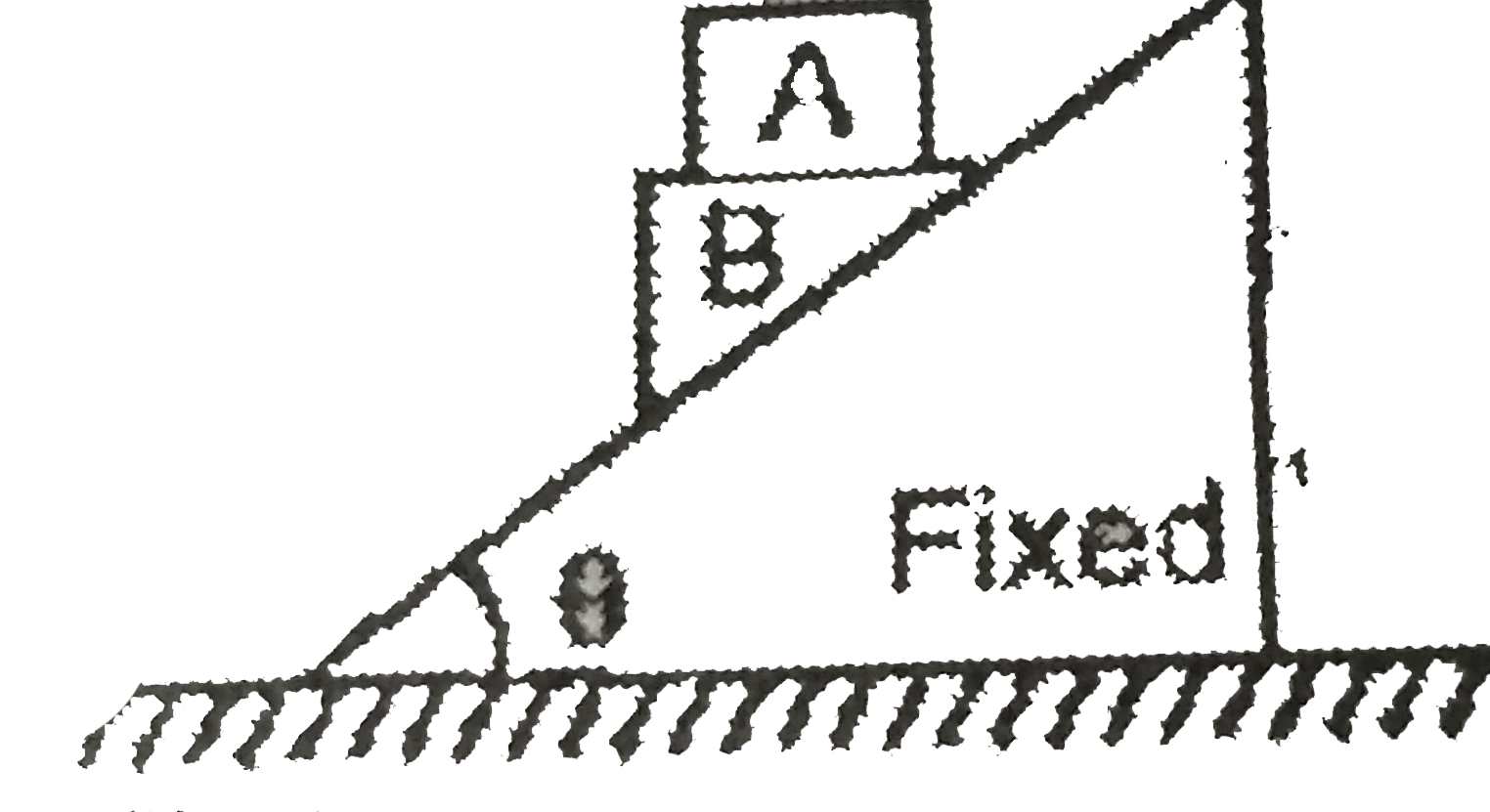

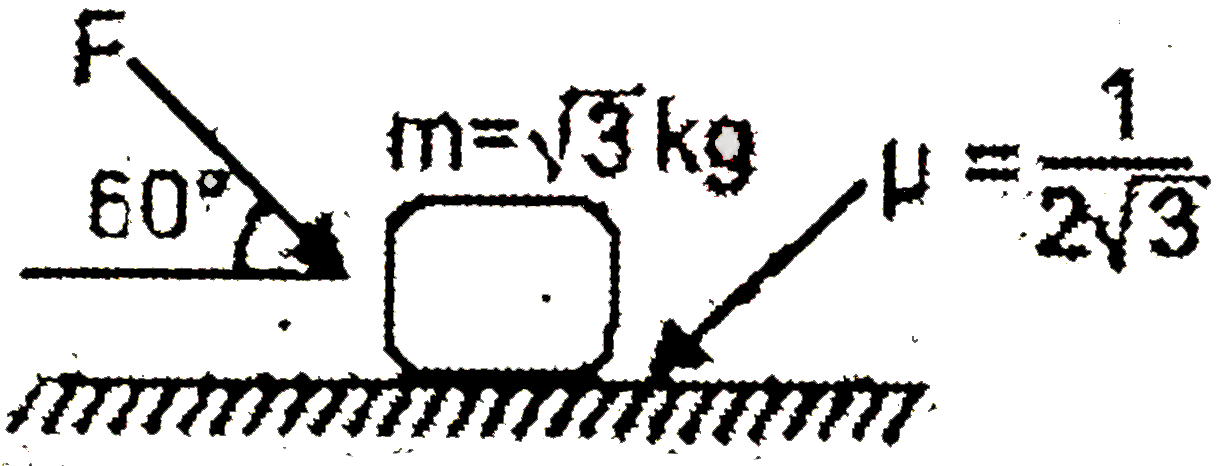
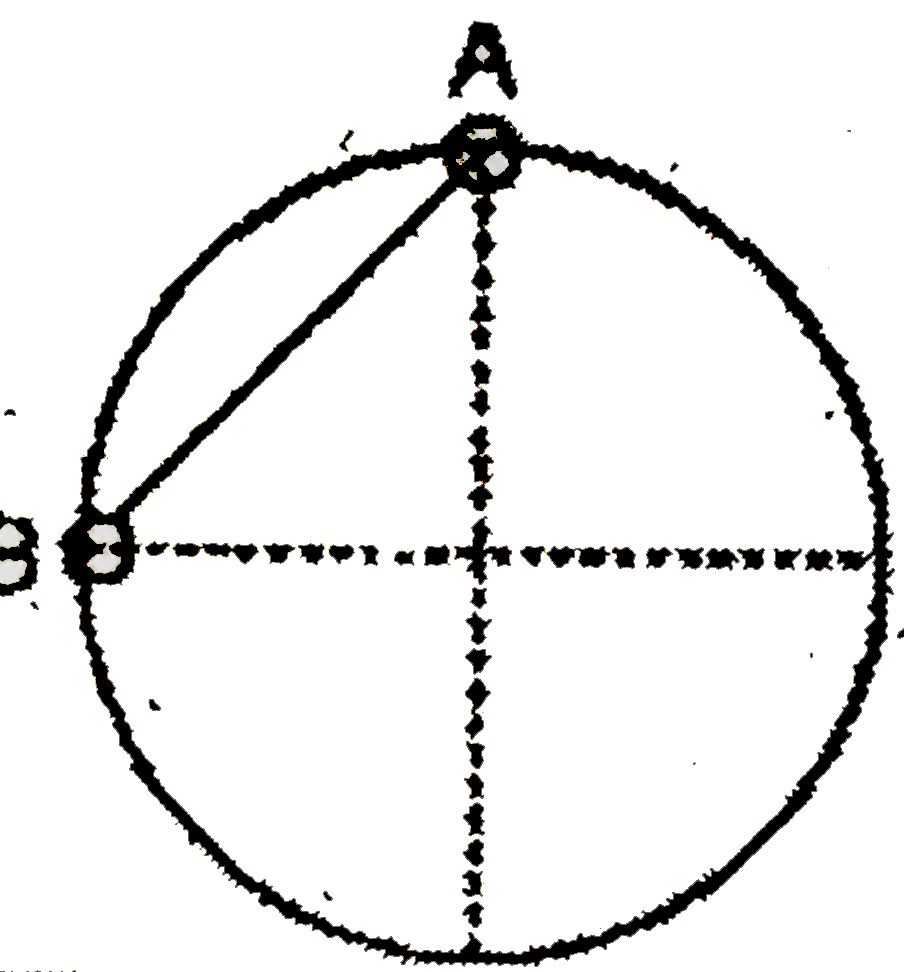
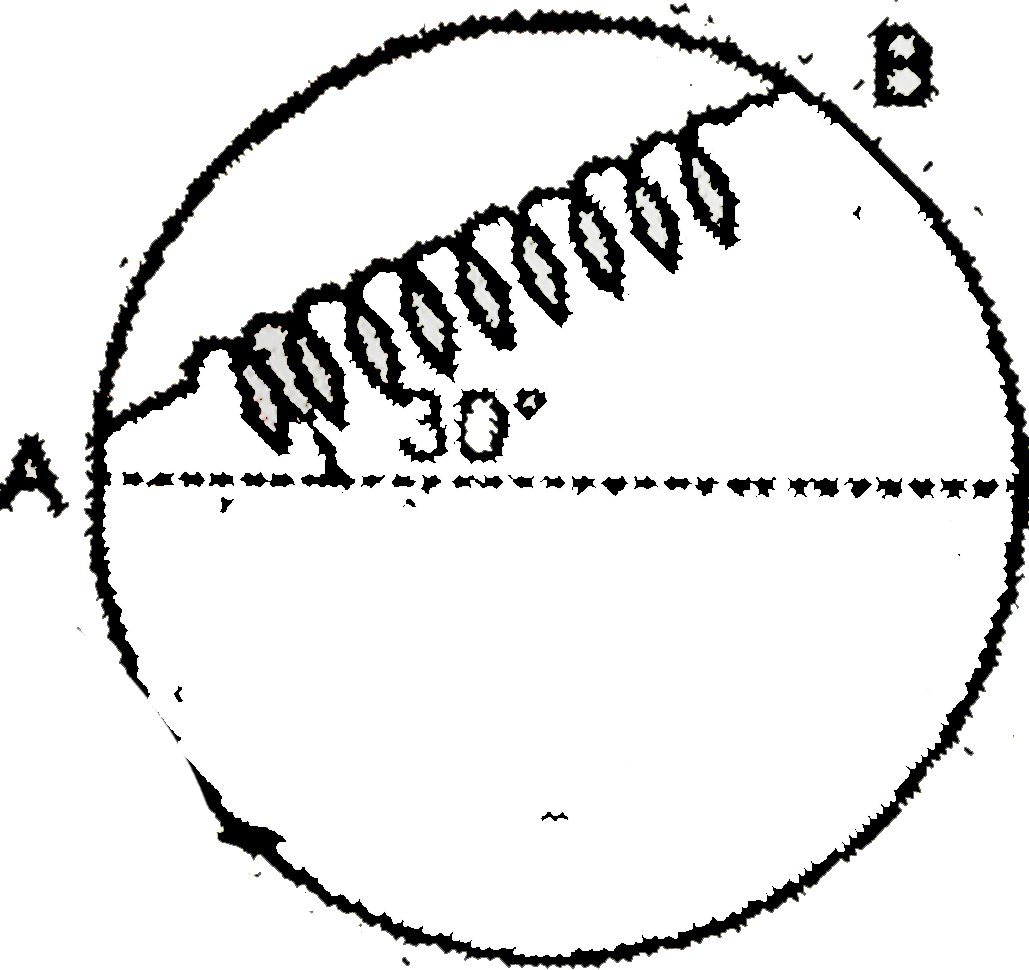

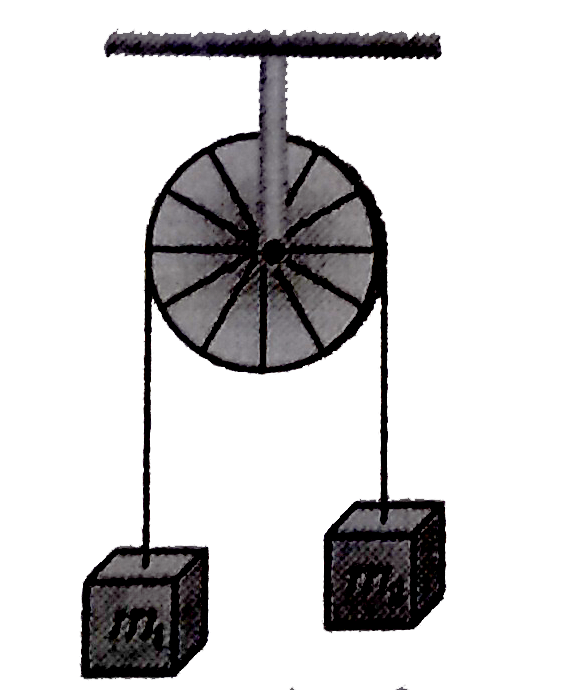
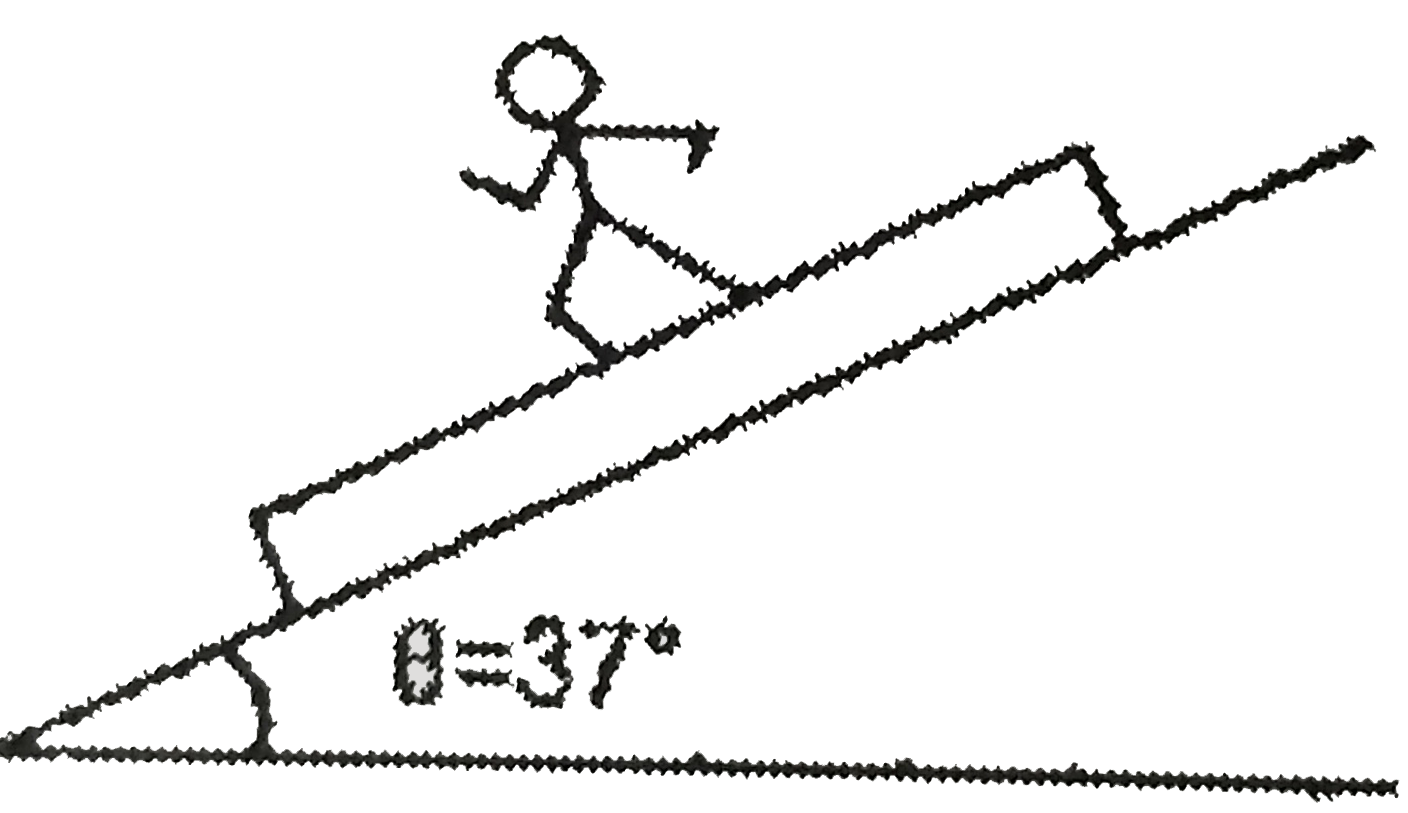
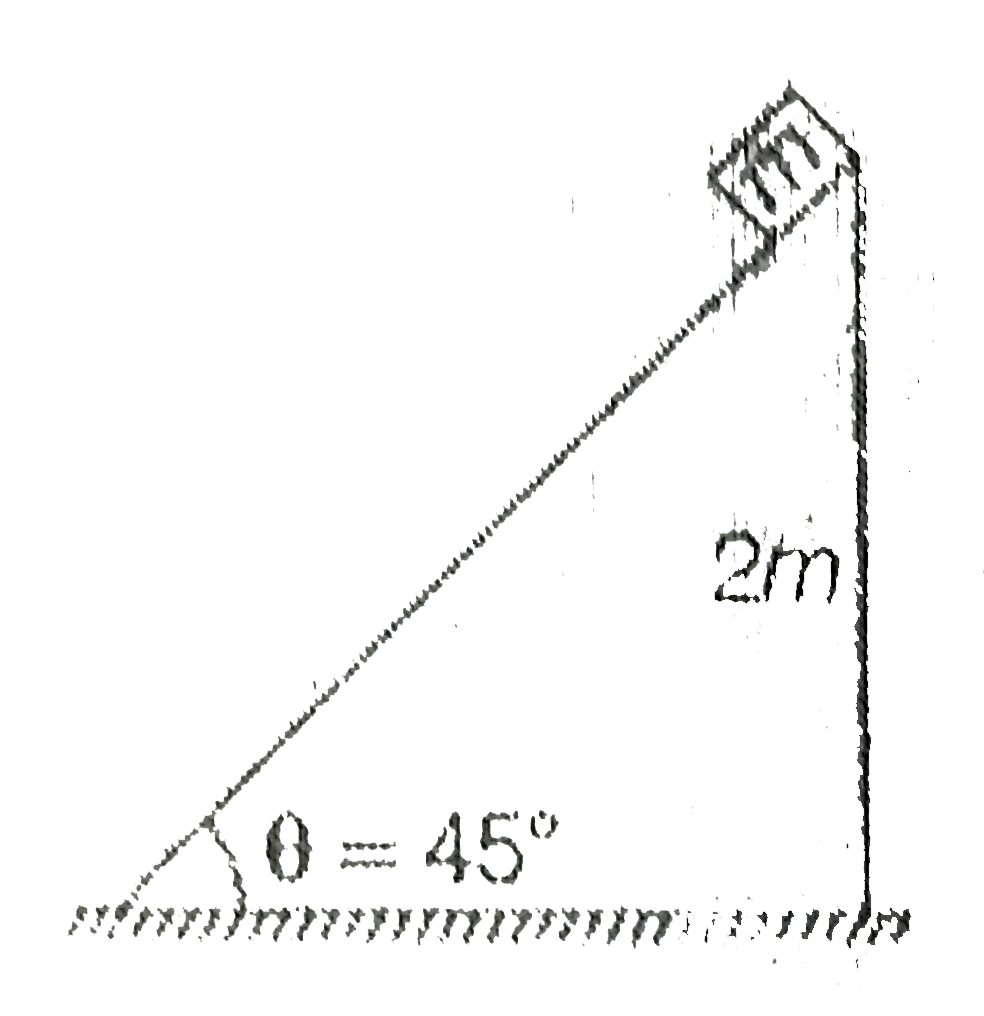

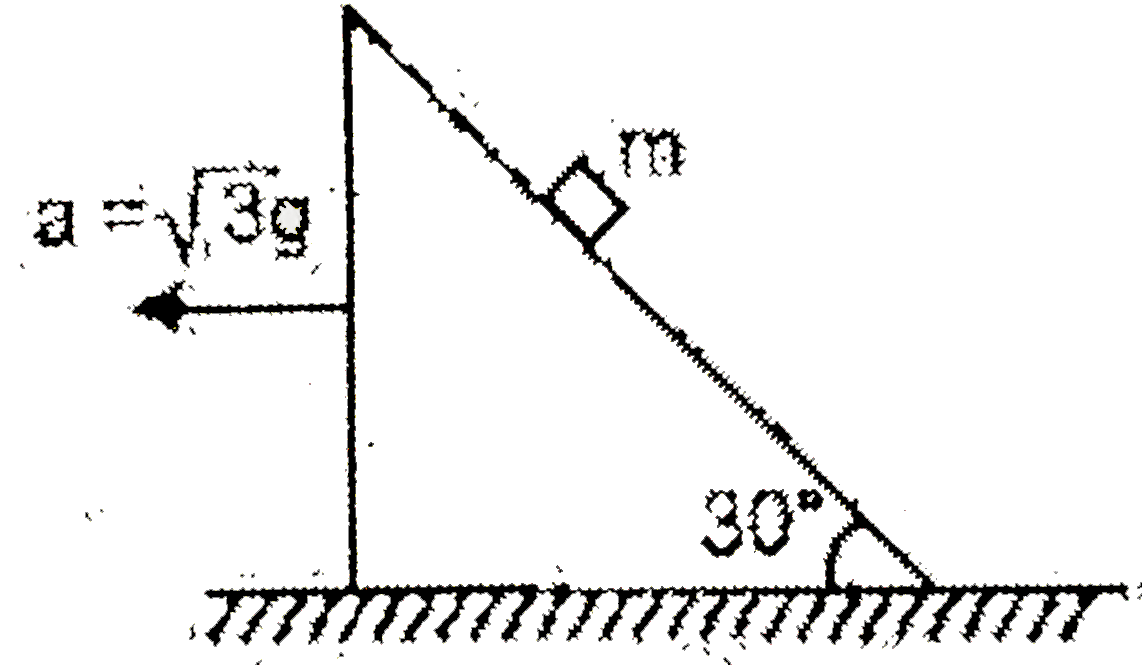
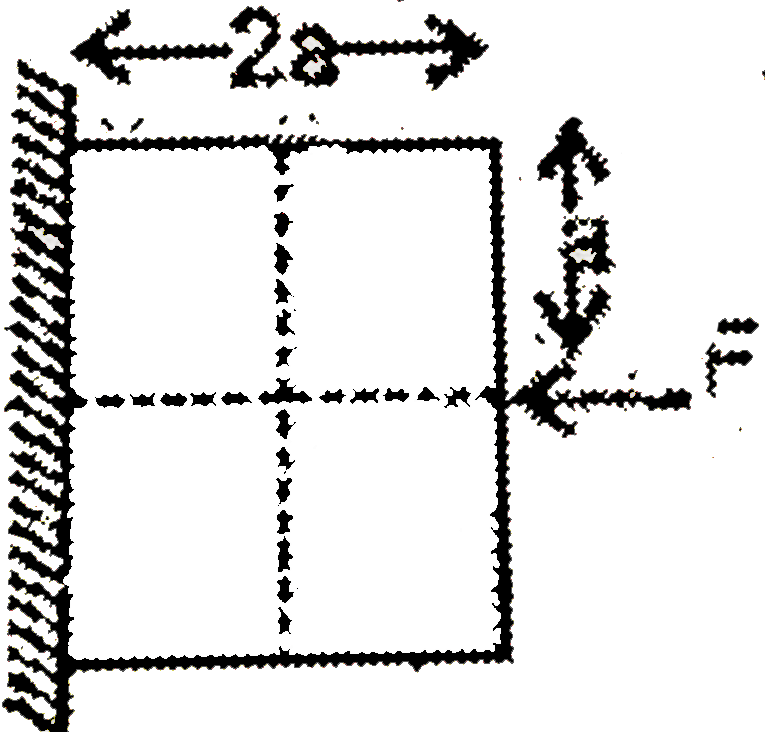
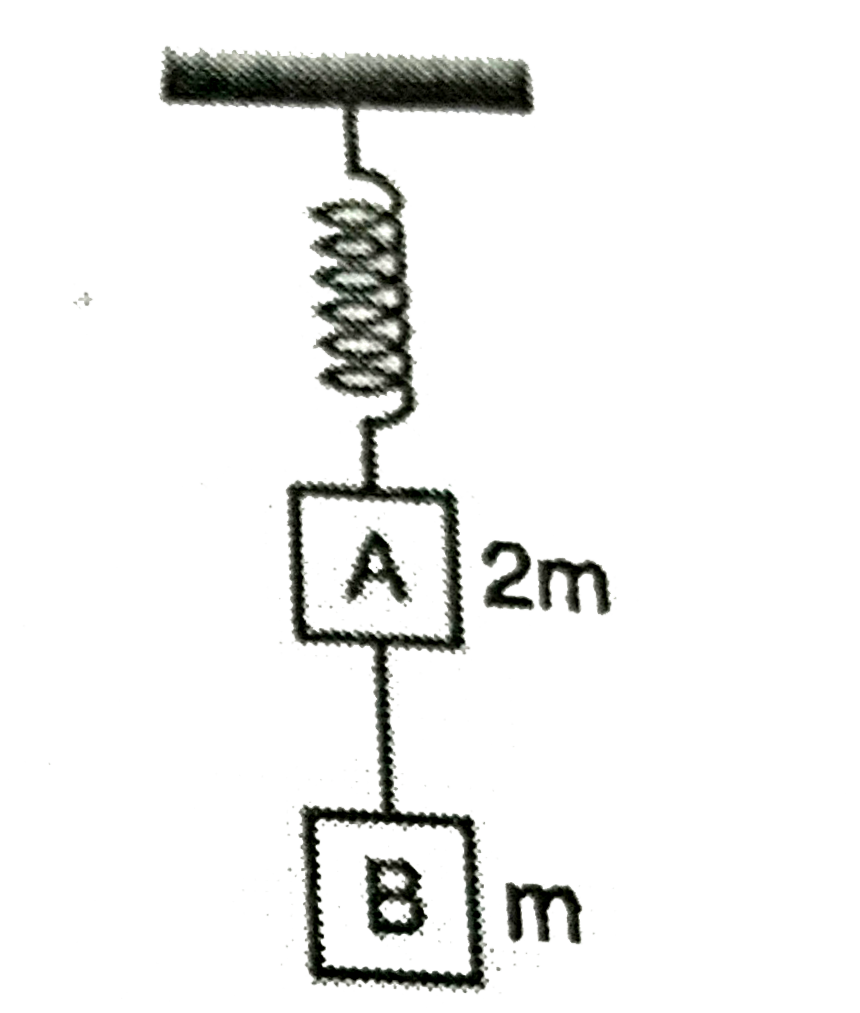

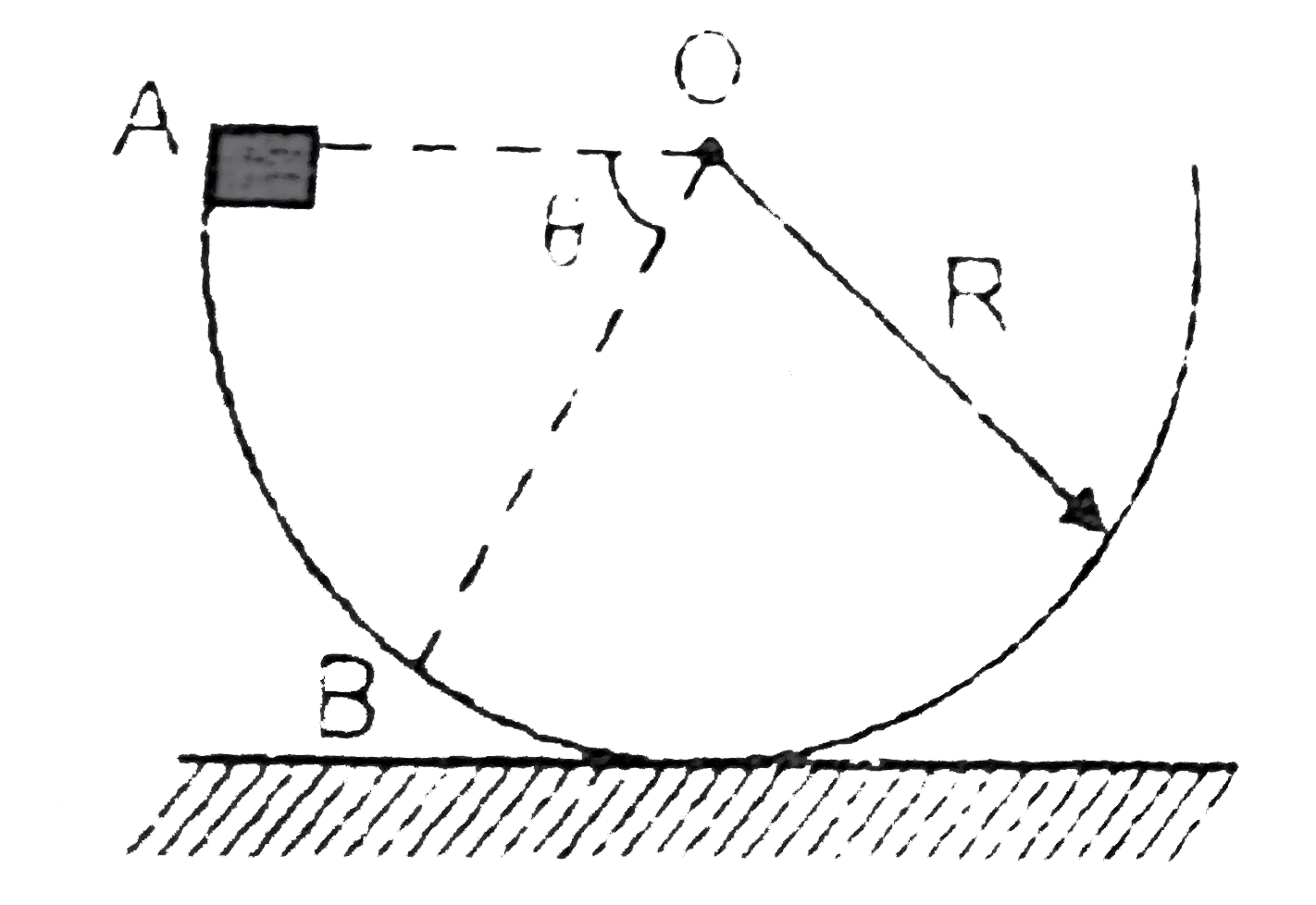
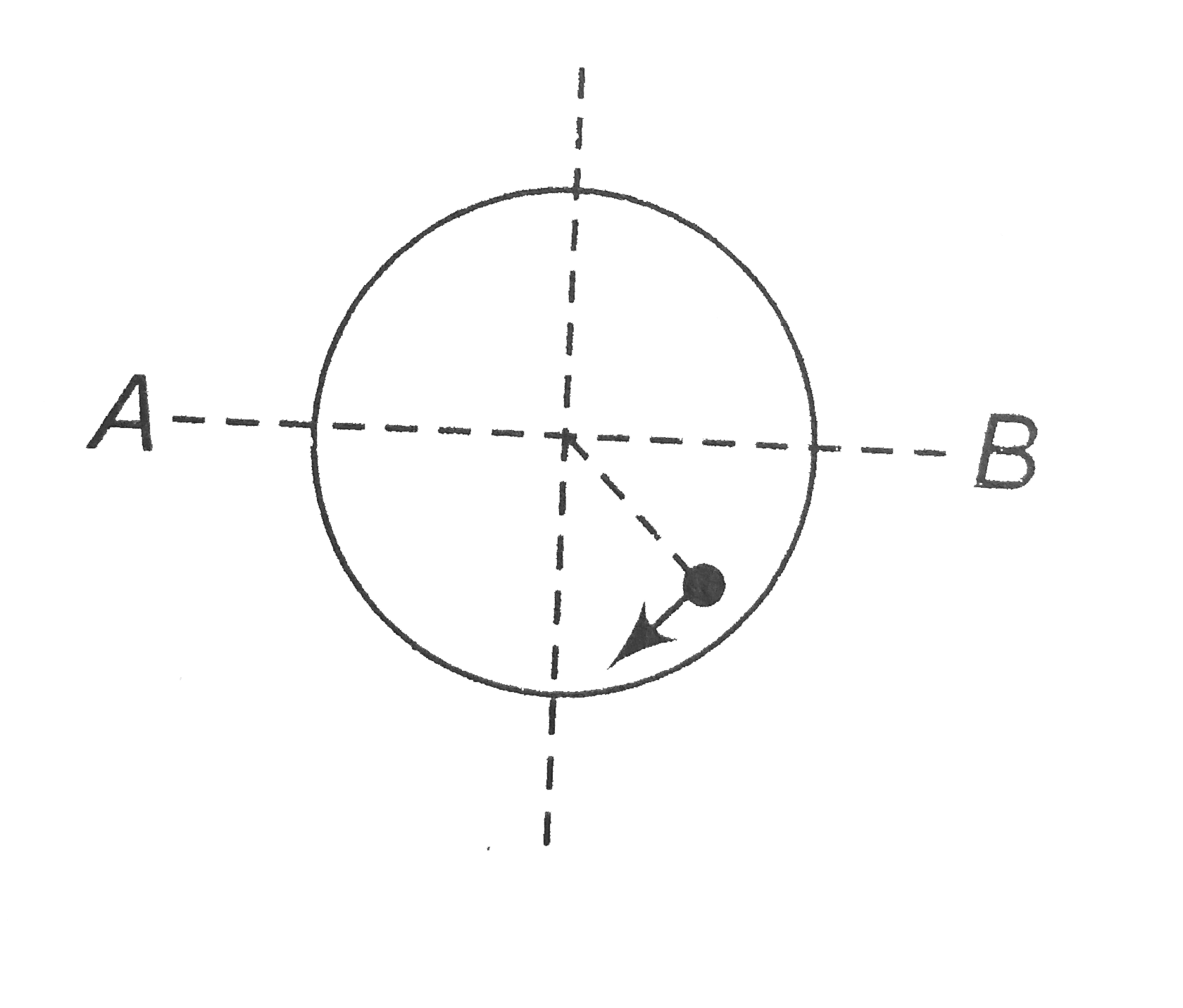



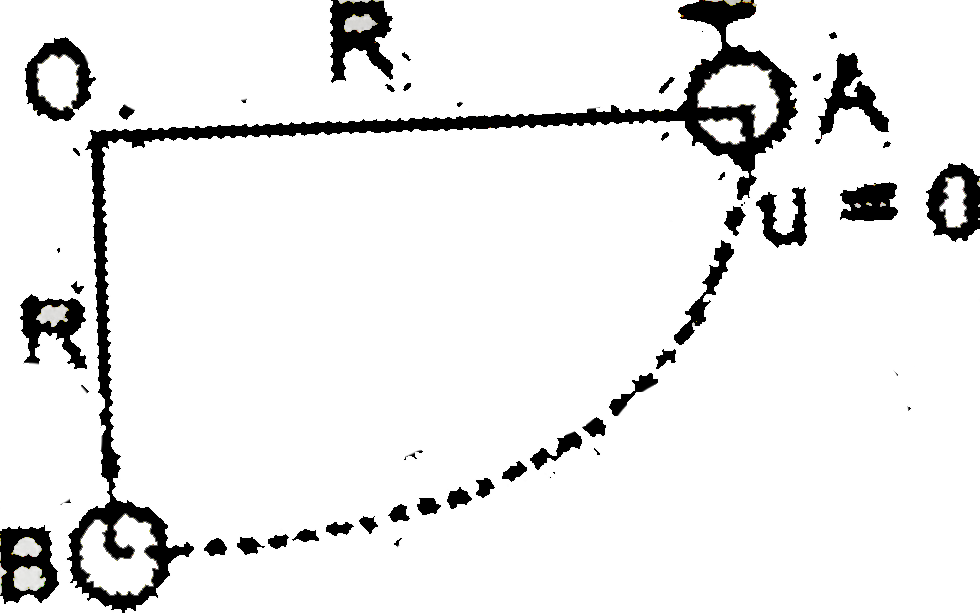
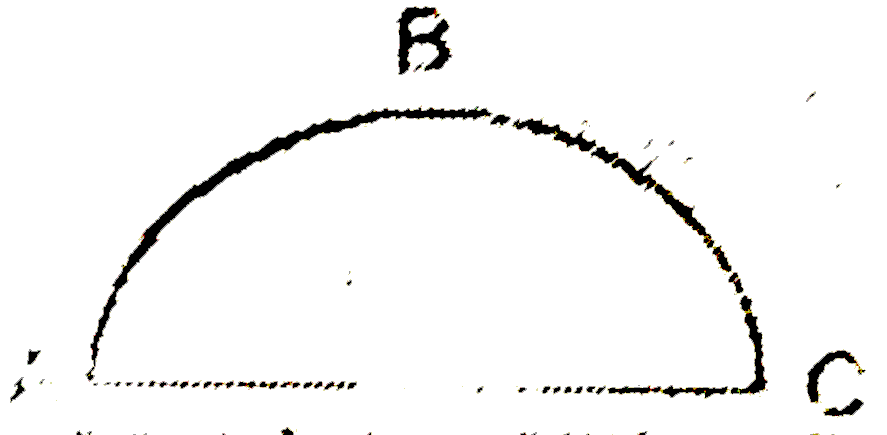

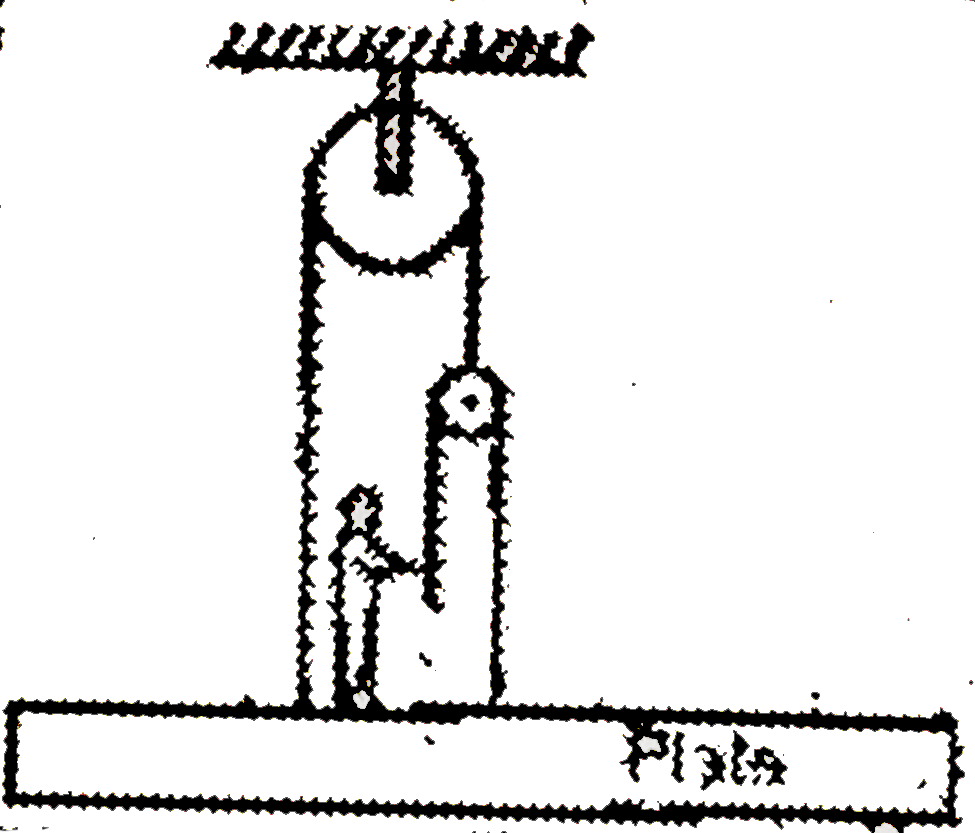


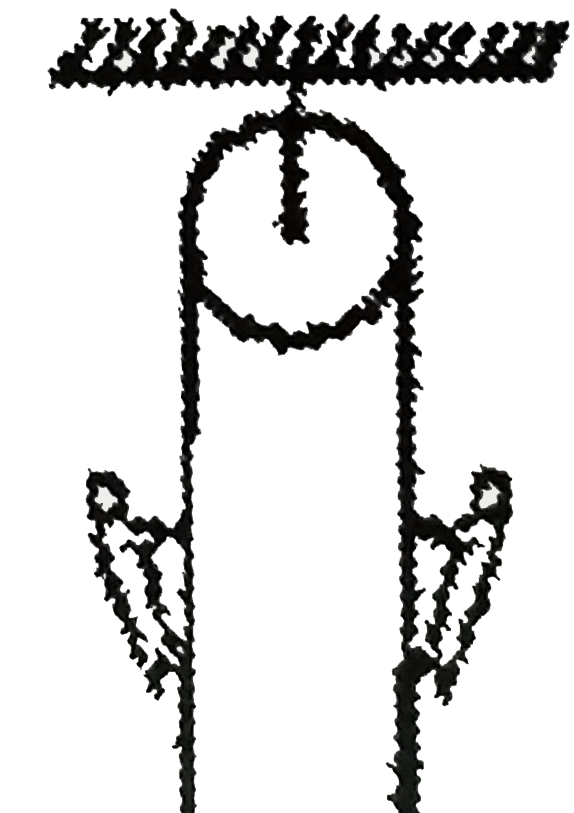
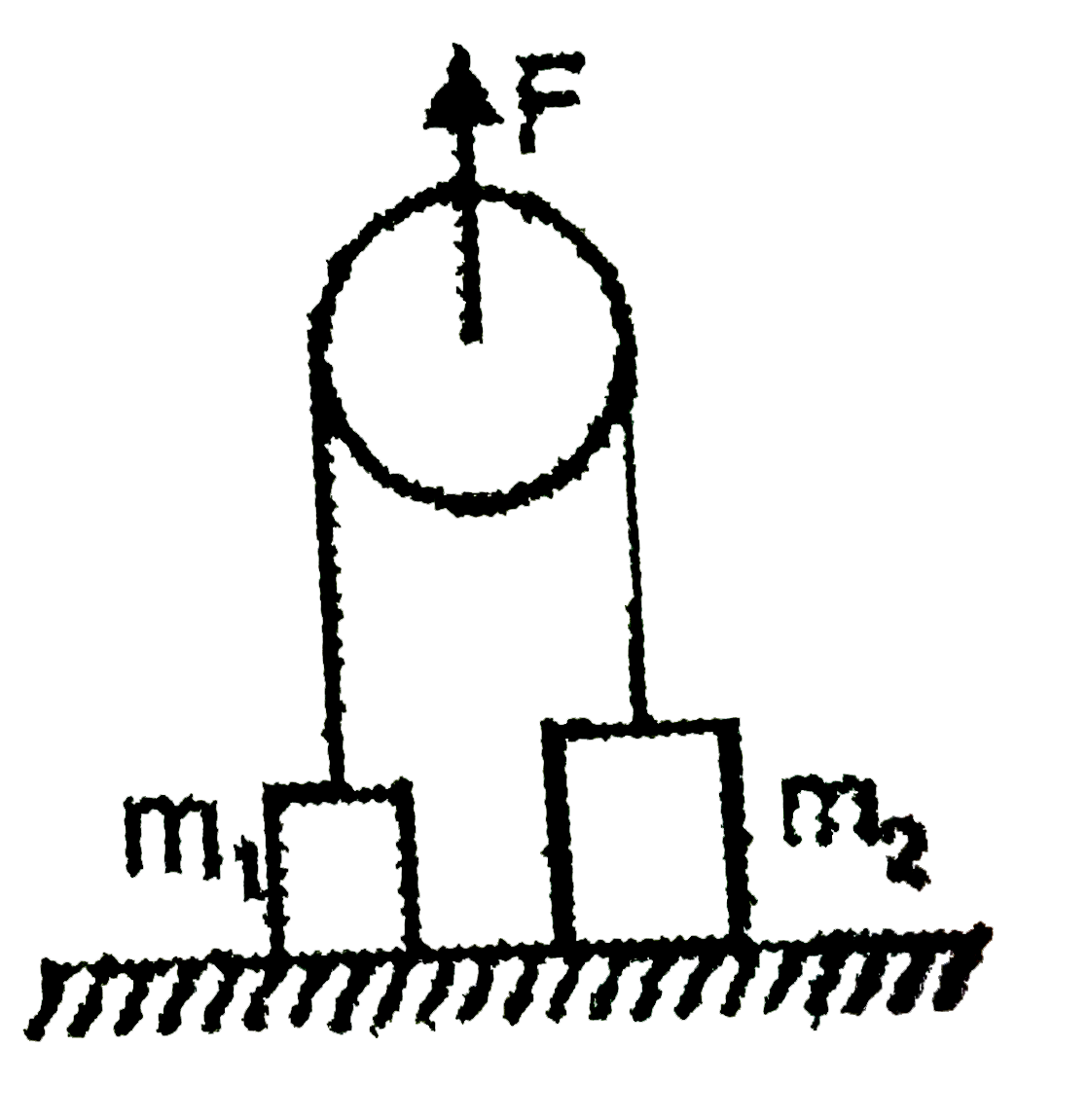
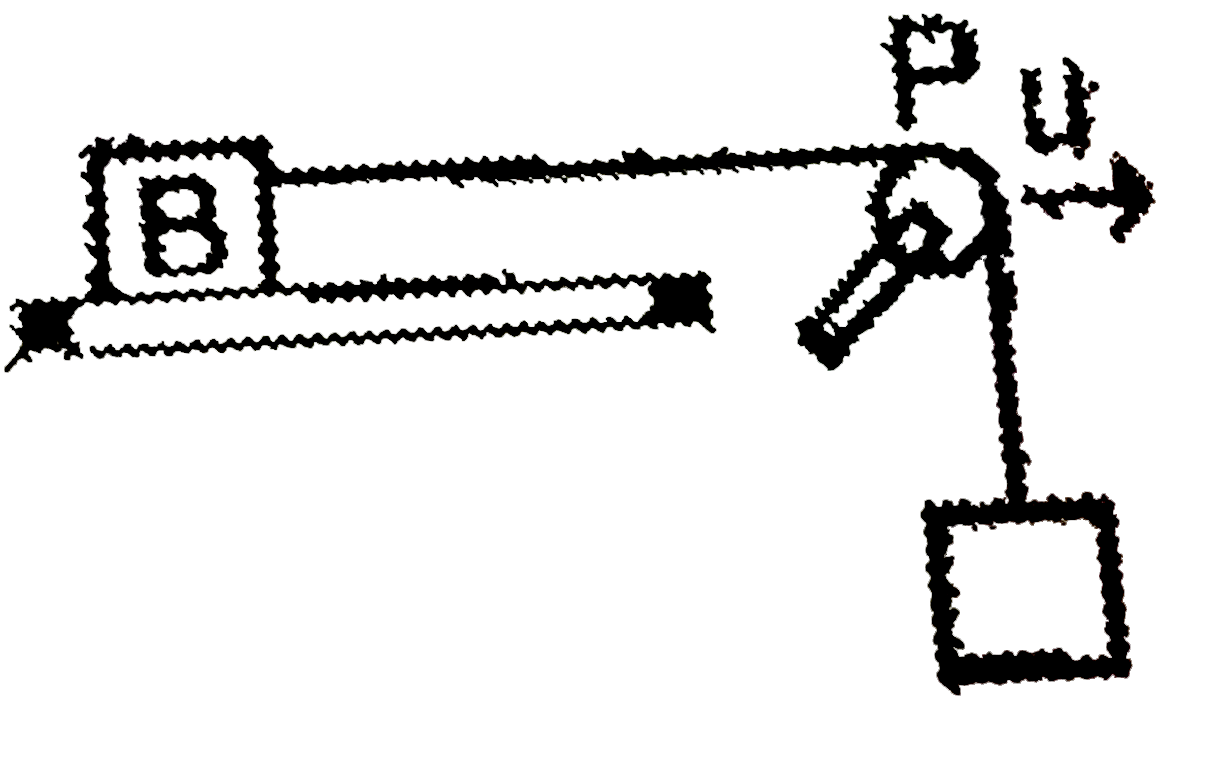
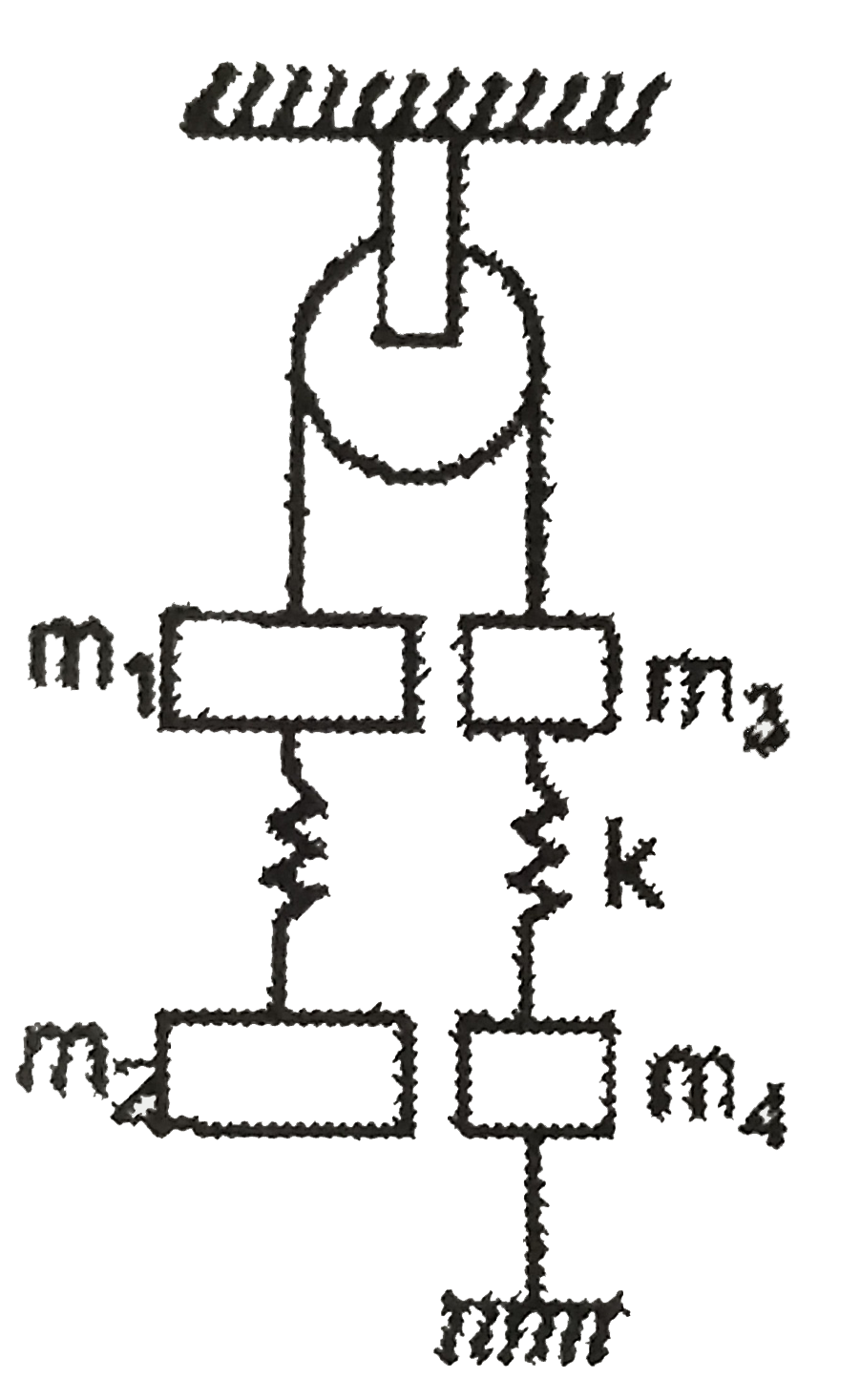

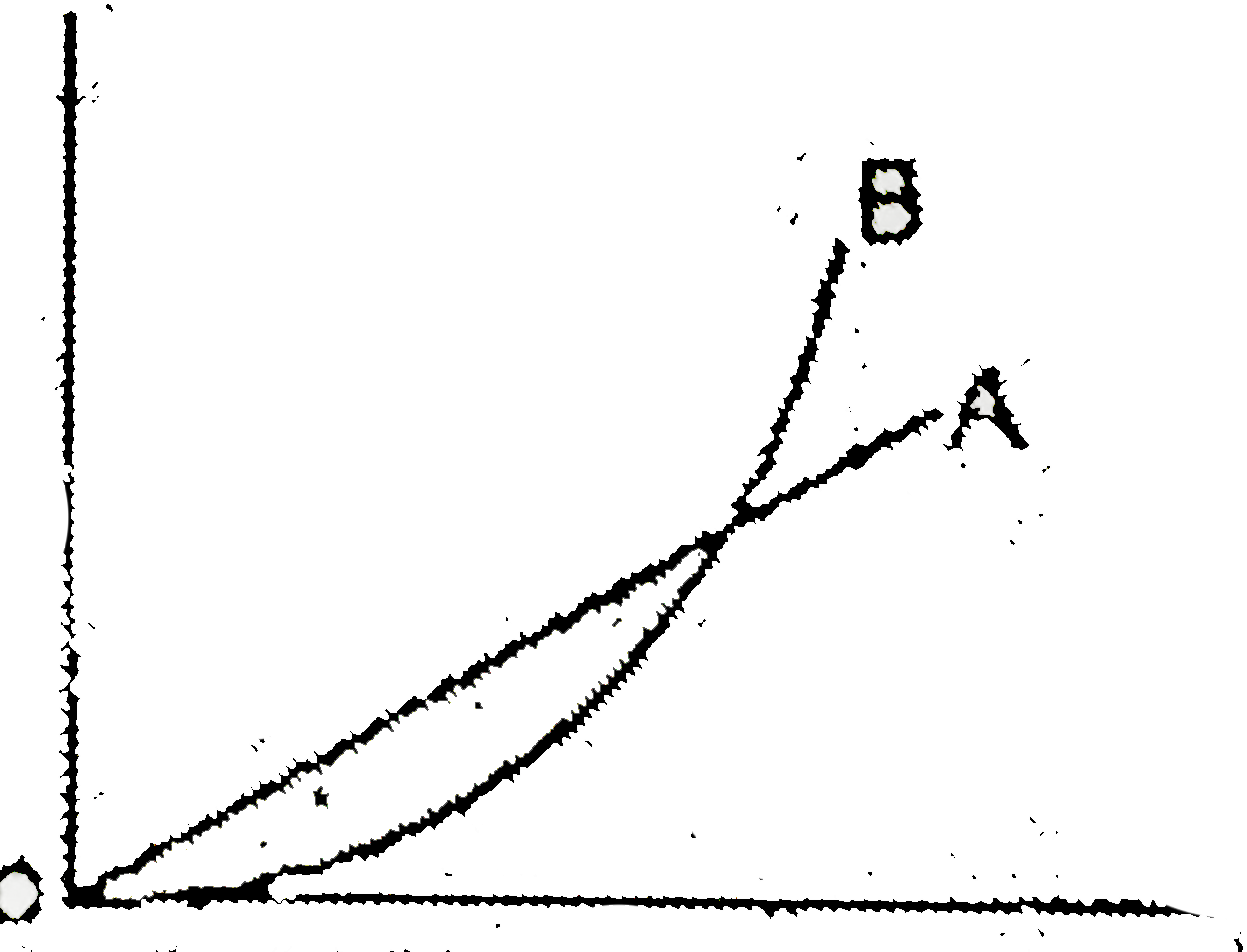

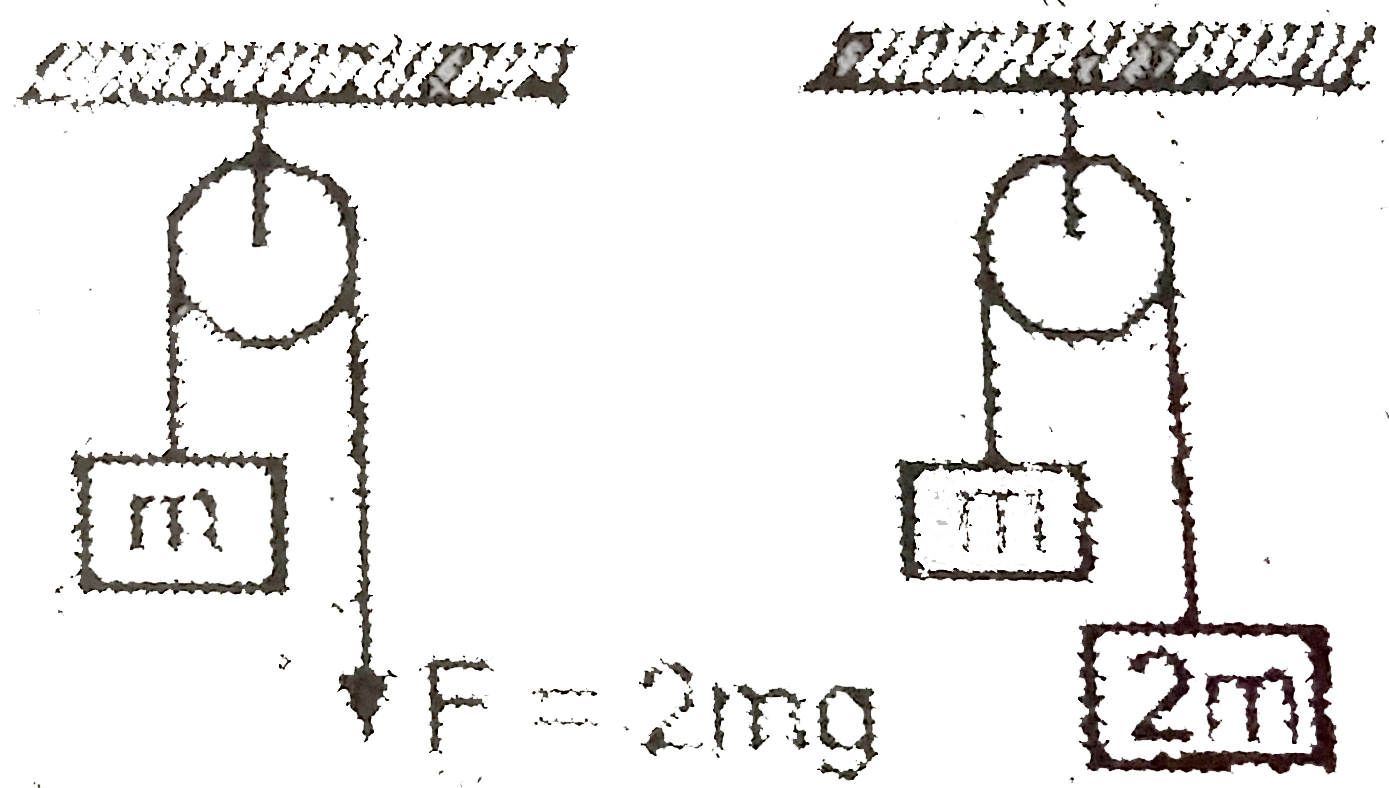
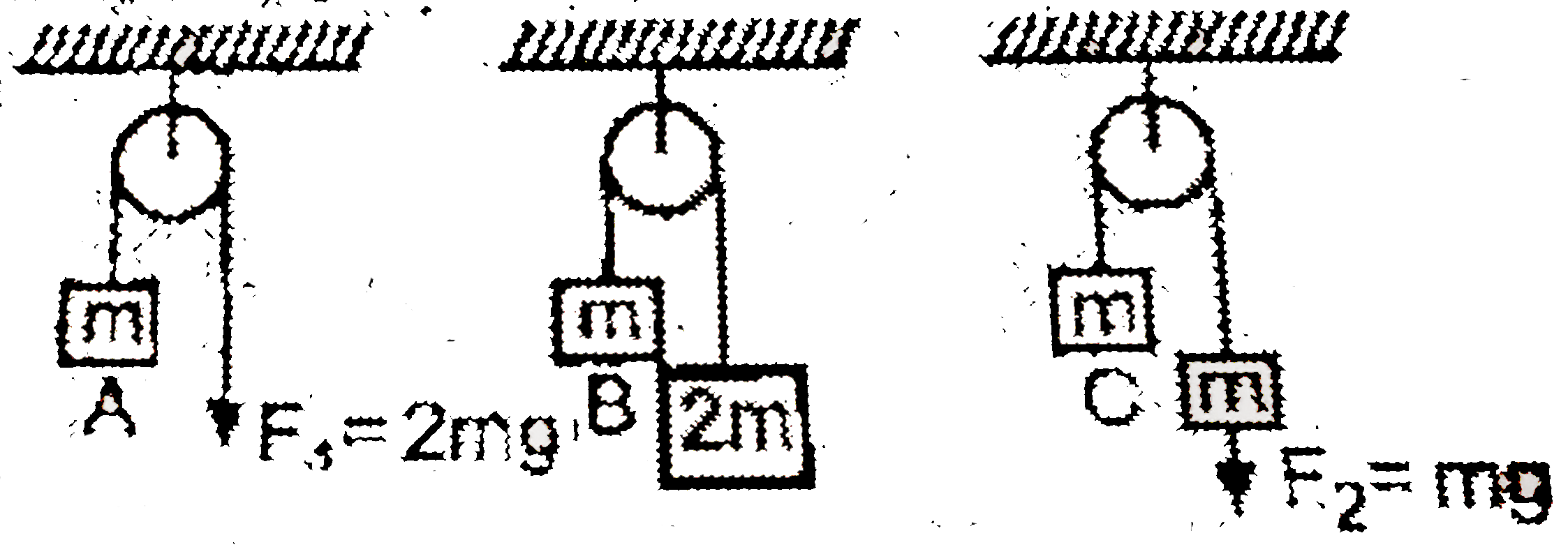
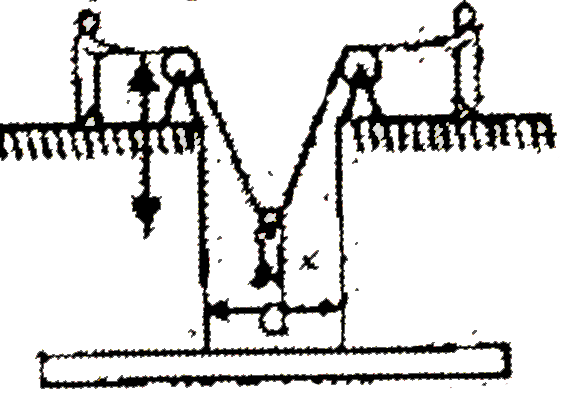

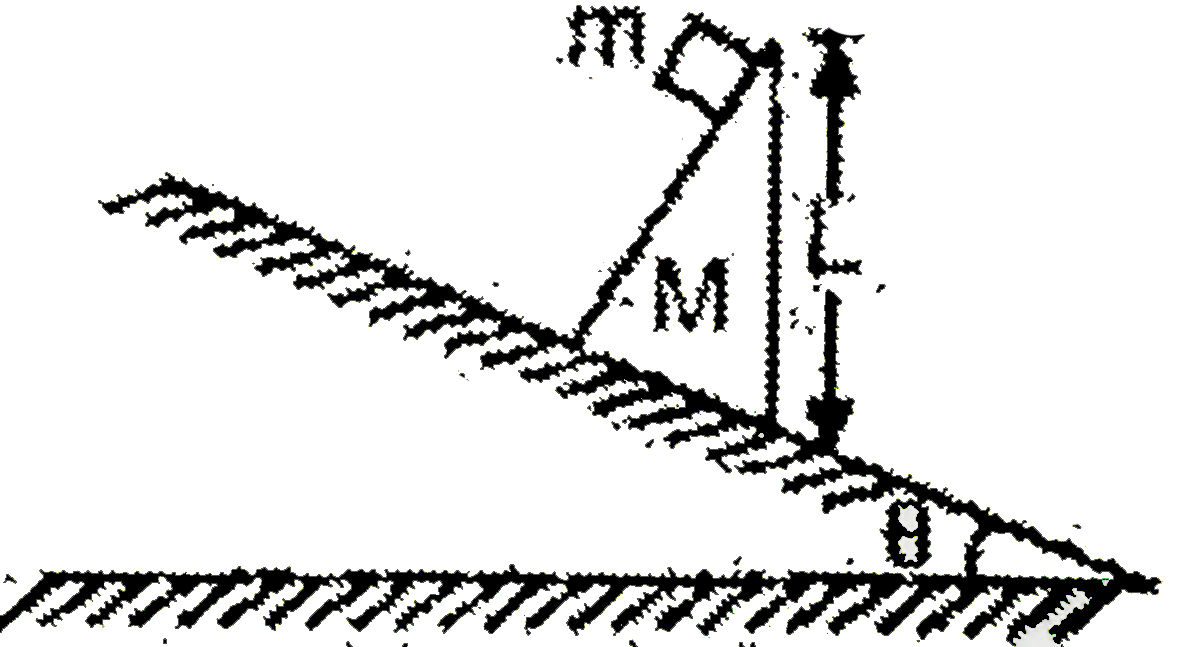
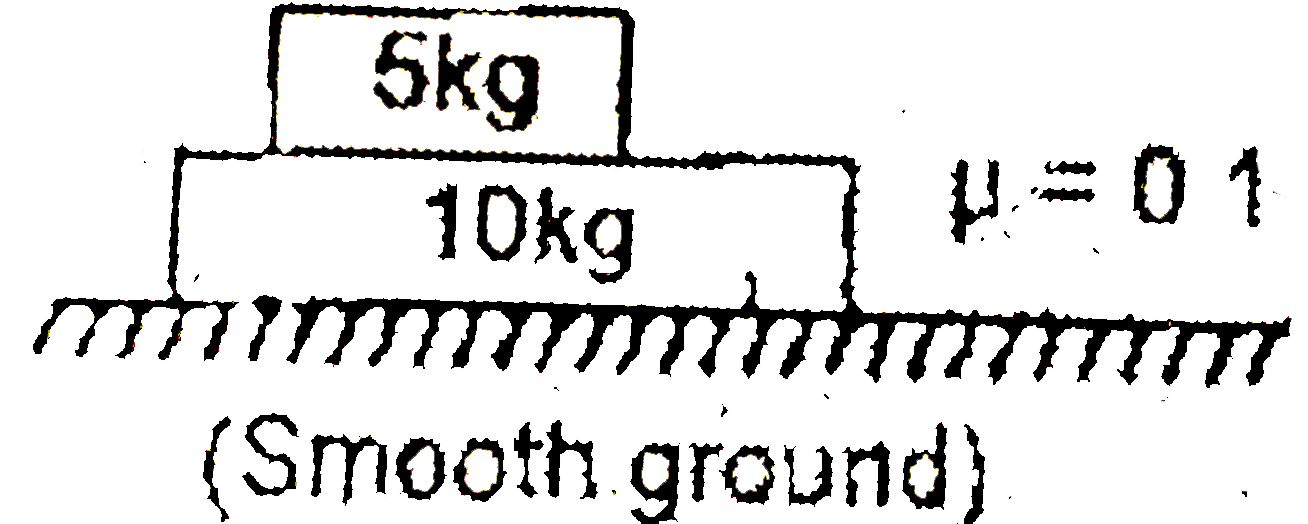
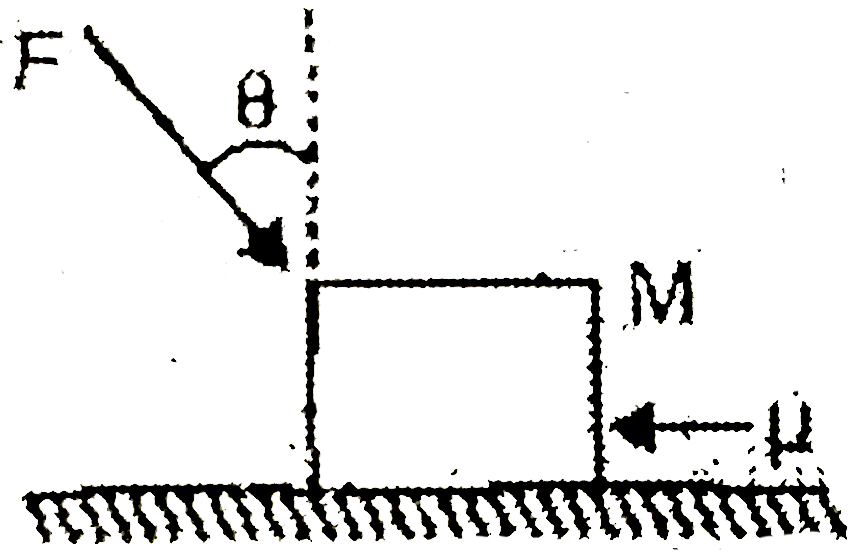
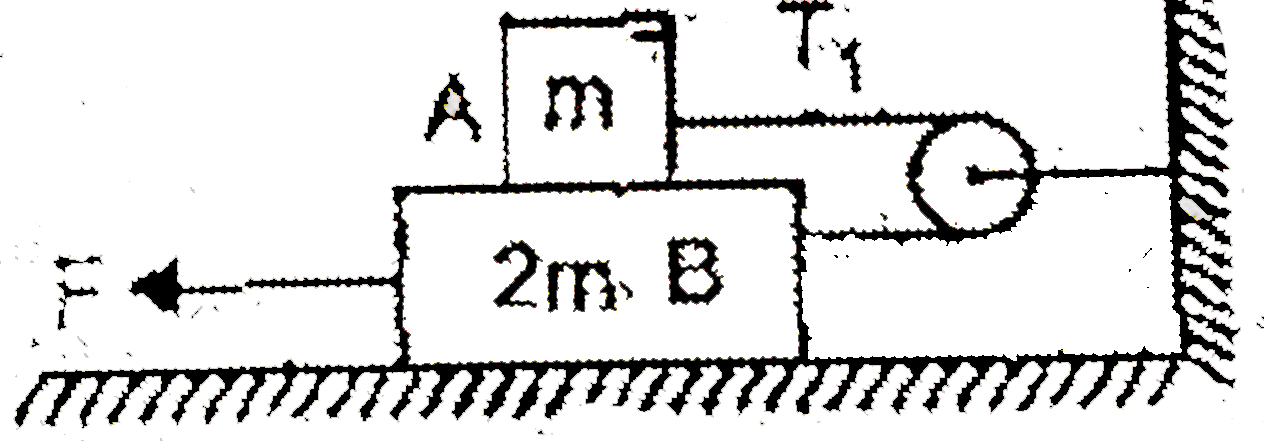
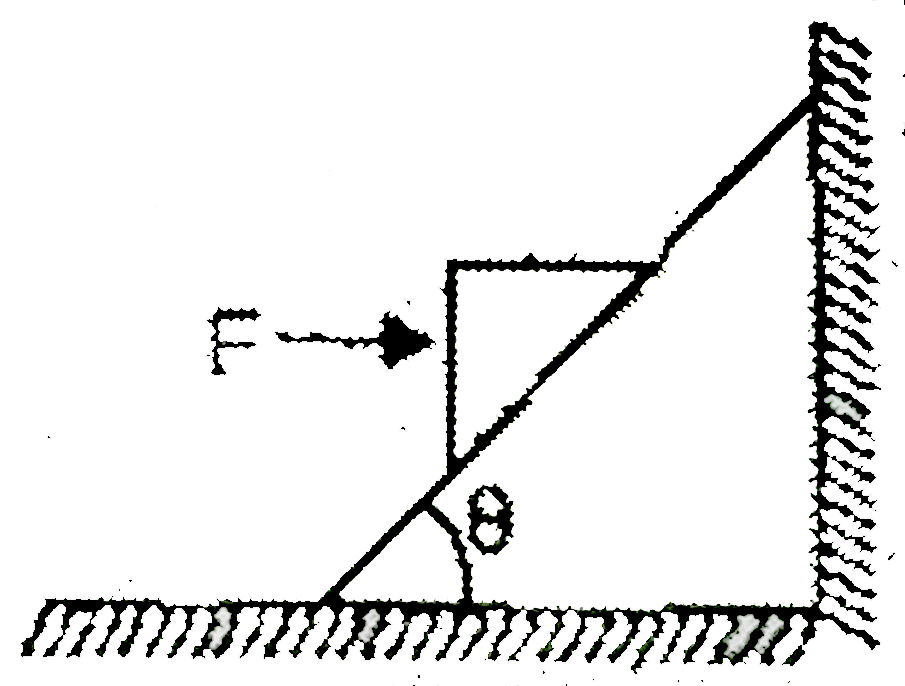
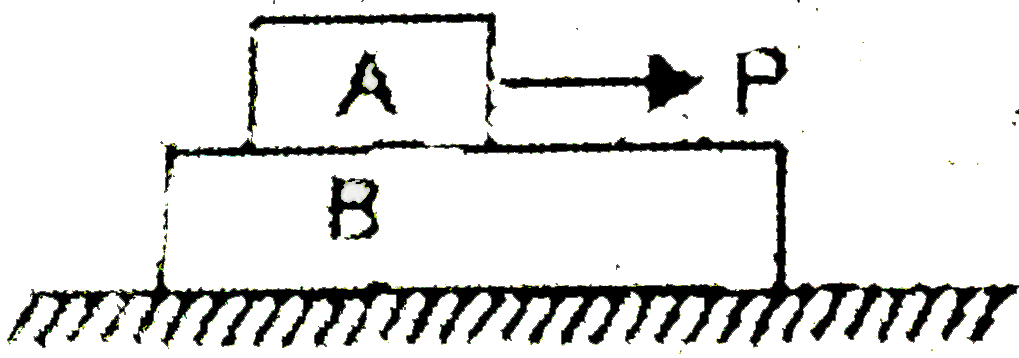
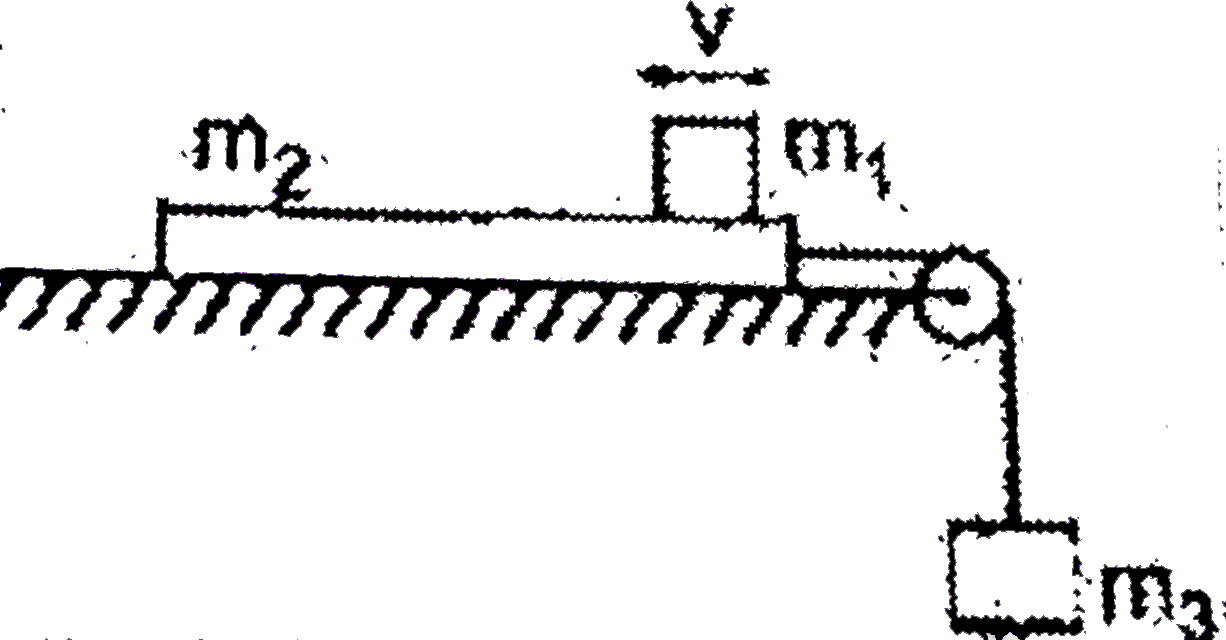
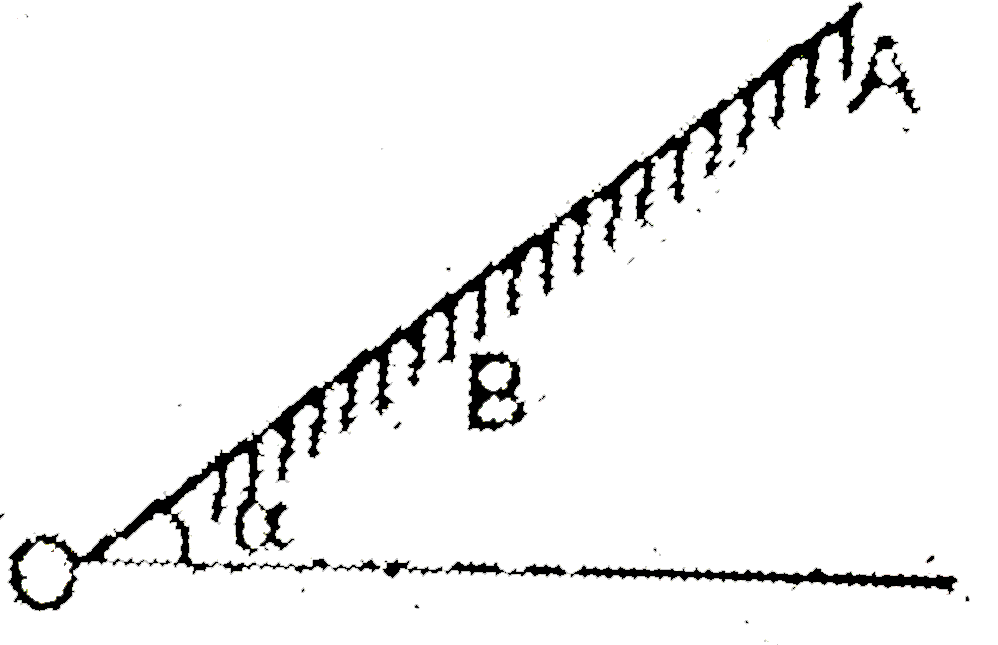

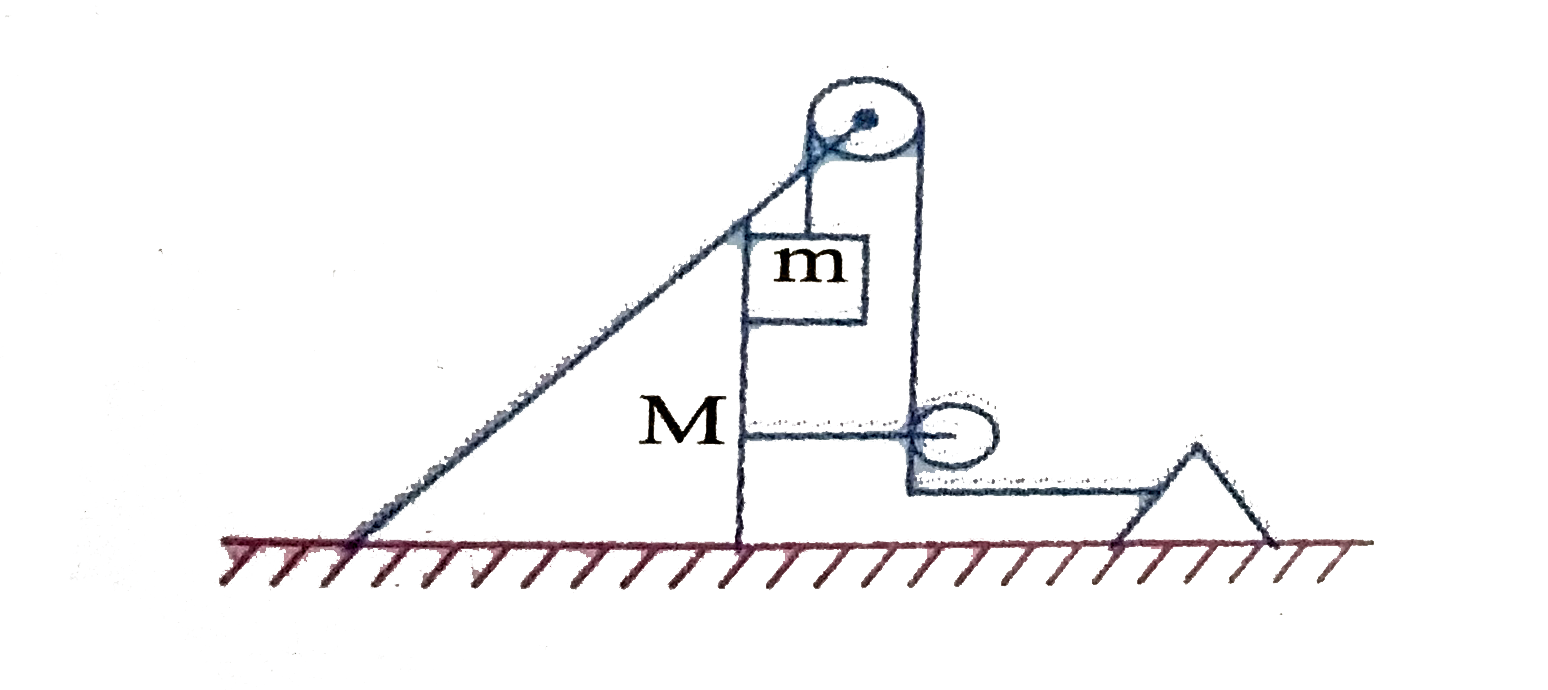
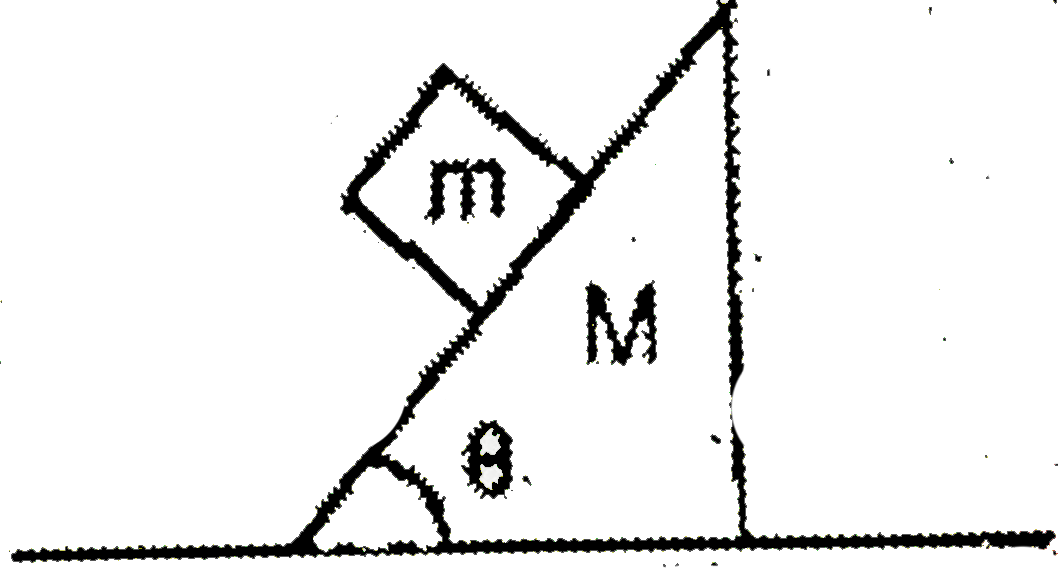
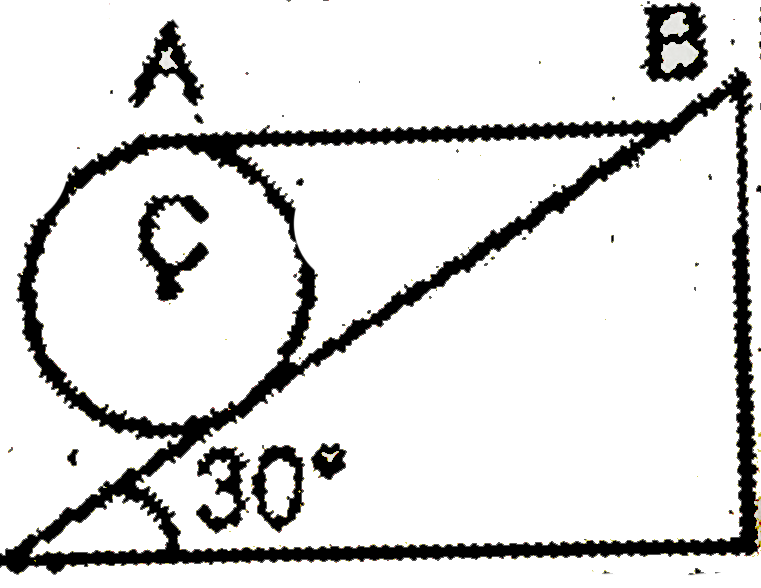
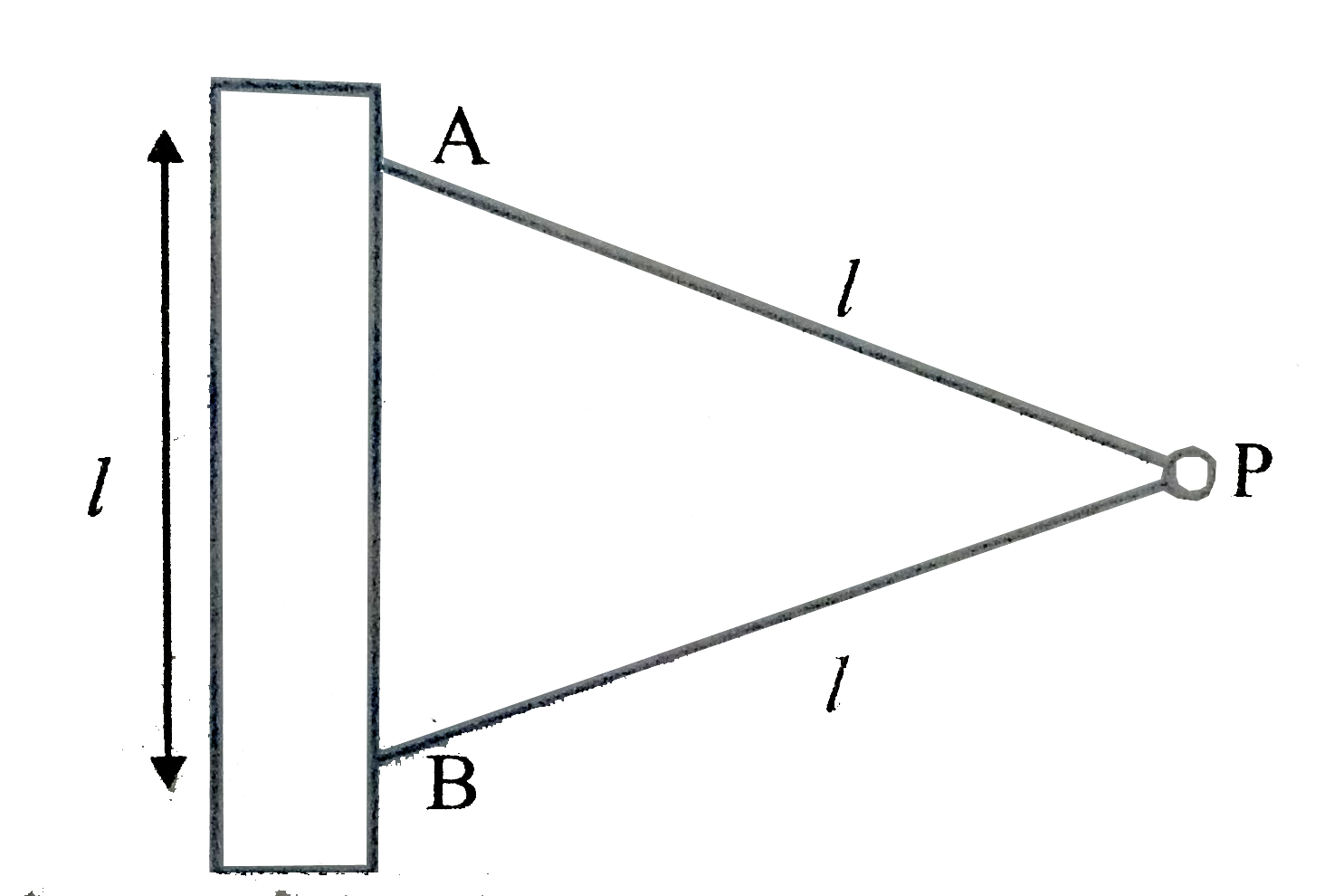
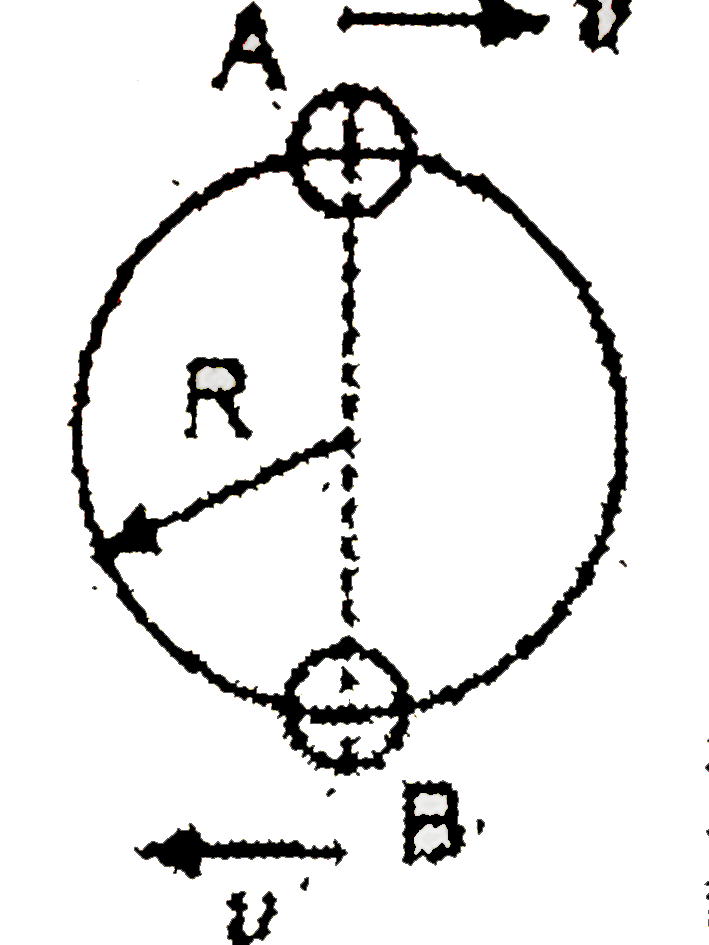

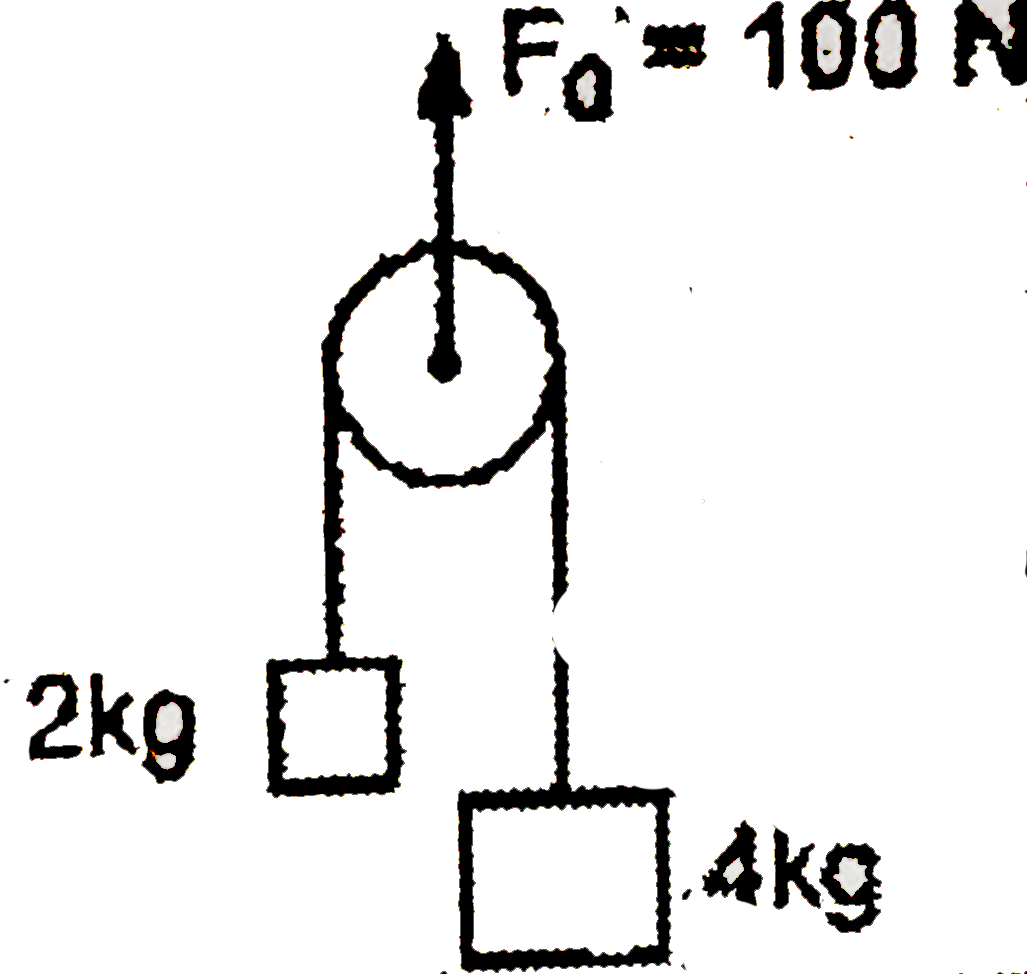

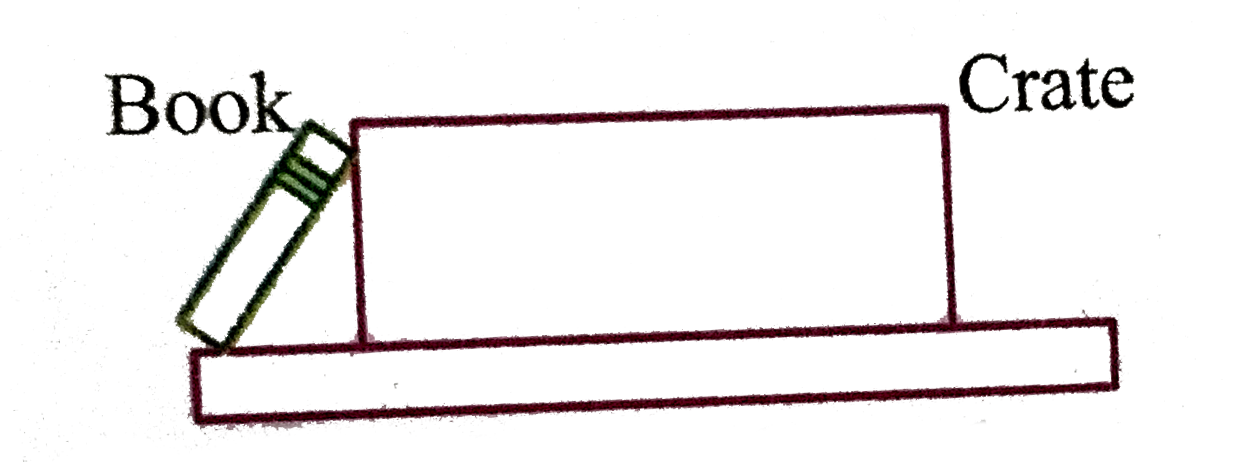 .
.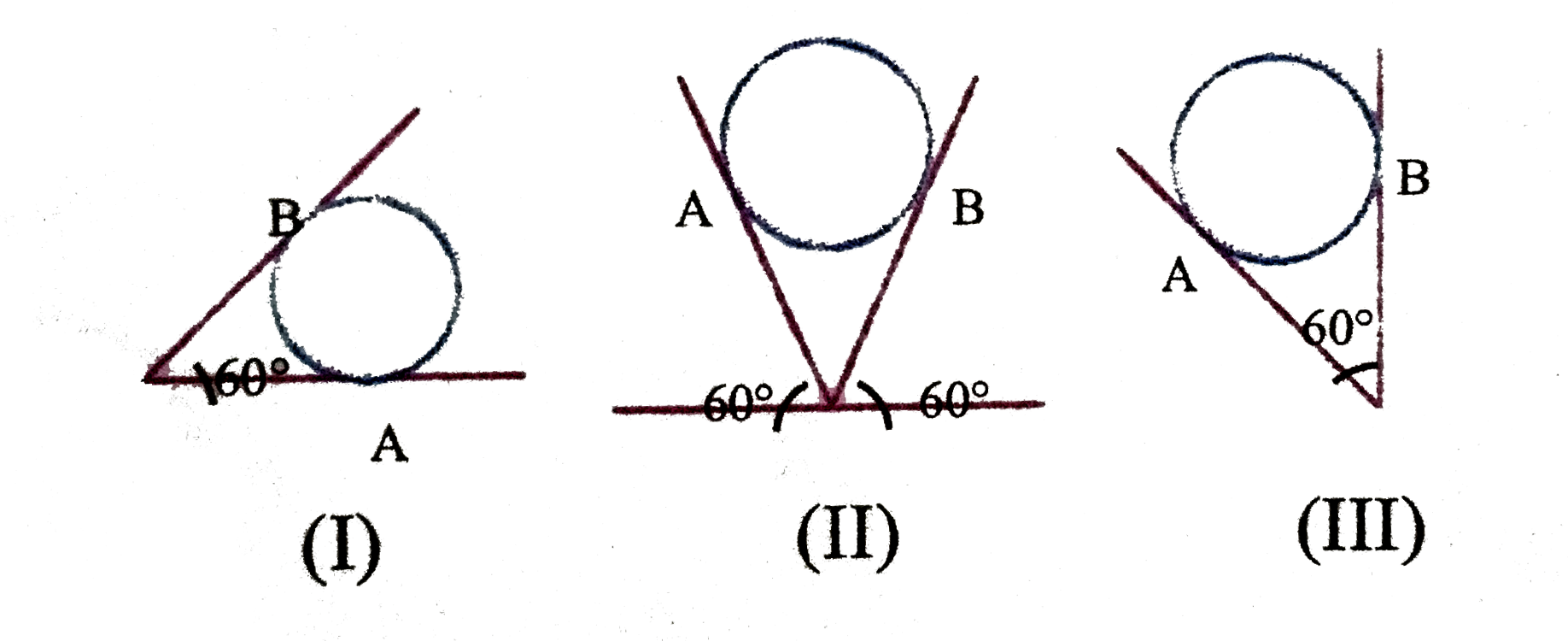 .
.